Rickubis
Bird Page #3a:
Anhingas
This page was born (split off
from 11/11/2008) page 6/24/2020. Rickubis designed
it. (such as it is.) Last update: 03/30/2025
Images and contents on this page
copyright ©2002-2025 Richard M. Dashnau
Go
back to my home page, Welcome to rickubis.com
Go back to the RICKUBISCAM
page.
----------------------------------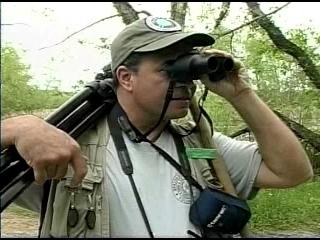
That's
me
on a trail at Brazos Bend State Park (BBSP), sometime in 2004. One of my
first experiences there involved this really odd black bird with a pointy
beak. I was walking
one of the trails, and as I scanned the view, I saw (but didn't really
note) this bird on a log in the water off to my right. I had just turned
away when I heard a soft "ploop!", a quiet
splash. When I turned back, the bird was gone. I walked slowly along the
trail, scanning the water for reptiles, or other movement. From time to
time I'd catch a glimpse of
something which poked out of the water, and then submerged, but it
happened so quickly-and always at the edge of my vision-that I thought it
was perhaps an illusion. This
happened for some time as I walked. Finally, I caught the movement soon
enough to look at it directly, and caught just a glimpse of black and
yellow submerging.
'Was that...a bird!?' I thought. Apparently the danged thing had been
going in my direction, sort of following me (which was why I kept seeing
it out of the corner of my eye.)
I stopped an scanned my surroundings again. I looked from left to right,
turning slowly. Then, I looked from right to left...and there, on a stick
in the water, was that large black bird.
It hadn't been there just a second ago. If I didn't know better, I'd
swear that bird had been fooling with me. Who knows? Maybe it was.
The bird was an Anhinga, and I've been fascinated by them since.
Oldest entries start at the bottom of the page.
03/02/2025
When I
got to the Brazos Bend State Park at
8am, was already a fine day but
after a while it got really
interesting. After many other
events,
this
Anhinga (Anhinga
anhinga)
kept basking
on this stick
next to the
bank, next to
the short
wooden bridge.
I watched it
for a while,
and it bent
over and
slipped under
the water.
I thought it
would start
hunting, so I
watched for
the Anhinga's
head and neck
to
surface--hopefully
with a fish
impaled on its
beak. A
few park
Visitors had
come over to
see the
Anhinga and
had also seen
it dive. We
all looked for
the
Anhinga.
This male
Anhinga has
more color
than usual
(such as the
blue around
the eyes),
since it will
be courting
soon. The
last
image below
shows the tiny
serrations on
the front half
of the
Anhinga's beak
which help
prevent
impaled fishes
from sliding
off too
easily.
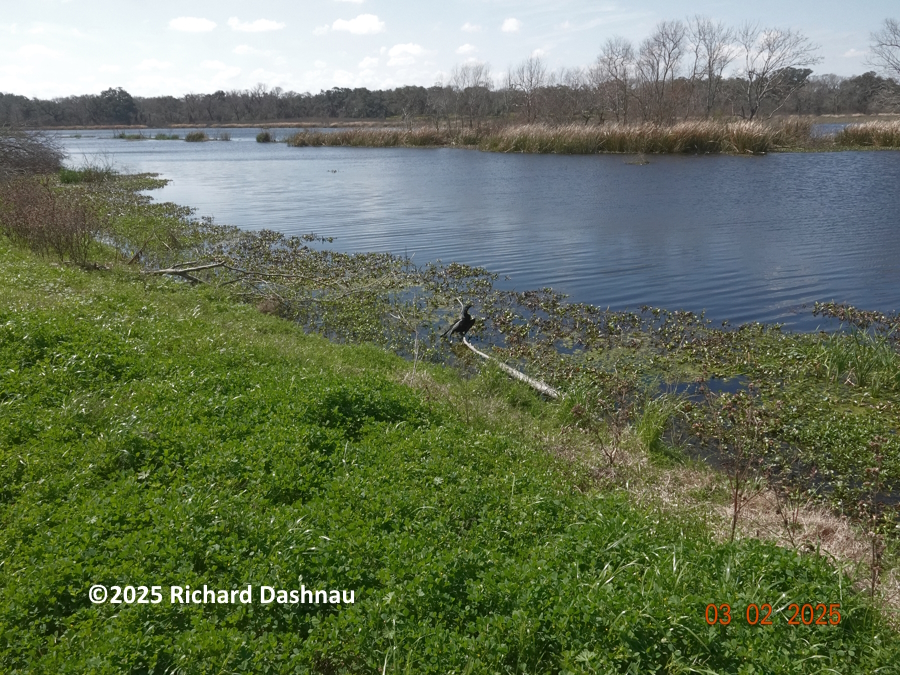
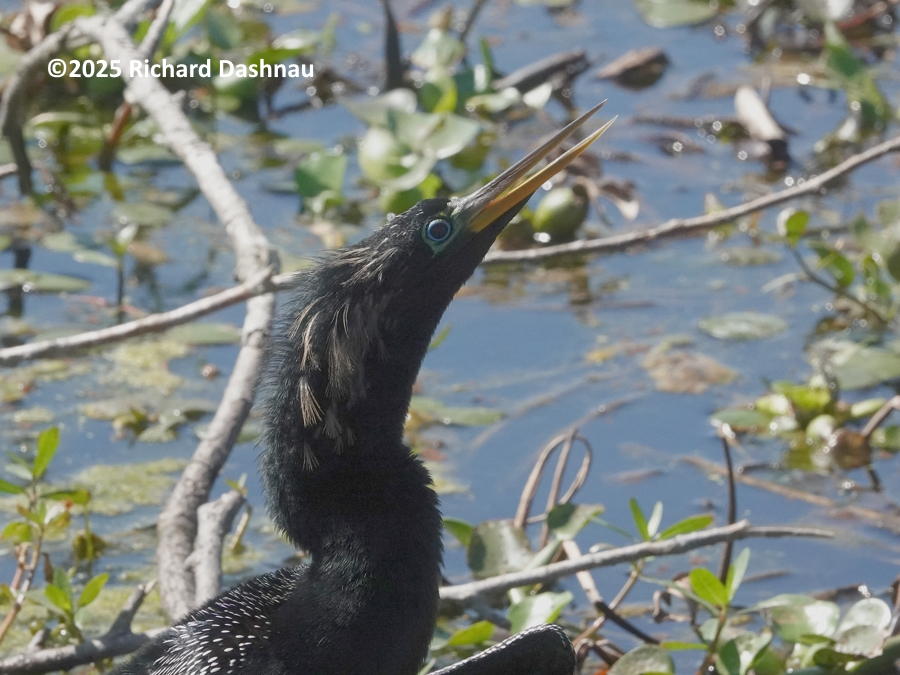
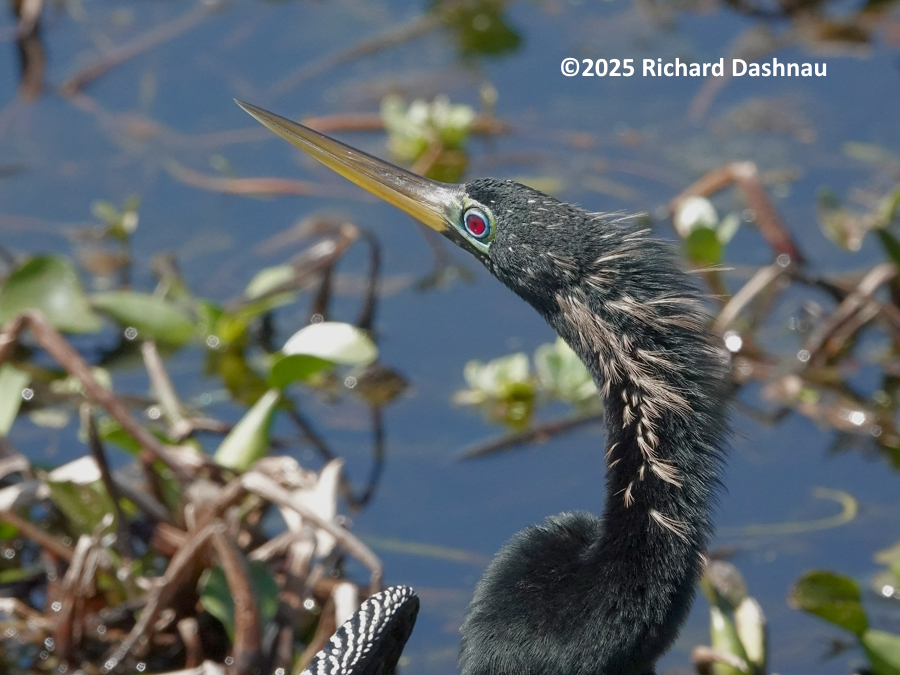
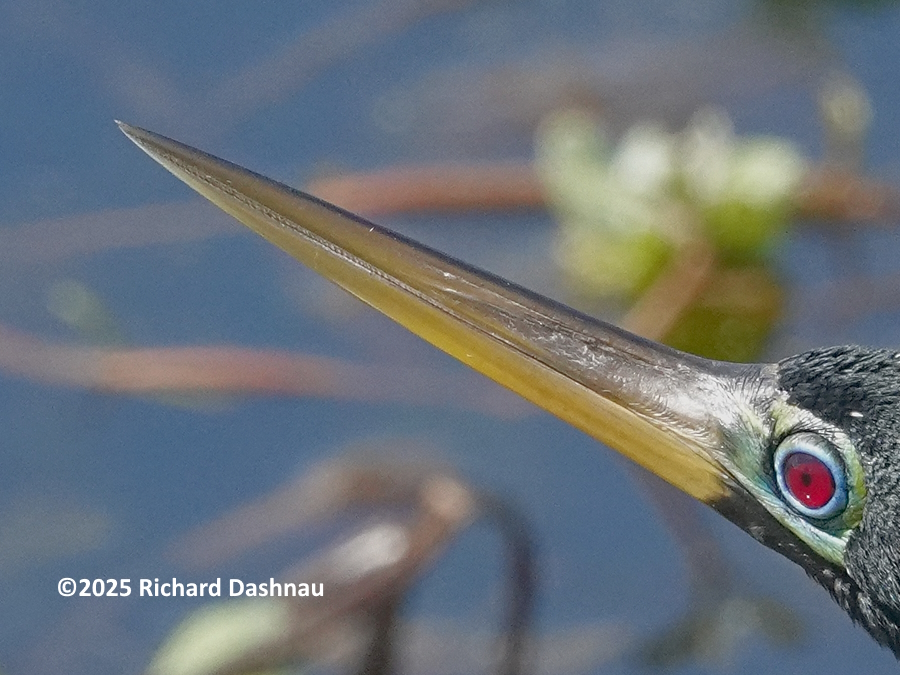
I
was looking in
the wrong
direction when
it surfaced
with a fish
and swallowed
it, so just
caught the
ending. But we
all kept
watching for
it, with no
idea where it
would pop up
next.
Some
folks sitting
on the
bench under
the Oak Tree
were surprised
when it
surfaced right
in front of
them--again, I
was too slow,
but I think it
had had a
fish. It was
fun seeing the
surprise from
various park
Visitors as
the Anhinga's
head and neck
popped up in
front of them,
then slipped
back under
without a
ripple. The
Anhinga stayed
in the area,
foraging in
that
corner of
40-Acre Lake
until it swam
back to that
stick. Then it
climbed out of
the water and
opened its
wings to heat
itself. The
first image
below shows
how much
the wind was
wrinkling the
surface of the
water. The
Anhinga was
scratching its
neck in the
last image.
More about
Anhingas on my
Anhinga page.
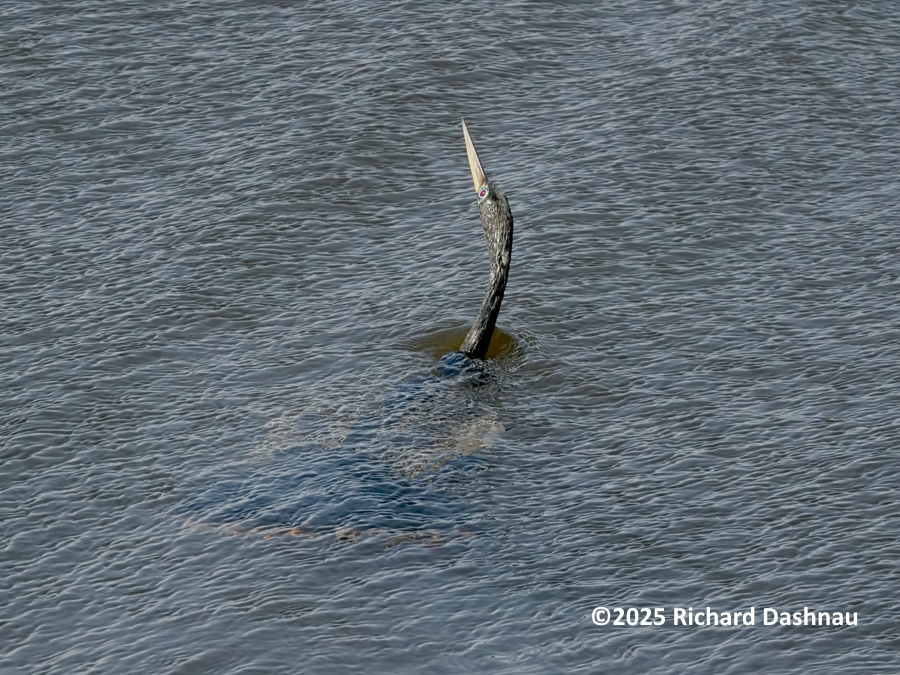

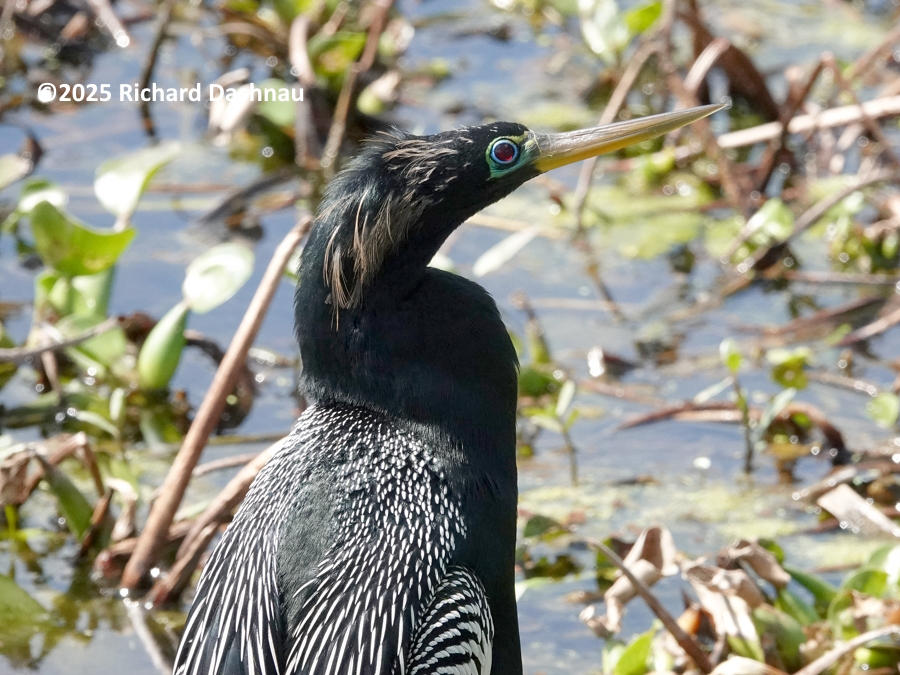
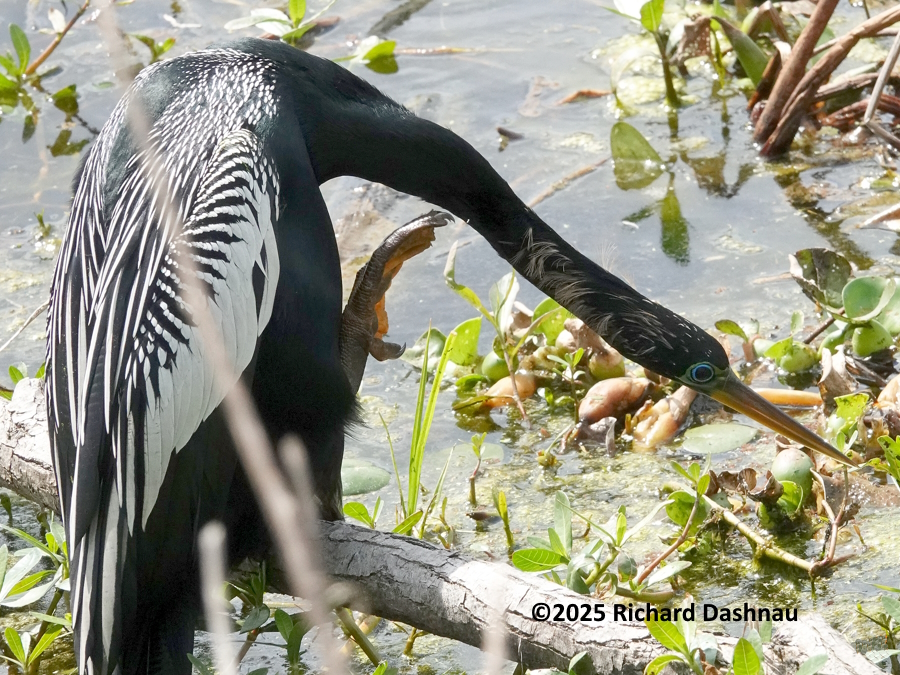
12/22/2024
The morning was a bit cool at Brazos Bend
State park, but a few alligators started moving in Elm Lake around
9am.
I
saw this
Anhinga in
40Acre Lake in
the afternoon.
The last 3 dry
summers
(although
2024's wasn't
quite as bad)
and Hurricane
Beryl really
knocked down a
lot of the
trees
and bushes in
the areas
around the
lakes. I've
noticed more
Anhingas
standing on
low growths to
get out of the
water for
their
thermoregulatory
activities.
Usually they
prefer
branches
much
higher.
This one was
also calling
and it took
off to
challenge
another
Anhinga that
it had been
calling to
before I was
ready with the
camera.
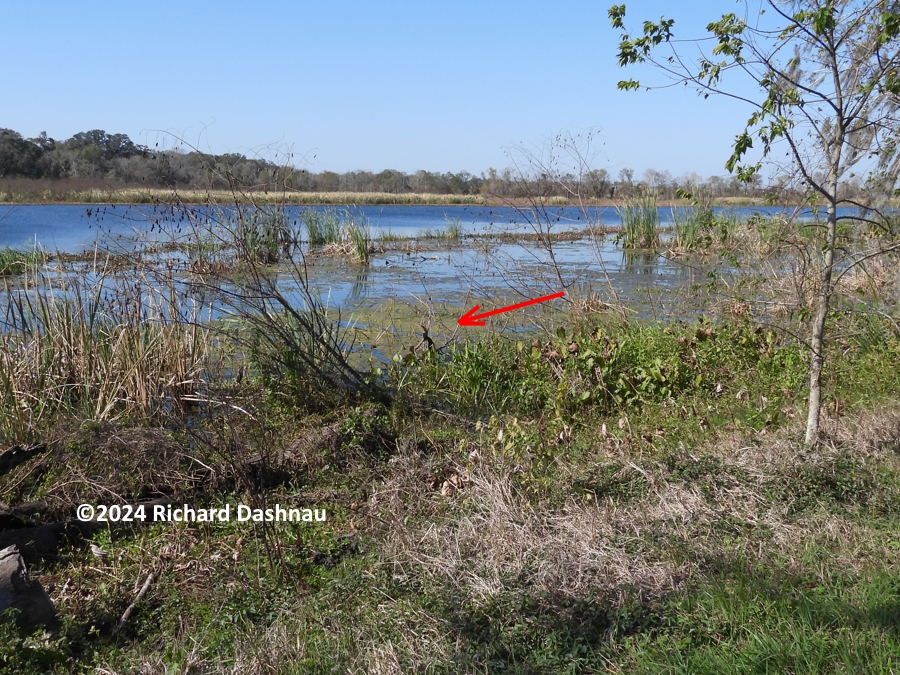
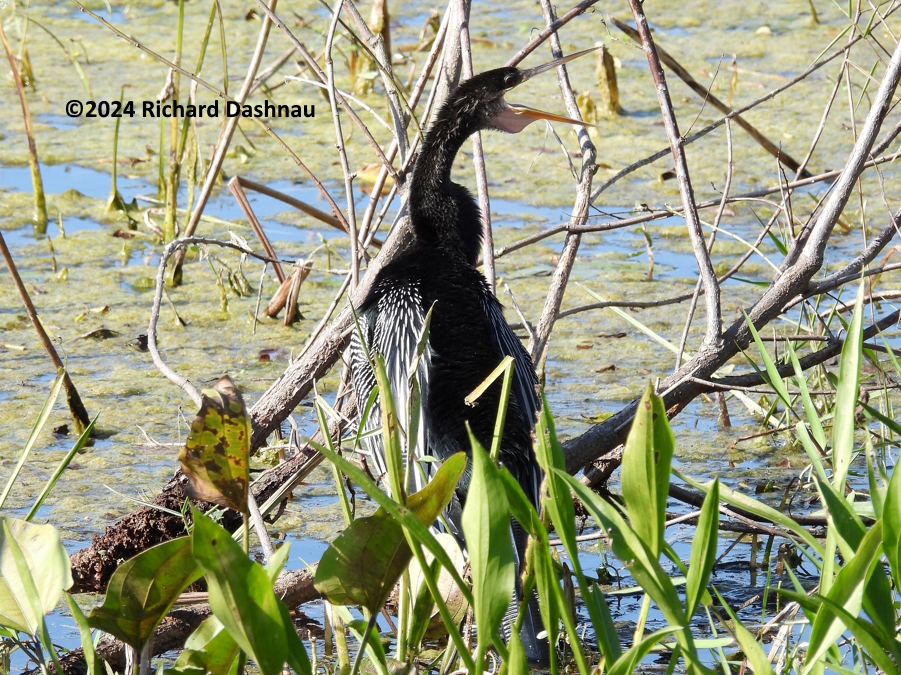
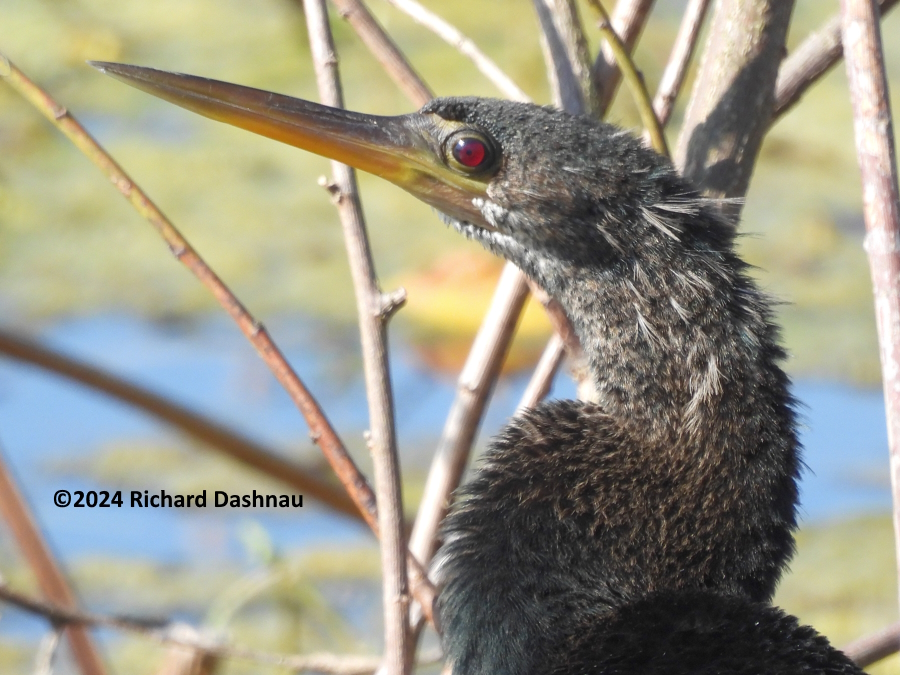
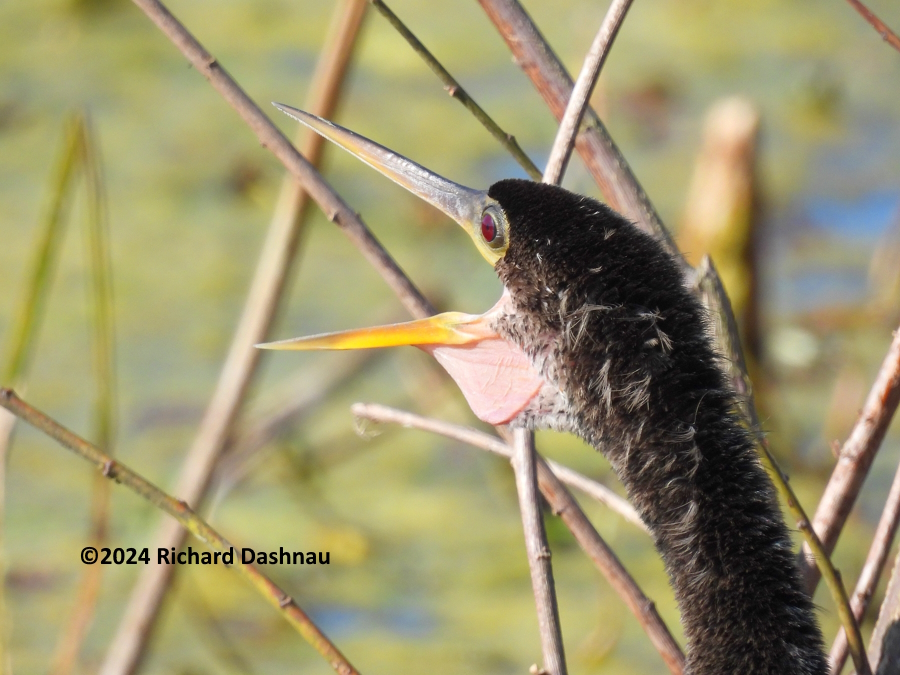
As
I often do
when I get a
chance for a
closer photo
of an Anhinga,
I tried to get
some detail of
the fine
grouping of
backward-pointing
bristles, or
barbs at the
top of the
beak. They are
supposed to
prevent prey
from sliding
easily off the
beak. These
two images are
just cropped
from the 4th
image above.
Sometimes
these barbs
seem to work a
little too
well. Examples
of Anhingas
feeding are on
my Anhinga
page. Or,
go straight to
this video
demonstrating
the function
of an
Anhinga's
beak, from
2022, and
this 2011
video of an
Anhinga
hunting.

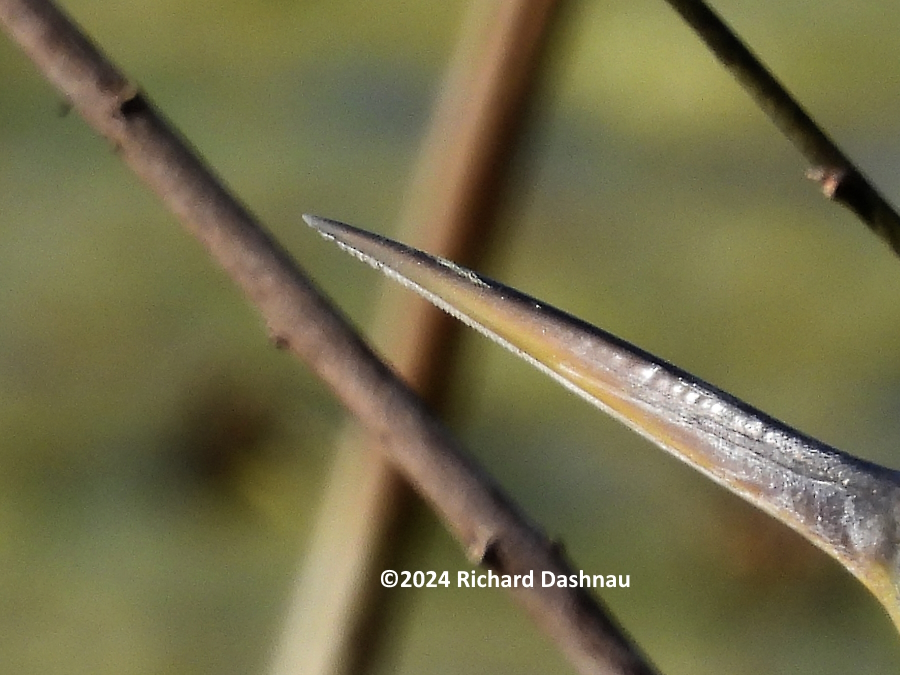
02/06/2022,
04/03/2022 and 07/03/2022. There's always a
lot to see at BBSP. I always notice Anhingas, but I
don't always stop to watch them. Earlier this
year, I saw a few Anhingas
with prey, and then got another chance to capture detail of an
Anhinga's face. Together, the images can demonstrate an
interesting feature of an Anhinga's beak. I've put this all
into a short video
presentation, that is linked here.
On
02/06/2022, This Anhinga came out from this dense plant
growth to stand on a stump while it ate a fish it had caught.
I was East of the middle of the Spillway Trail, just past the
end of the
last dirt mound (which we've called Otter Island). I
believe the fish was a White Crappie (Pomoxis annularis). The
two images below are frames from the video clip.
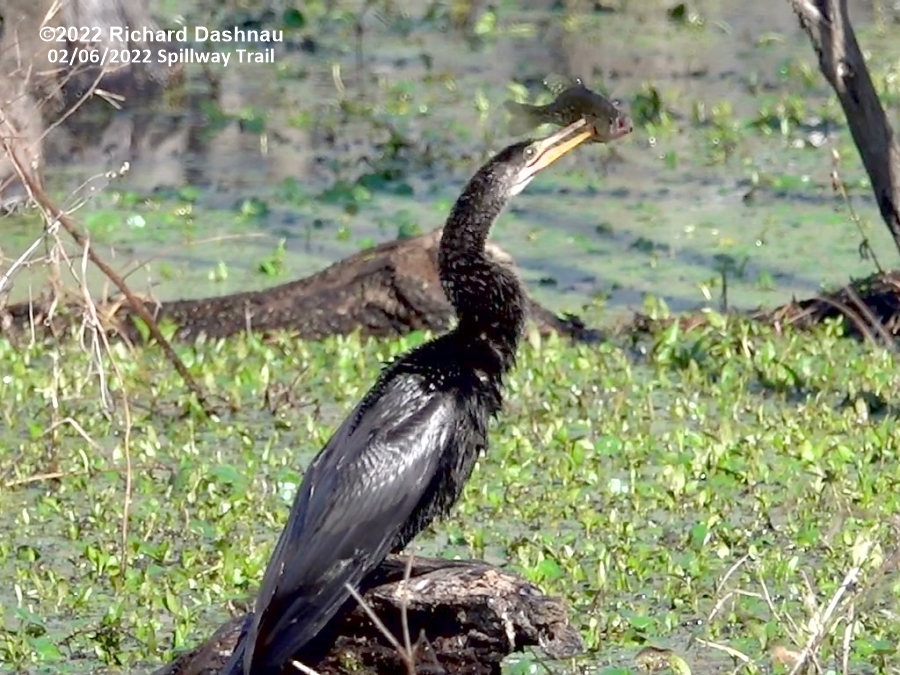
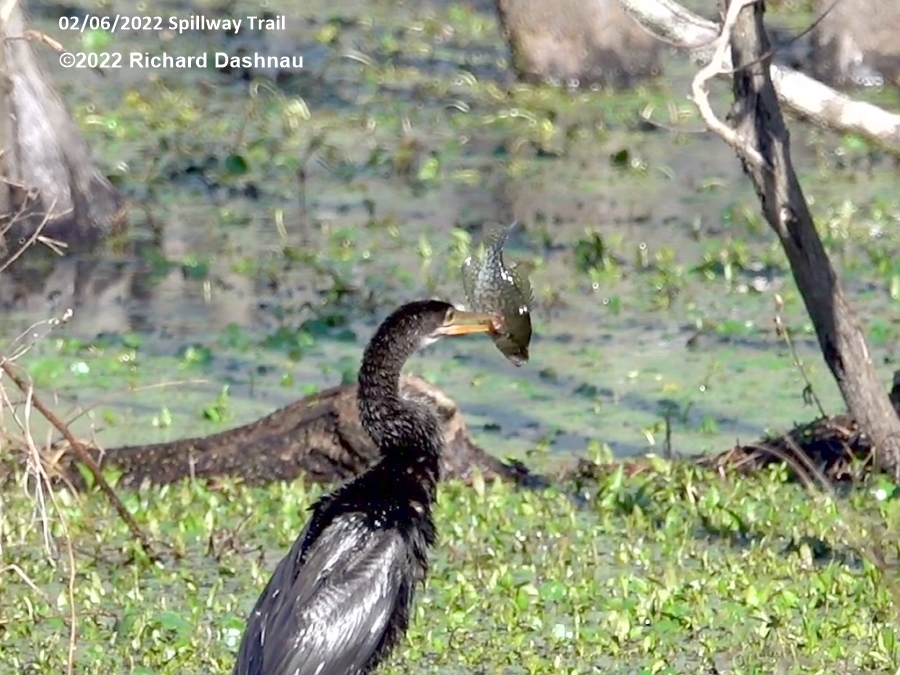
On
04/03/2022, Anhinga were foraging in Elm Lake came out
from this dense plant growth to stand on a stump while it ate
a fish it had caught. The two images below are
frames from the
video clip. I was on the West End of the lake, not too
far from the end of the Spillway Trail. The fish looks like a
Bluegill Sunfish (Lepomis macrochirus). An Anhinga
swimming with a fish
impaled on its beak, and then wrestling it off, tossing
and eating it--is one of my favorite sights at BBSP.
I've seen it many times, but seeing it close enough to get good clear photos
is a
rare situation. The images below are also frames from
video.
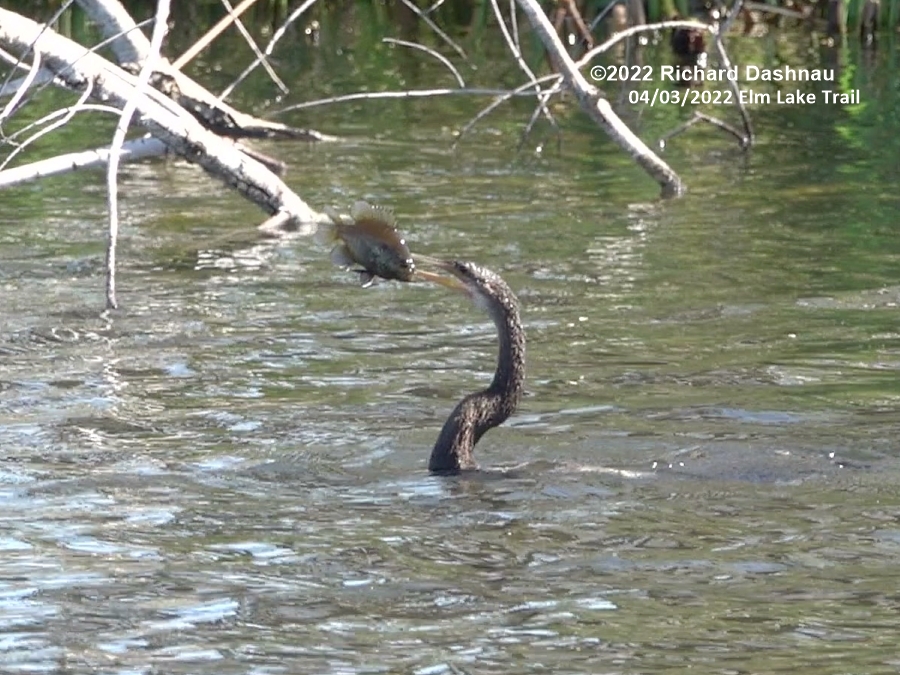
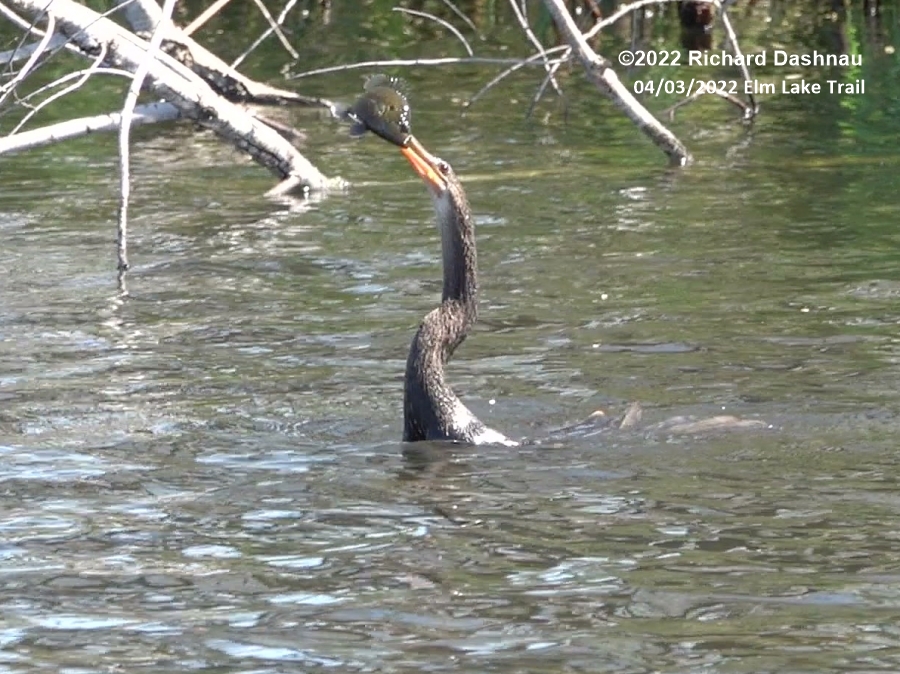
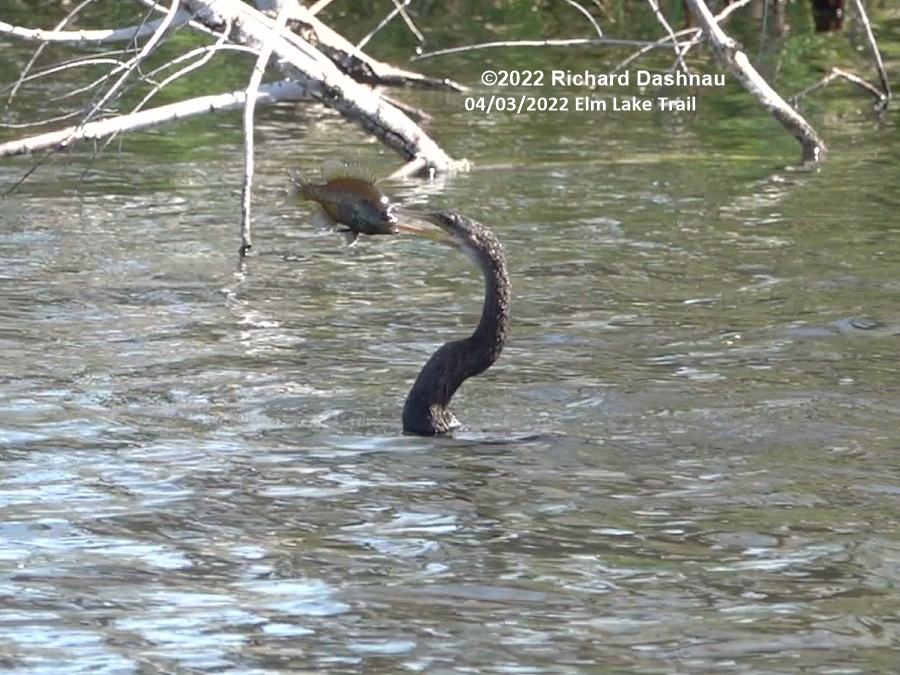
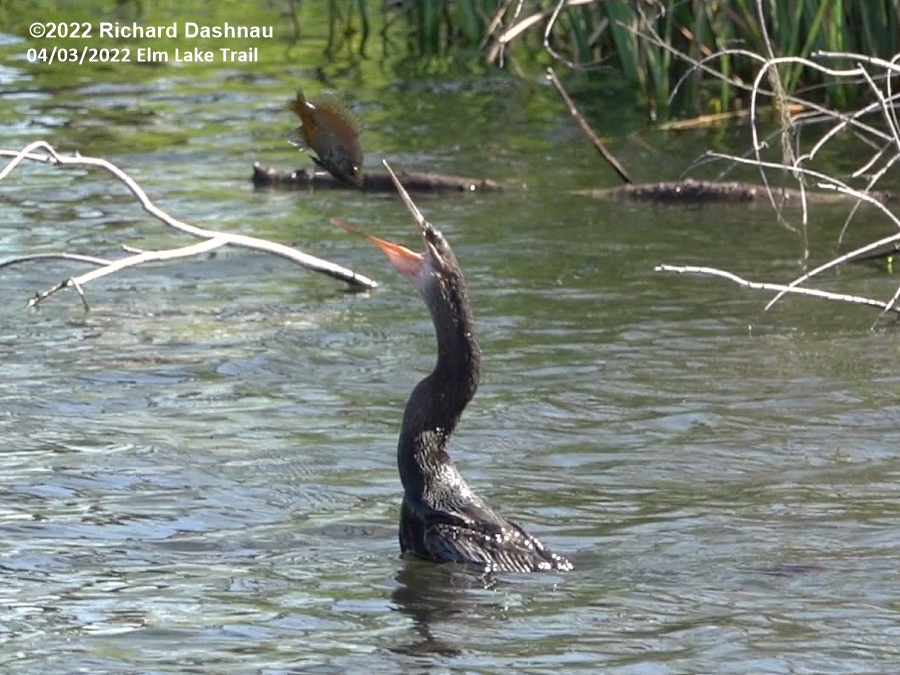
On
07/03/2022, Anhingas were foraging in Elm Lake, and I
could get some photos. They aren't as clear as I'd like, but
better than nothing. This time, I think the Anhinga has caught
a Redear
Sunfish
(Lepomis microlophus) (fish I.Ds are from the TPWD
website: https://tpwd.texas.gov/landwater/water/aquaticspecies/inland.phtml
) The images below are from photographs. They
show how far
the Anhinga's beak has gone into the fish.
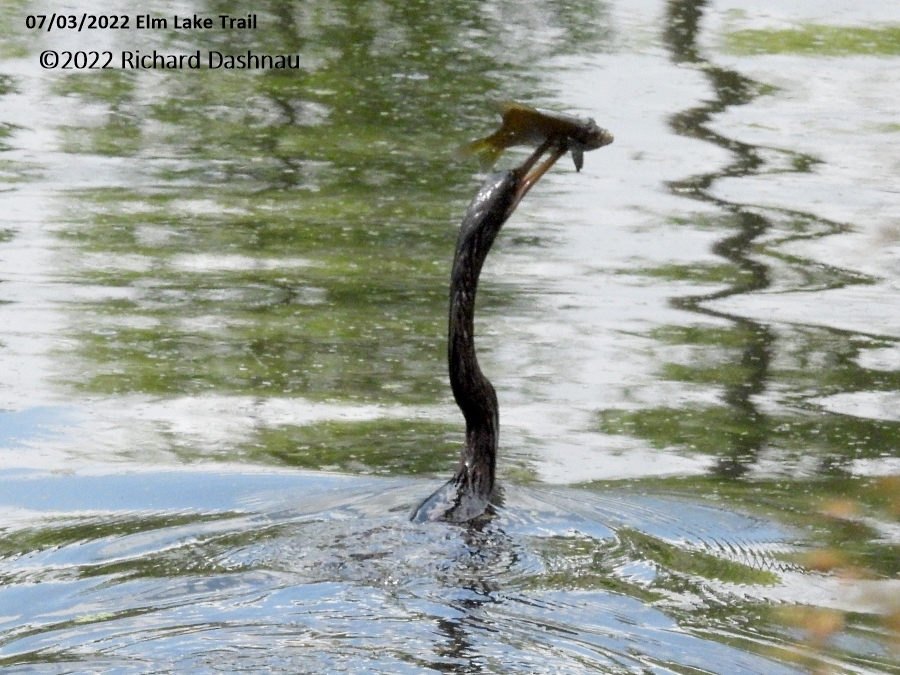
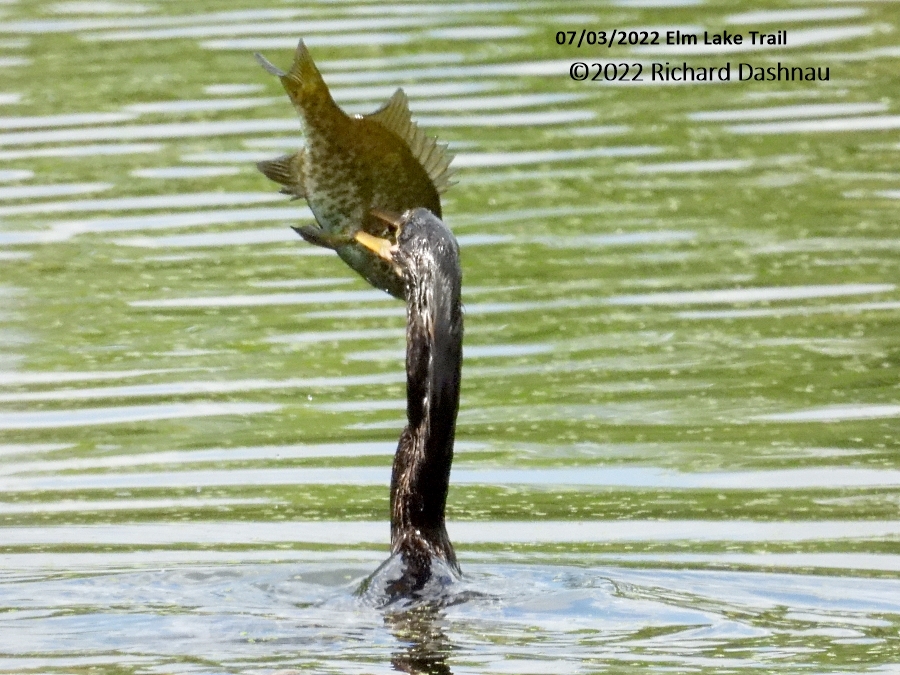
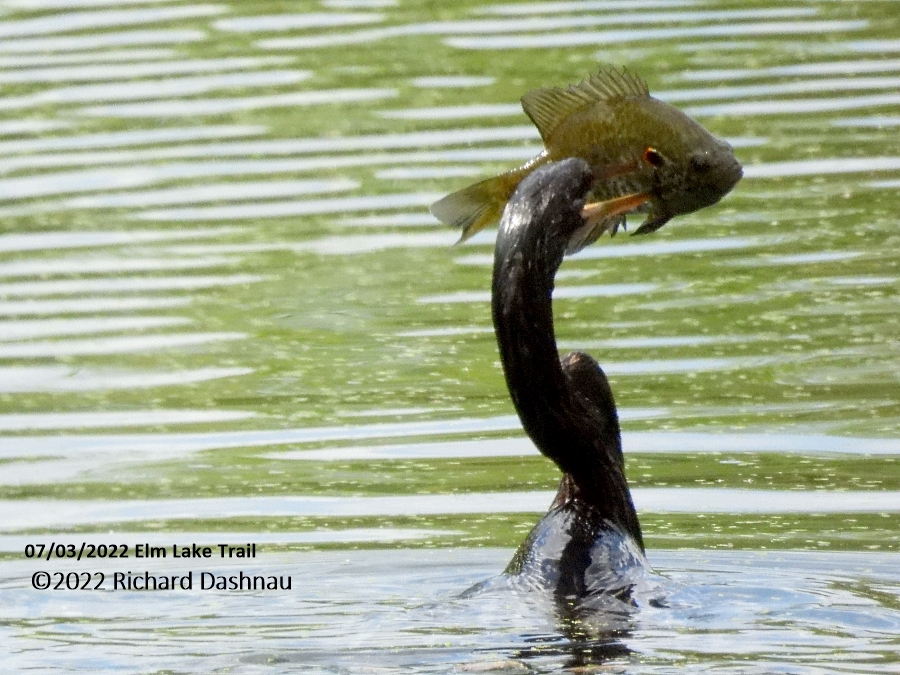
In the new
video presentation, that is linked here.,
there is some demonstration of how an Anhinga has to work to
get an impaled fish off of its beak. At normal viewing
distances, I can only
tell that
Anhingas have very sharp beaks. As shown here (and on the rest
of this page) the sharp beak can apparently pass through a
fish-penetrating scales and the fish. But getting the
beak back out
of the fish takes some vigorous effort. Why? The images
below, taken on the same day (07/03/2022) show a cooperative
Anhinga and close views of its head. This time,
I got
pictures of the open beak, and the array of barbs that point
backward on both
sides of the beak. A single
barb can be useful at the end of a spear. It works to hold the
fish on the spear
when
it is pulled from the water. A single barb is still relatively
easy to take out of a fish. But an array of
barbs--especially on a two-tined spear; would be a lot more
difficult. And that's what an
Anhinga has
to work with. So an Anhinga
has to twist its head and use "inertial tugs" to get the fish
off its beak. I don't recall ever reading the term "inertial
tugs", but it seems appropriate.
Push the
head and impaled fish away from the body, then suddenly change
direction and pull back--pulling the beak against the mass of
the fish which is still moving forward.
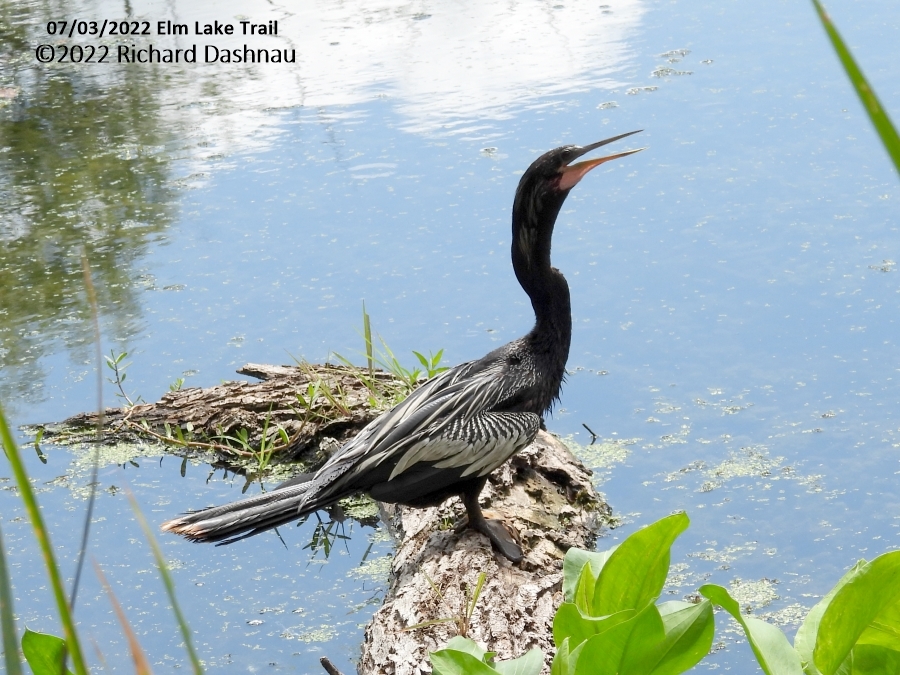
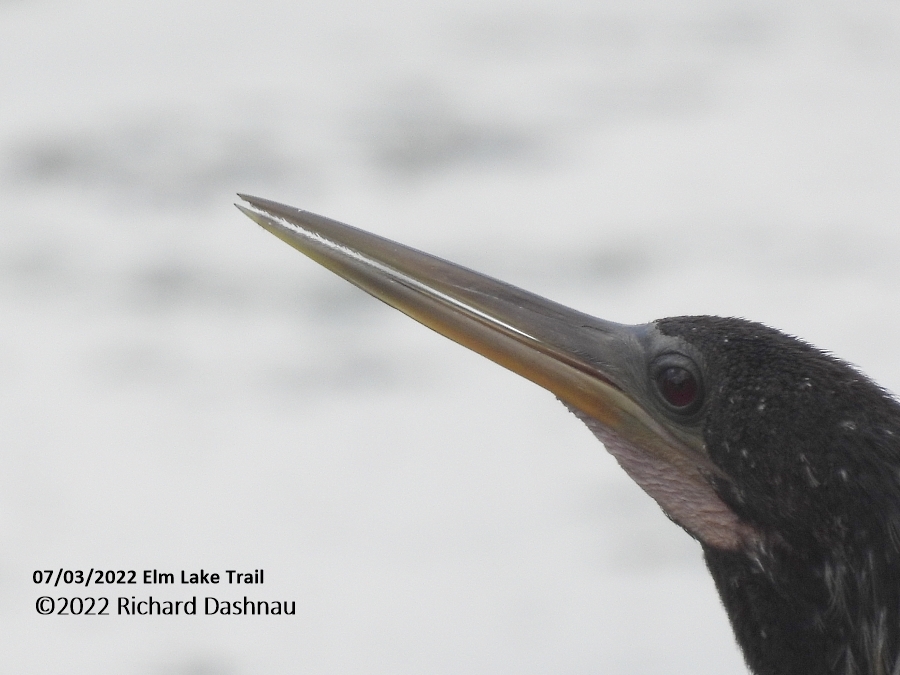
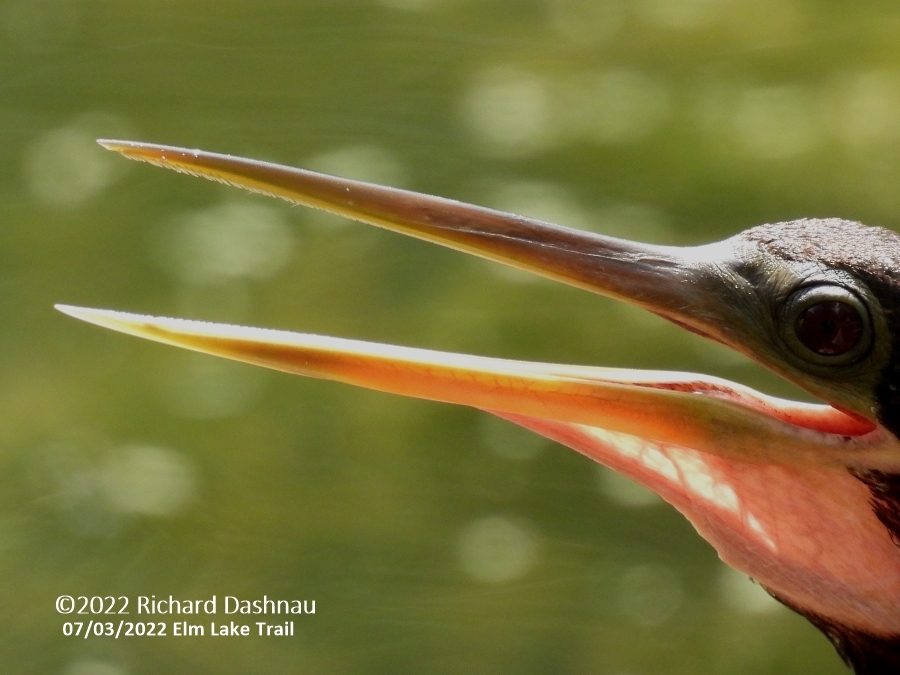
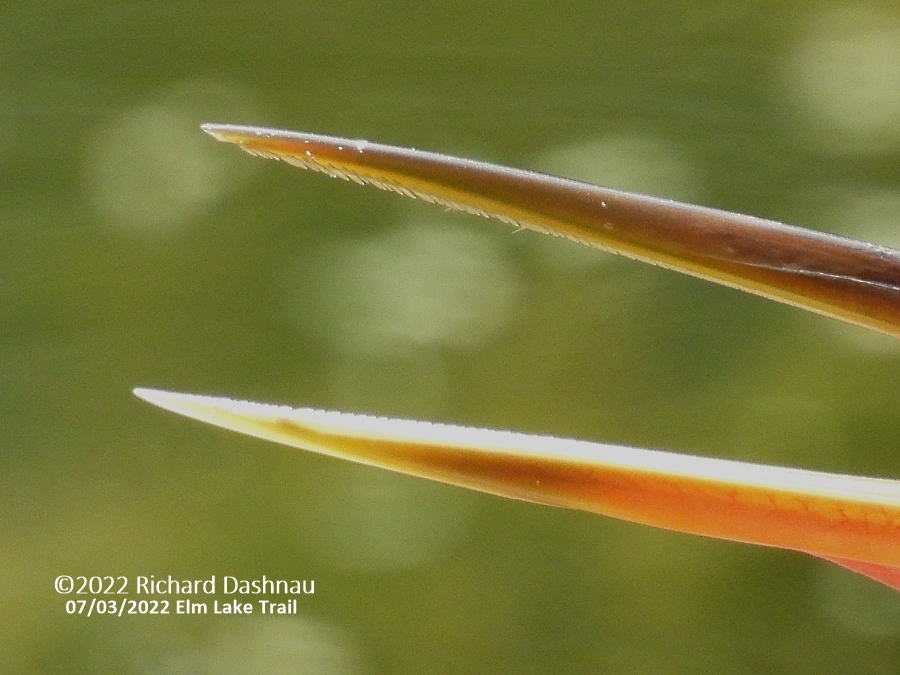
01/30/2022. While
I
was near the mom gator and her den, an Anhinga (Anhinga
anhinga) decided that a spot on the bank about 3 yards from us
was a good place to get out of the water and bask.
During the time I was there, the Anhinga came up, basked
a while, went back in--then came back out again. Judging
by the condition of its wings (not fully-feathered) I think it
may be growing back
its flight feathers after having shed them. These images
show it flapping open its wings (and shedding excess water)
before turning its back to the sun-the Anhinga's shadow shows
where
the sun was.
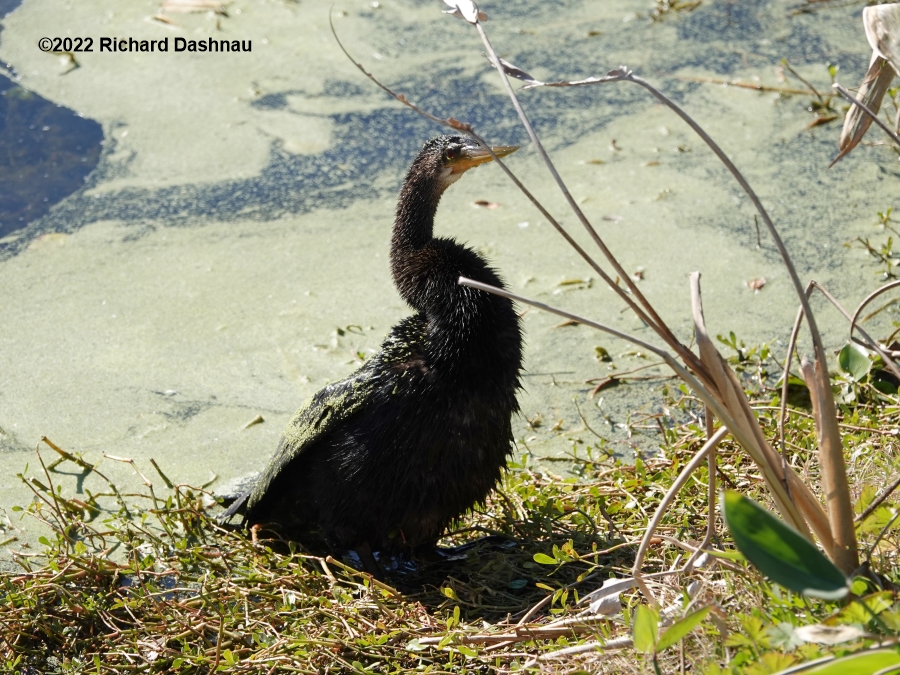
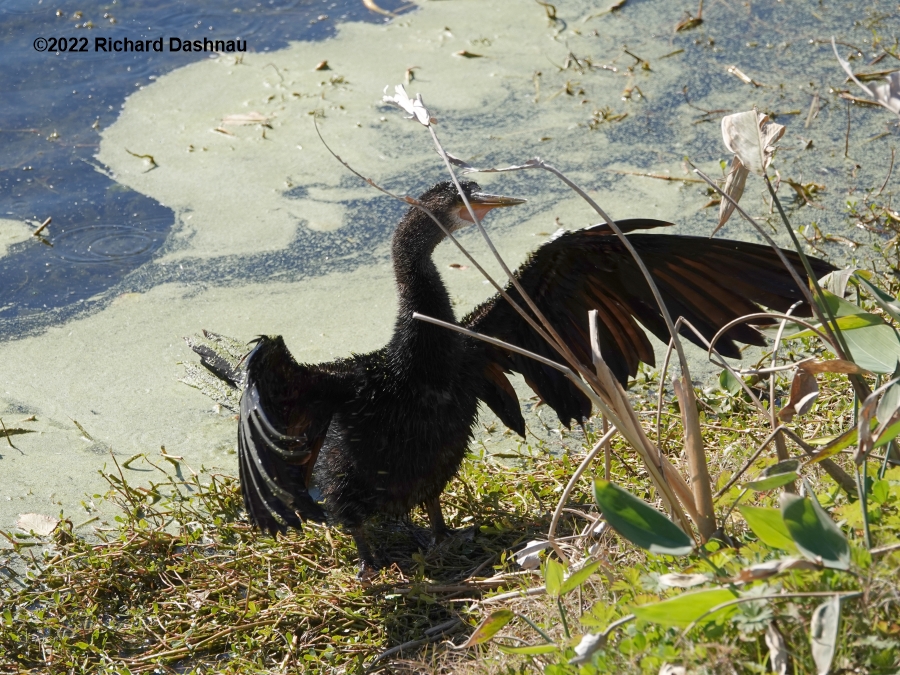
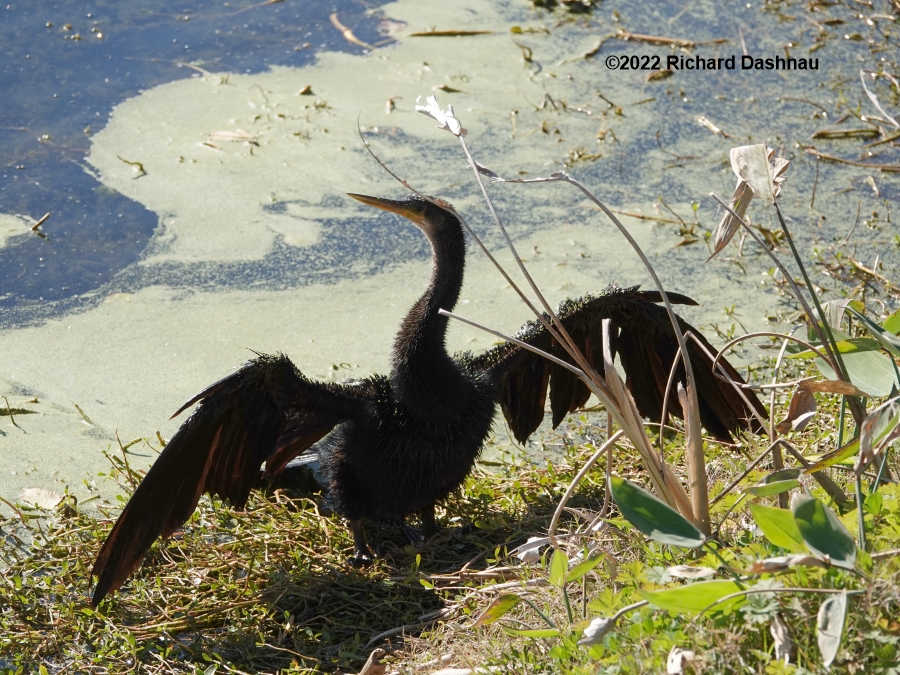
01/16/2022. Another cold day at
Brazos Bend State Park. Please note that there was movement around me most
of the time, so the animals that I mention were not
the only ones
about. I walked to the observation tower and the open waters
there, hoping to encounter otters and/or eagles. At 8:30am I stopped by
the gator mom's den, and she was
visible, but just the tip of her nose was exposed. It was about 39�F on
the trail. Later, this
Anhinga was warming up. This was a wonderful opportunity for
me. For years, I've been trying to get detailed
photos of an Anhinga's beak. Anhingas spear their prey, which
is usually fish (or exclusively fish as far a I know). I
have read about how they have small "serrations" on their beak
that help prevent
impaled prey from sliding off too easily. This is why an
Anhinga sometimes have to wrestle an impaled meal off its
beak. Not only was this Anhinga close enough for me to get a
clear photo--but the
lighting was wonderful! The serrations (they look like
"barbs" to me) were shown in relief. I was really happy
to get these! All of this in
a single day at BBSP. There is imagery showing
Anhingas
hunting further down on this page.
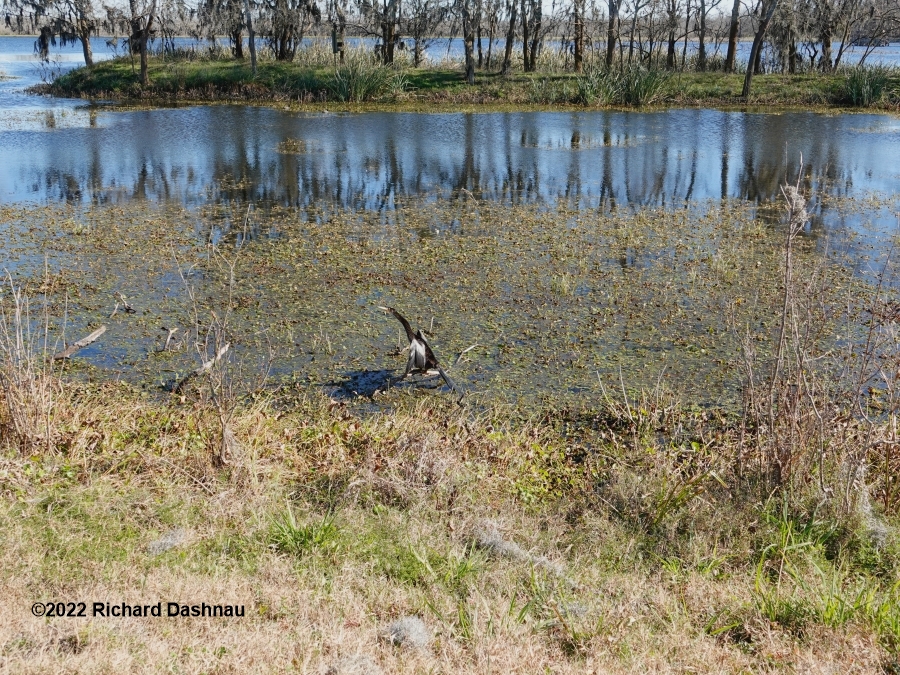
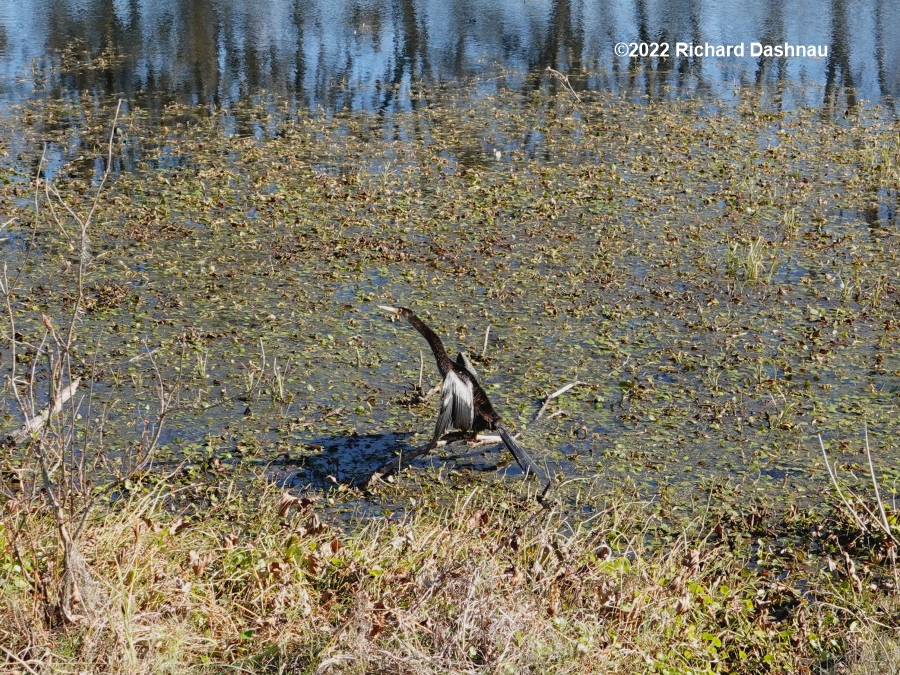
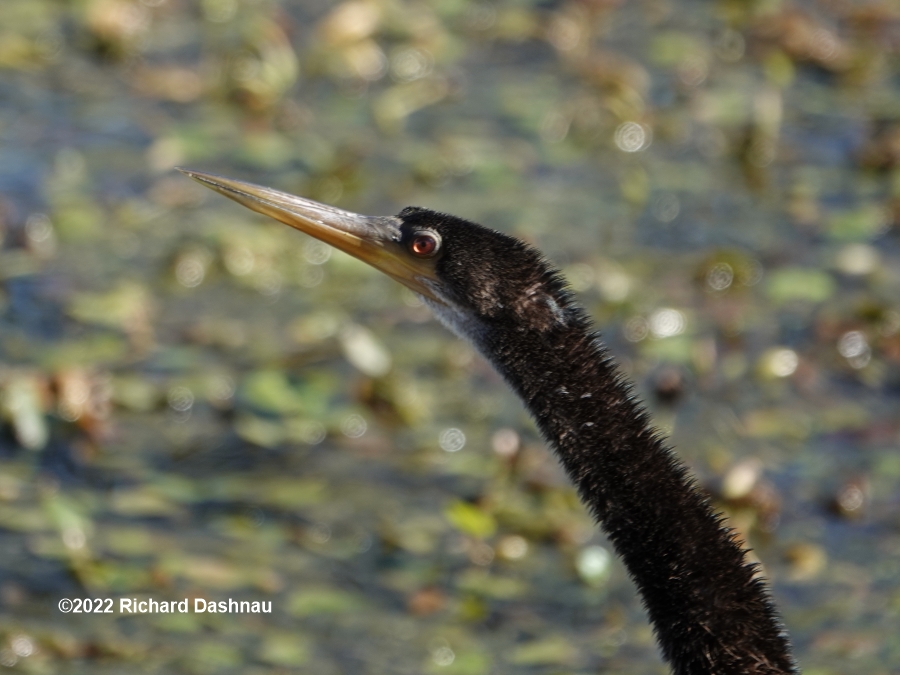
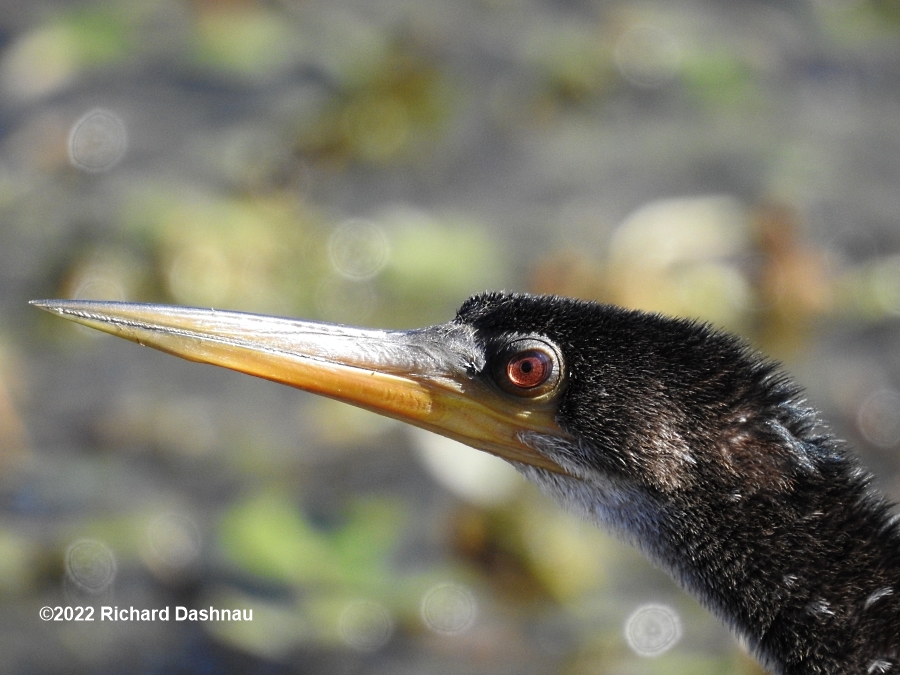
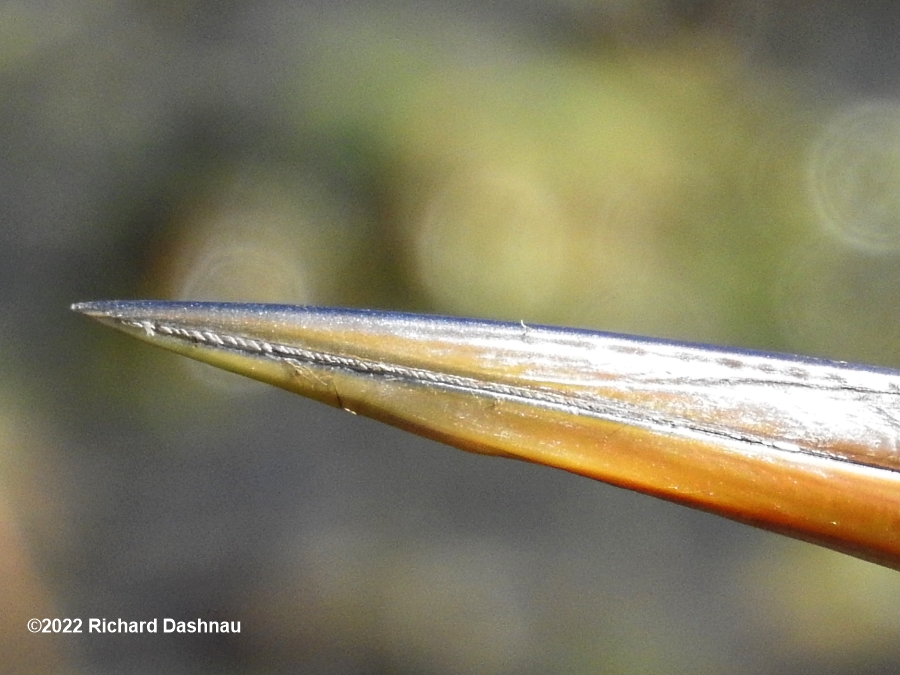
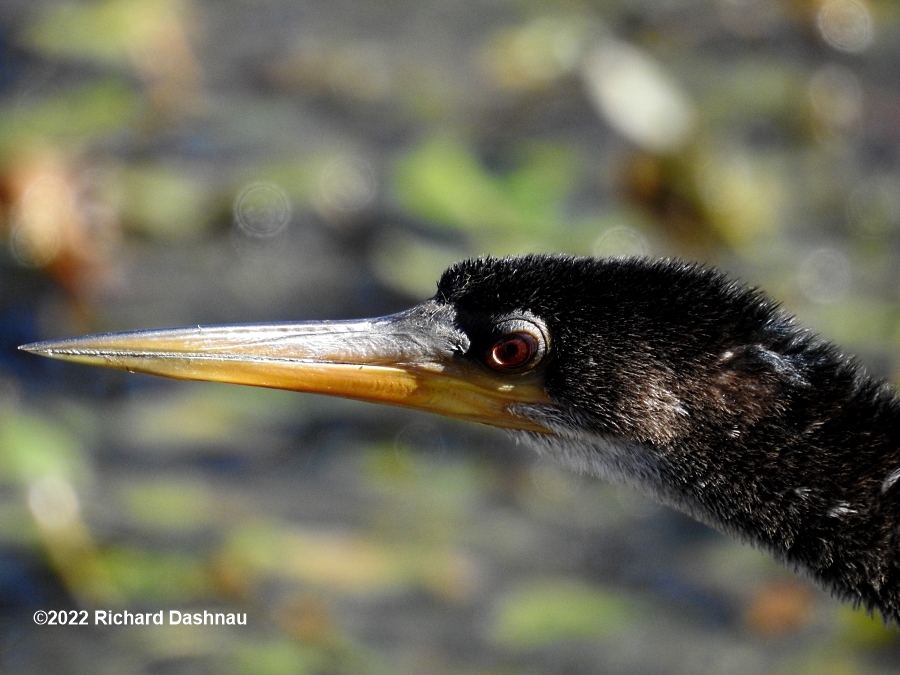
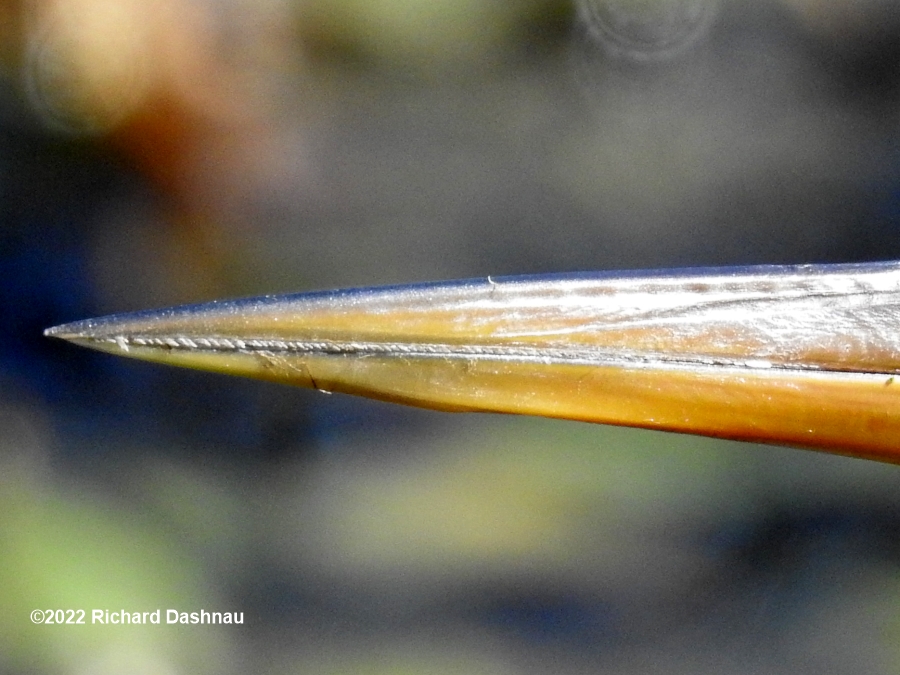
Update 01/03/2022- On
01/01/2022; I was one
of the guides during the First Day Hike at Brazos Bend State
Park. The weather was unseasonably warm, to say the least
(near
80� F later in the day. The "hike" portion of the day
was from 8:00am to 12:00 pm. I'm often on the trails doing
"roving interpretation" anyway, so my part wasn't much
different.
There were just more people hiking around 40 Acre lake than
usual. Since the weather was so warm, it was very
comfortable in the morning. A few alligators were moving
around,
a pod of baby alligators was visible (I've been monitoring
them for weeks, so didn't take any pictures for this hike).
It was a lot of fun!
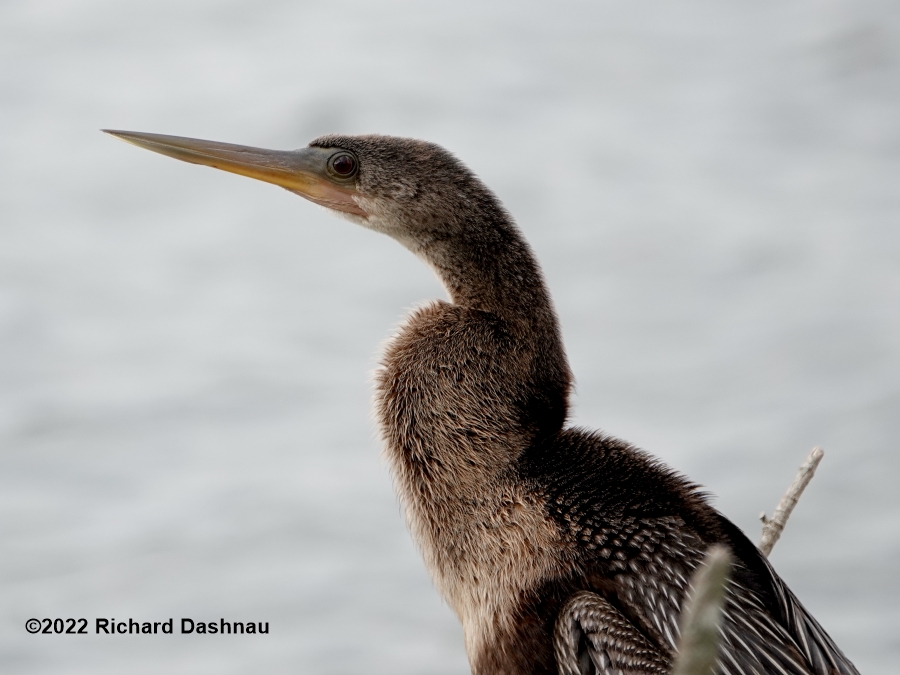
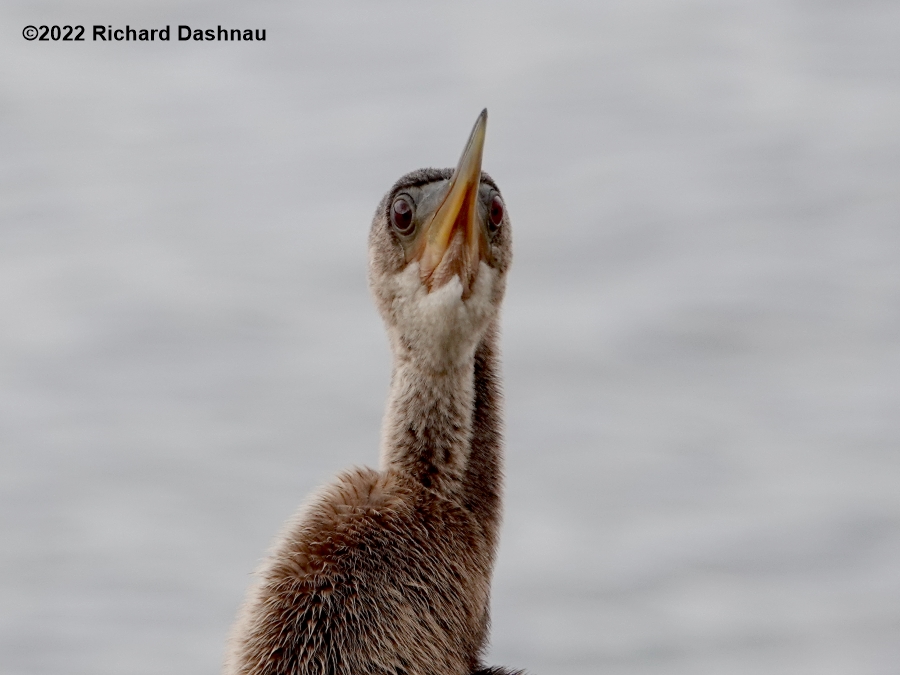
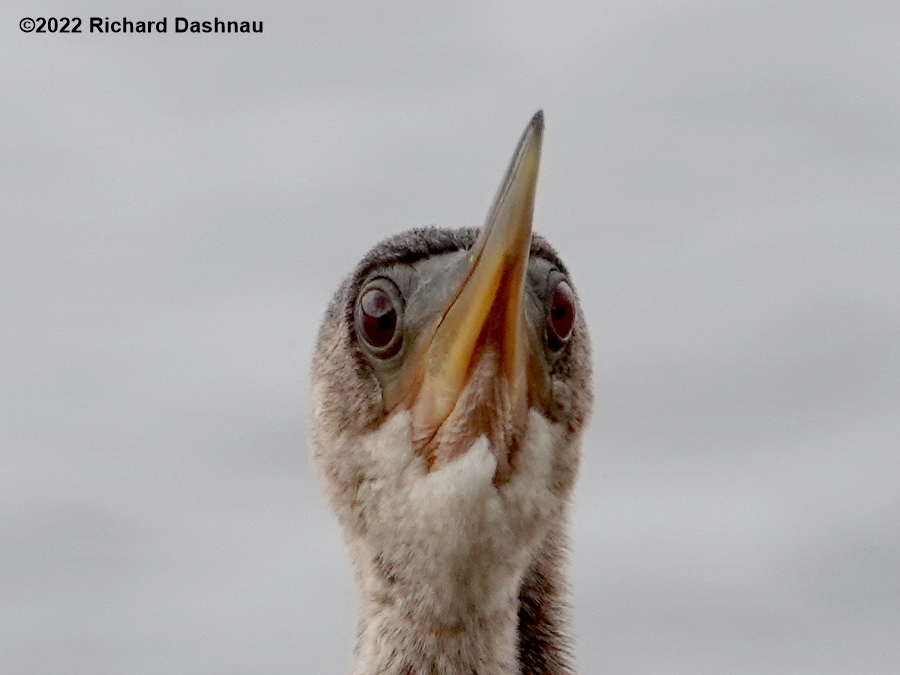
This Anhinga (Anhinga anhinga)
rested very close to the trail, just before noon. I
realized I have few pictures of Anhingas from the front...so I
captured these. There
were
many other
sights, but was spending more time interpreting for visitors
than taking pictures this day. There were plenty
of sights available for the First Day Hike of 2022.
On
11/28/2021;
I arrived at BBSP. The
day
was cold, damp, and grey; but there was no breeze, so 40Acre
Lake was smooth. These two pictures show the view to my East and
the West.
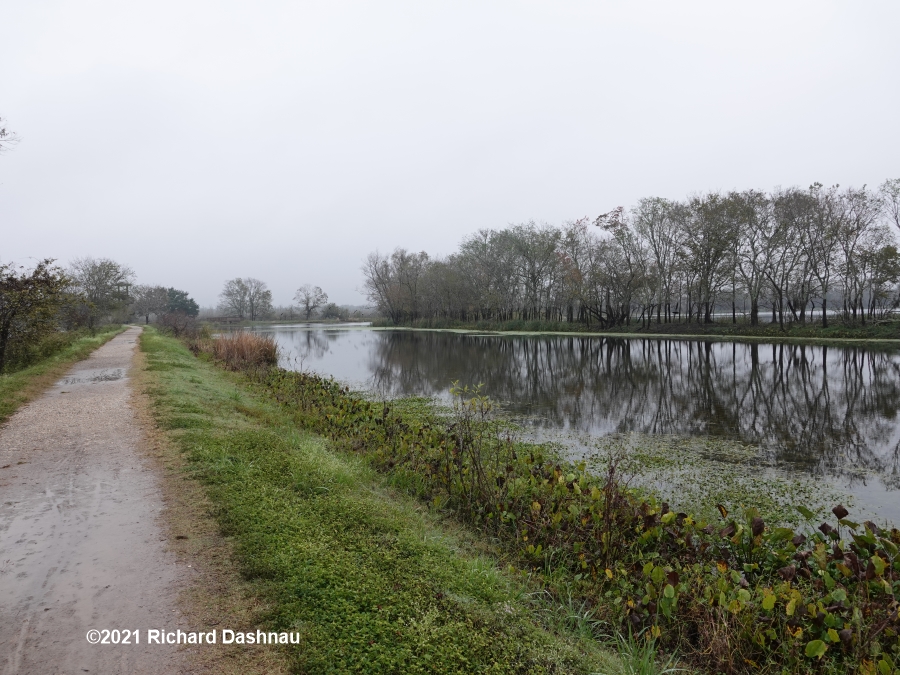
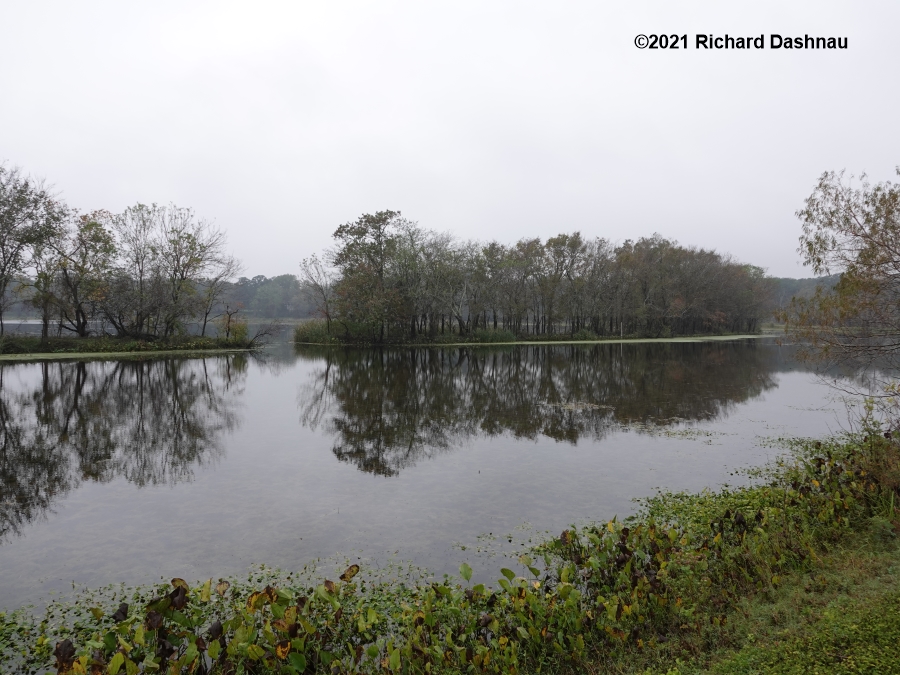
I
returned to 40Acre lake at 1:30. I passed an Anhinga (pictures) on
my way back to the pod.
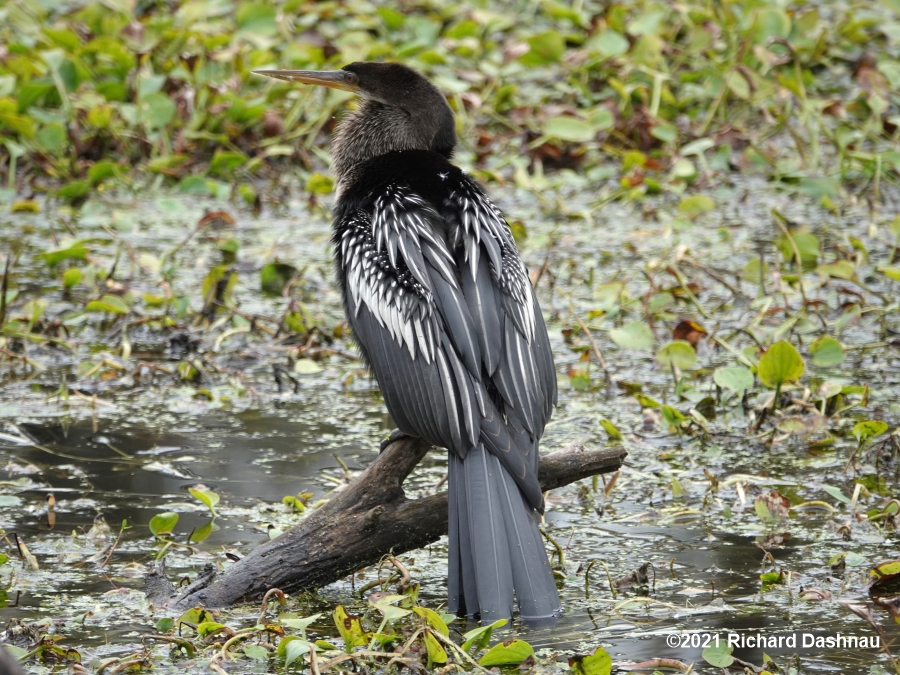
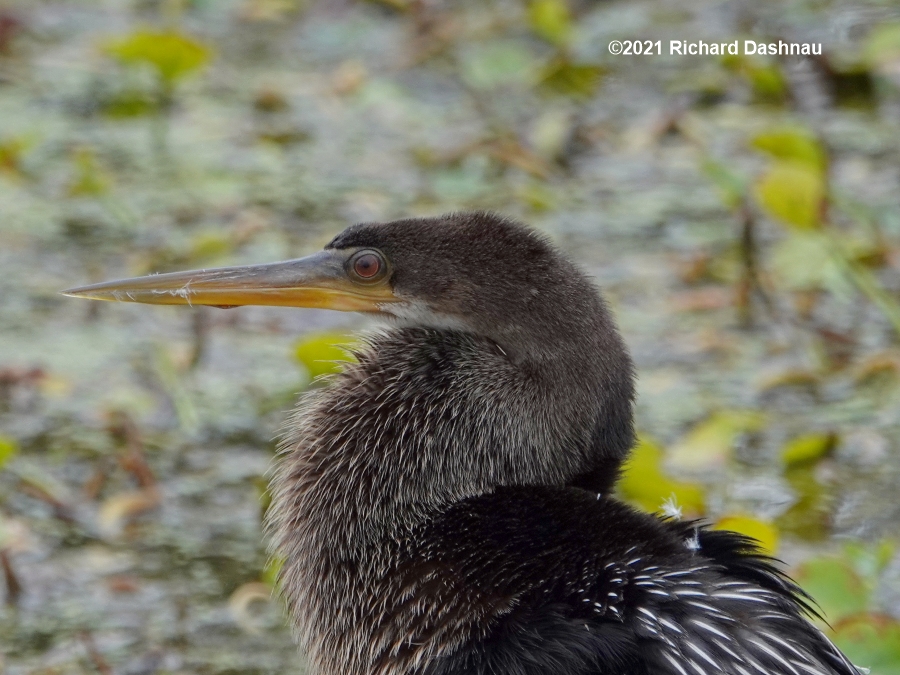
12/28/2020 I
went to Brazos Bend State Park today. I
thought that it might not be too busy, since it was Monday, and
I wanted to be prepared for an upcoming hike there that
I'd committed to.
I hadn't driven this far for months. I volunteer at BBSP
as a ranger (mostly as an Interpretive Guide), so I interact
with park visitors as needed. I always kept my mask on, and so
did
most of the park visitors. We all stayed far apart, so I
felt comfortable being there. Up until a few weeks ago,
possible contamination of my workplace (by me) was also a factor
which kept
me away from the park. However, since I'm no longer employed by
that entity (or anyone else at this point); that's not an issue.
I took some pictures and video...which I'll be sharing.
I'll start with this Anhinga at 40-Acre Lake. He was on a fallen
tree on the trail South of the Observation Tower. He posed
for the camera, and while I was enjoying the sight, he started
rubbing his head and neck area against the base of his tail.
I've written about this behavior before, and I still
haven't found anything that defines it.
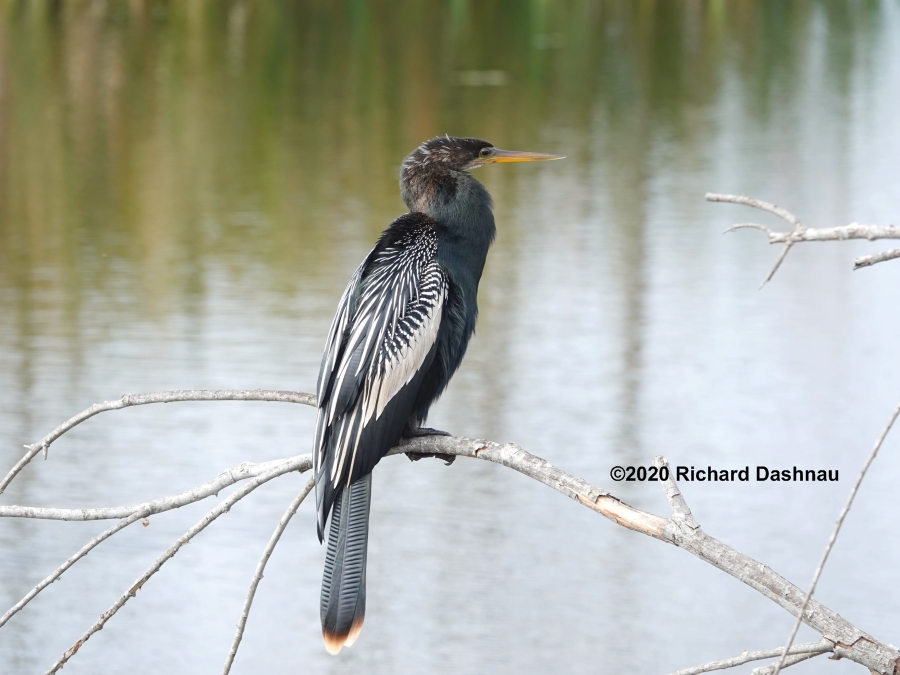
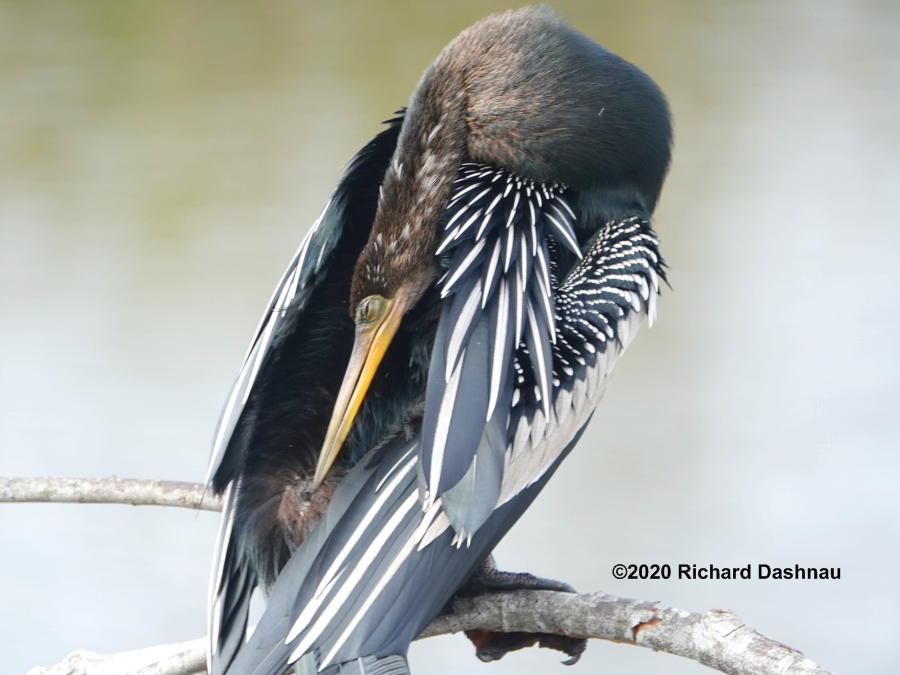
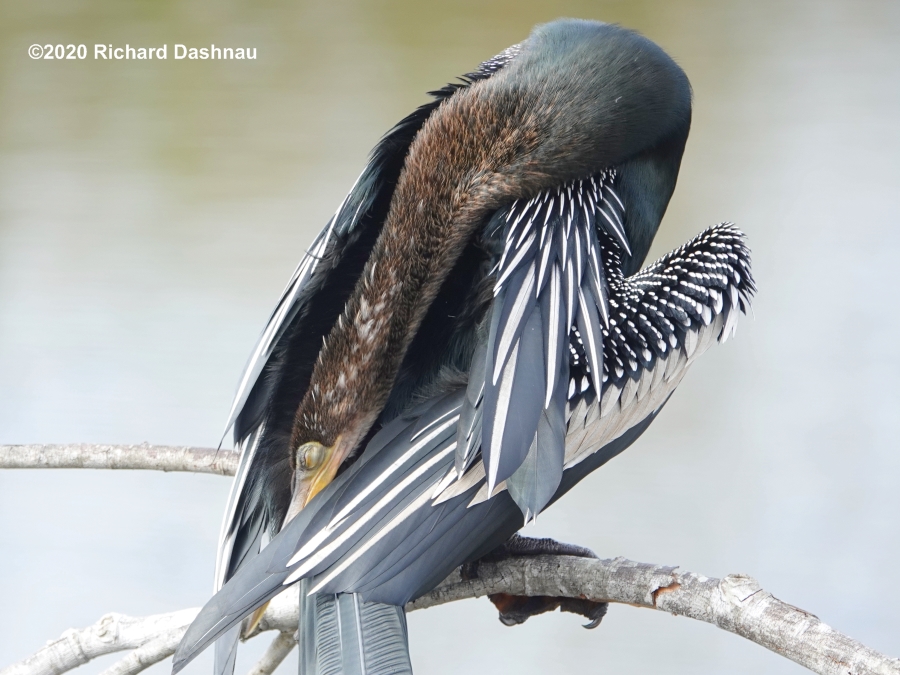
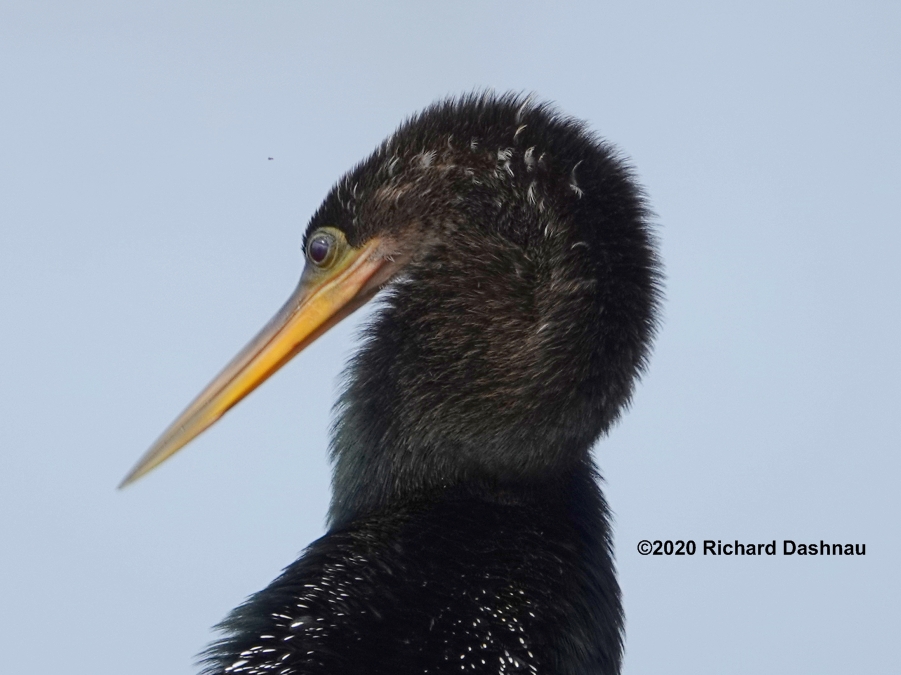
Male
Anhinga
Male Anhinga pointing at his
"preen gland" Anhinga treating head and neck
area
Anhinga--Nice Profile
Unlike
what some sources say; Anhingas do have a "preen
gland"--that is, a gland that secretes an oily substance that is
used to treat feathers. Many birds use this secretion to treat
their
feathers so that they shed water. This can help with
bouyancy, insulation (wet feathers woouldn't be very warm), and
a number of other issues. But Anhingas need their feathers
to absorb
water. This allows Anhingas to stay underwater without much
effort. So, Anhingas don't need to oil their feathers--at least
most of them. Anhinga feathers are configured a bit differently
than
other birds, so that they absorb water more efficiently.
But, Anhingas do have a gland, and I've seen them use it
by poking a bit with their beak, and then rolling and sliding
their head and neck
over it with a sort of "honing" motion., as if they were
sharpening the beak, face, and neck. I've guessed that if
they make this area hydrophobic it might lessen drag forces when
the anhinga stabs
at prey. Or, it might help insulate that area to lessen
heat loss. Or both. I caught a very short video of this
anhinga oiling its neck. The images below are frames from this video (mp4).
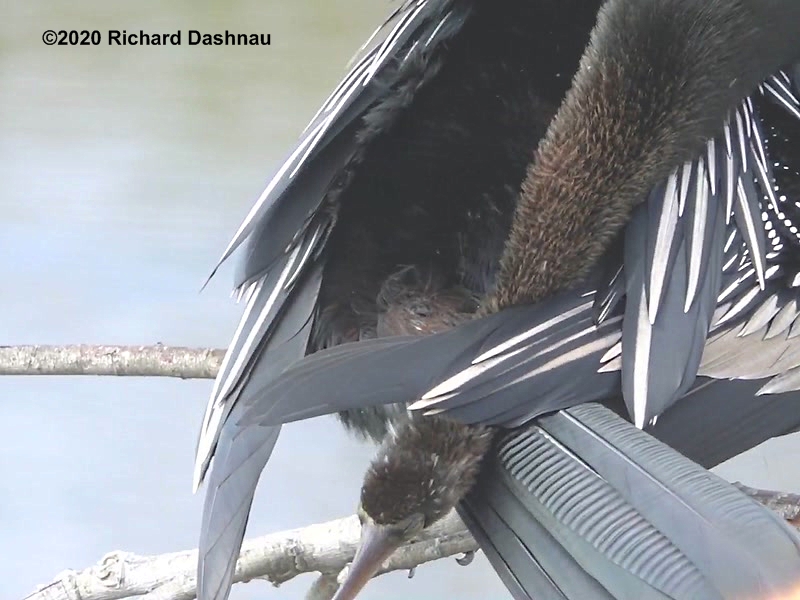
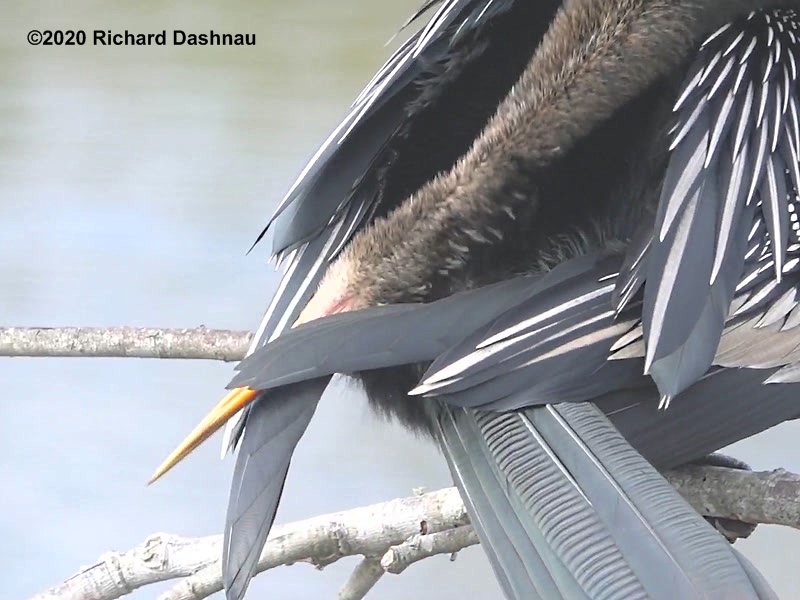
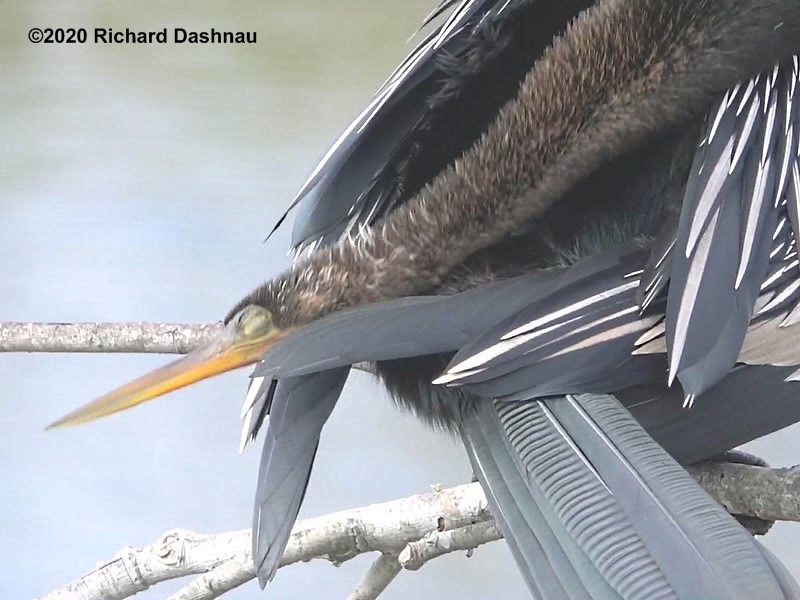
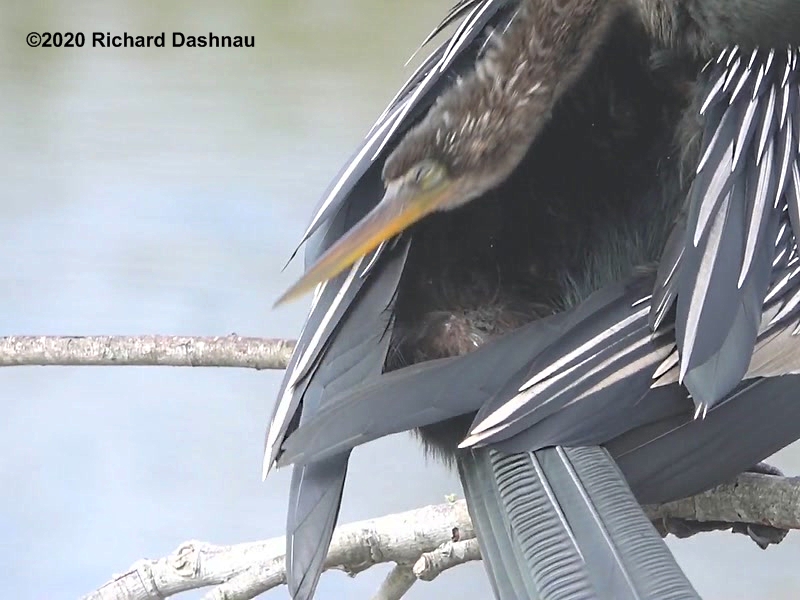
Start behind the gland
Rotate the head and neck onto the
gland
Twist the other way move forward & back
Rub, and then
pull back
December 29, 2013-- (photos from 2013 and new notes added
to this page 1/29/2021) This started out with an Anhinga in
the best position ever. It had speared a large
fish (possibly
a Blugill Sunfish) and was swimming with the fish held high above the
water. It moved onto a branch to handle the fish, and I was able to
get pretty close to it and shoot a few photos and
video clips. Most of the images below are frames from the
video clip(mp4). I wasn't able to see the Anhinga eat the
fish, though.
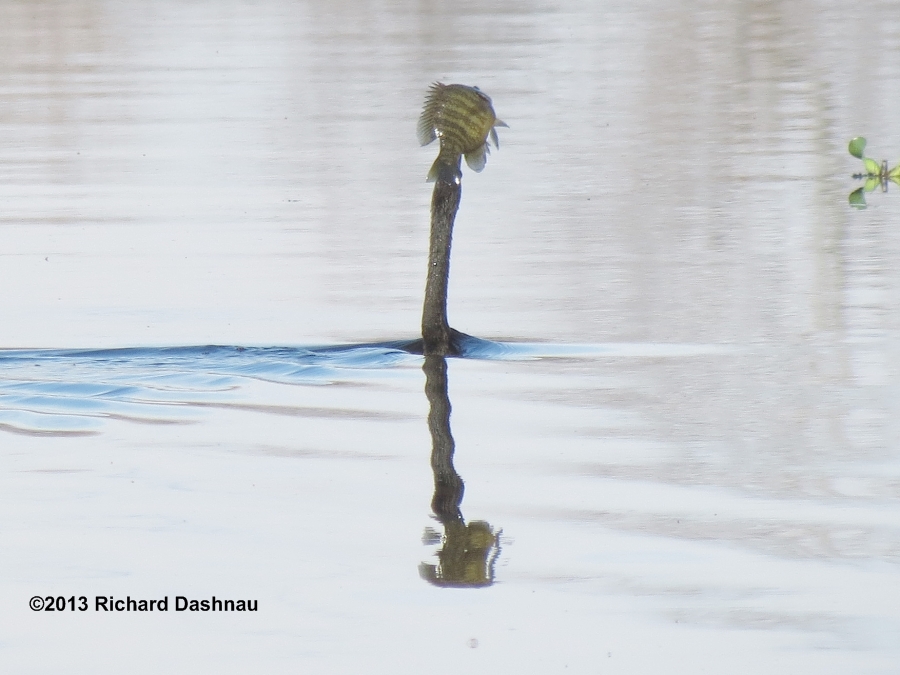 -
-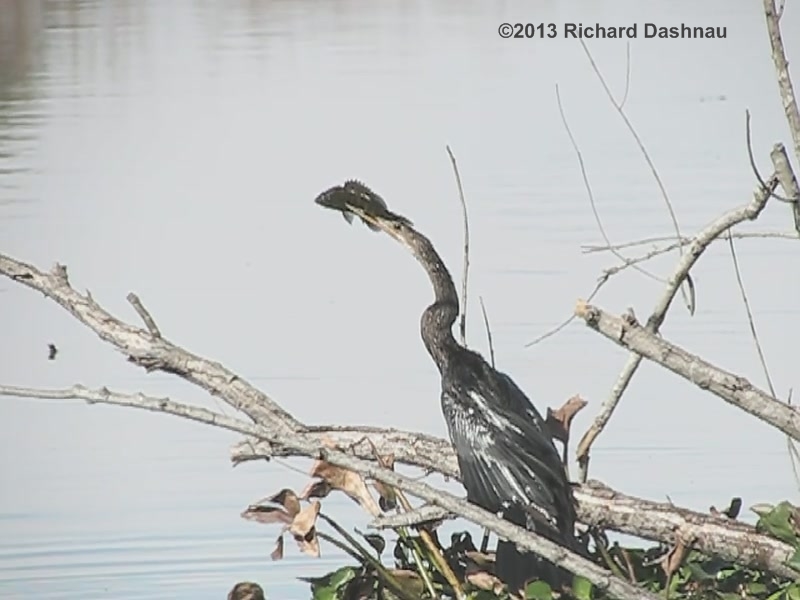 -
-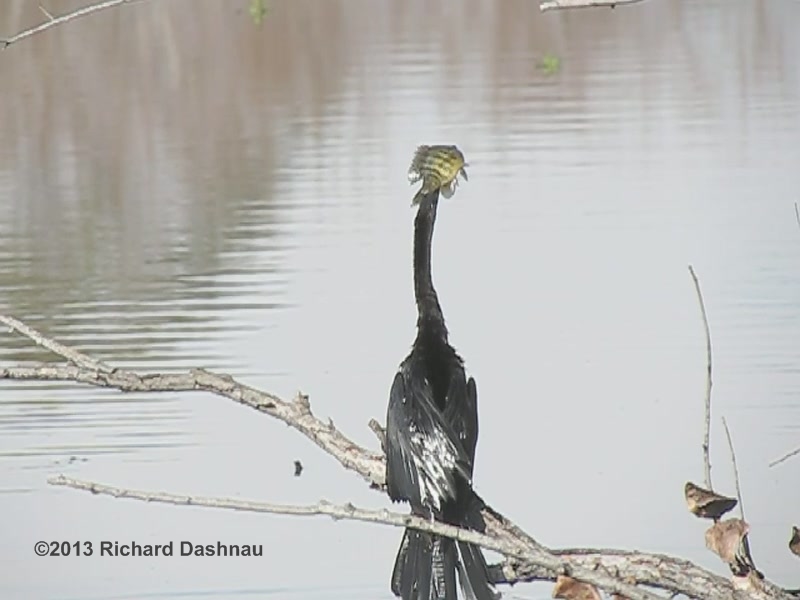 -
-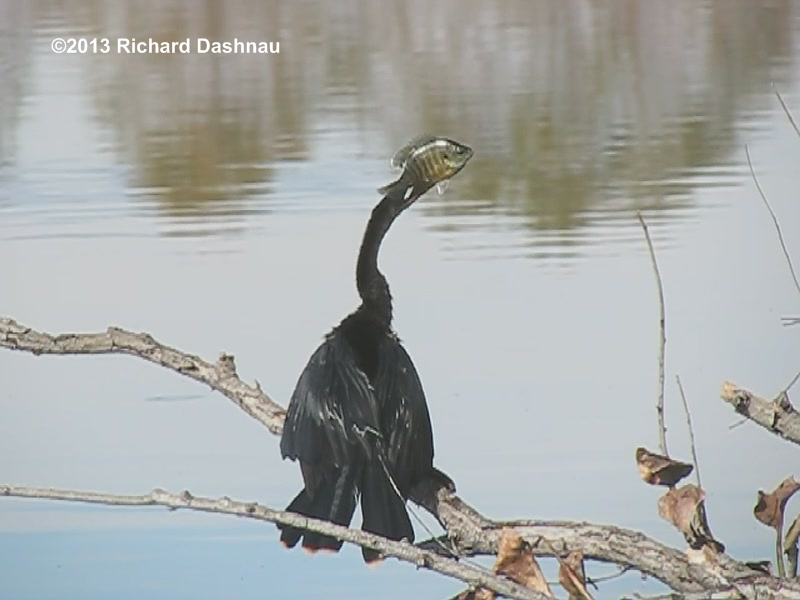
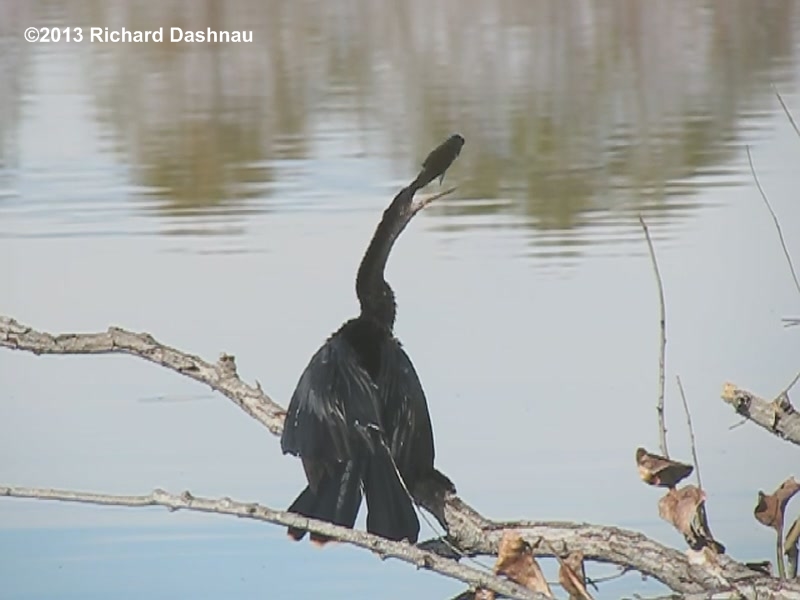 -
-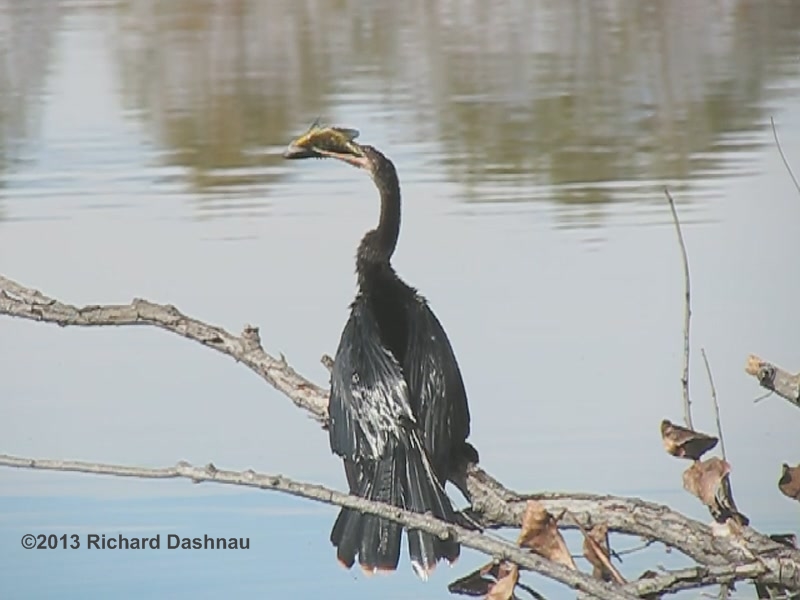 -
-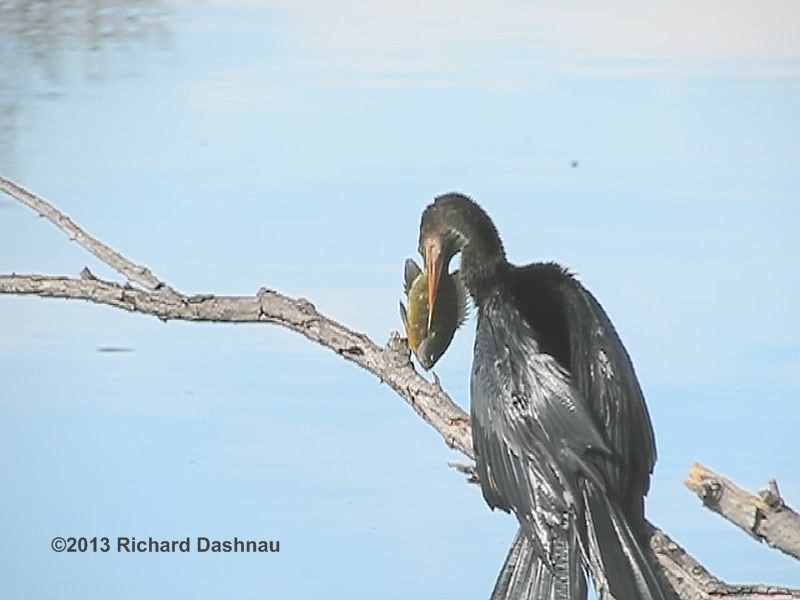 -
-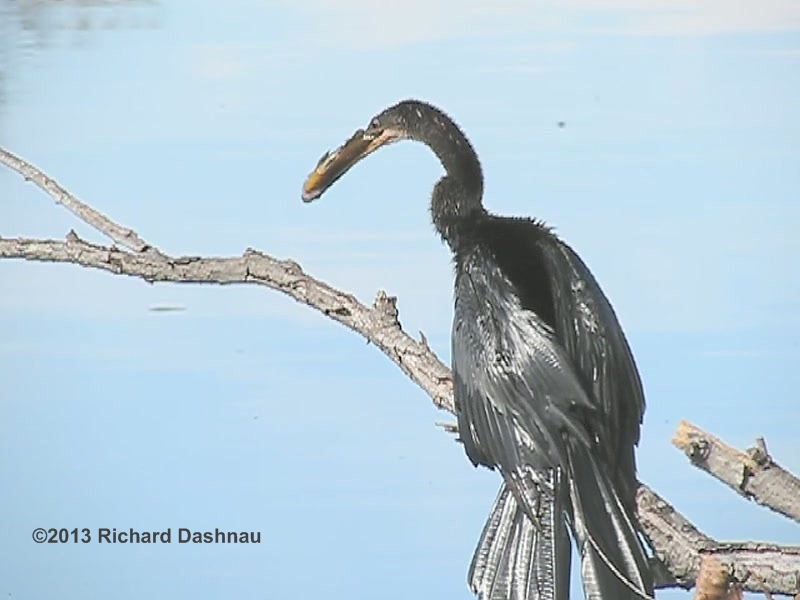
From
material I've read recently (2021), here's a brief description of the
parts of a birds beak:
Like all vertebrates, birds have a skull, with an upper and lower
mandible. But unlike most vertebrates, birds don't have teeth.
Instead, they have their mandibles covered by hard
material by structures called "rhamphotheca" (also called a "beak" or
a "bill"). The sharp edges of the beak or bill are called the
"tomia". This is where various adaptations turn
a beak into a specialized tool in many cases. It's part of the
reason why bird beaks come in so many shapes and sizes. (from
the paper "From snout to beak: the loss of teeth in birds"
by Antoine Louchart and Laurent Viriot) Anhingas have
these serrations in their tomia to keep fish from sliding off the
points of the beak.
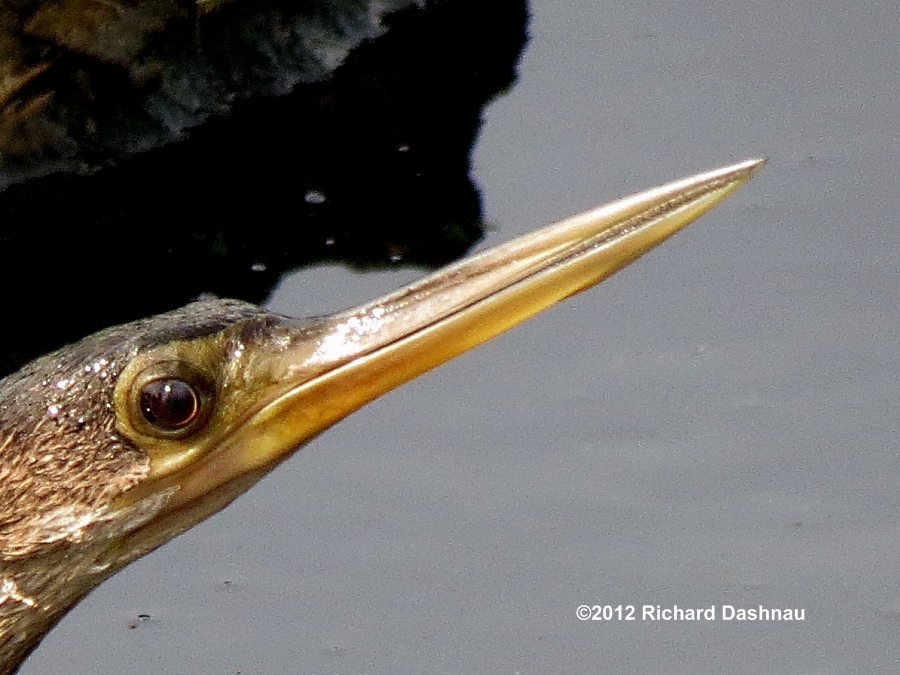 -
-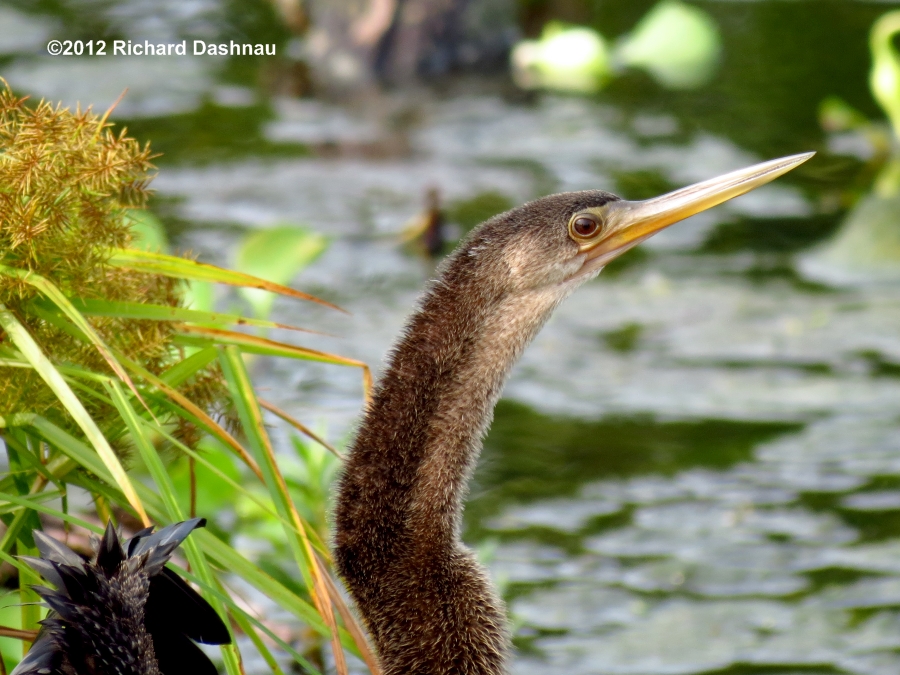 -
-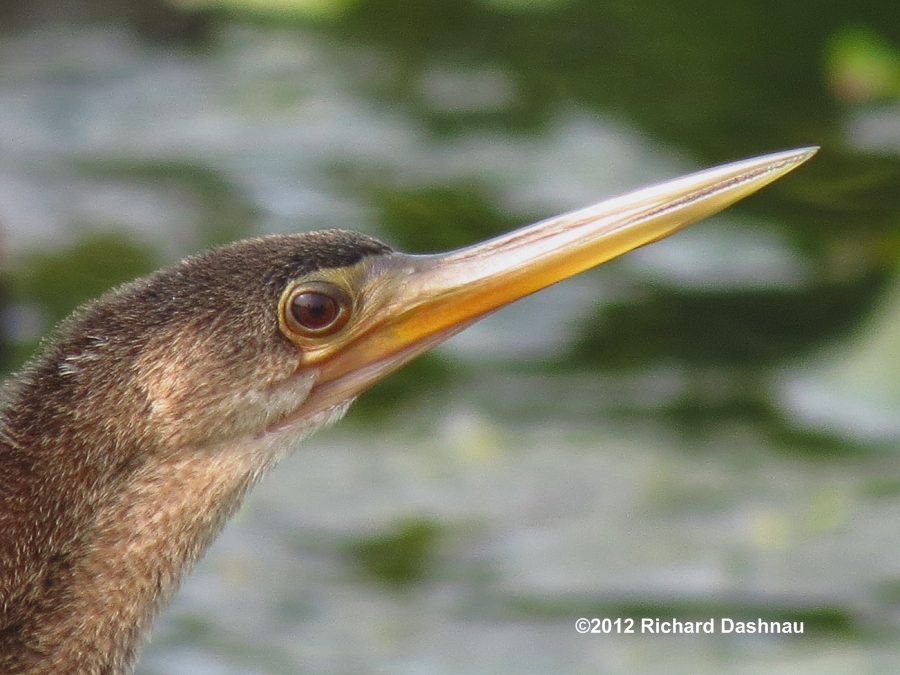
September
16, 2012-- (photos
from 2012 and new notes added
to this page 1/25/2021) In the notes for Sept. 9 below
I mentioned that I hadn't gotten any pictures of the
"serrations"
on an Anhinga's beak. I believe I actually have, though. I got some
good closeups of this Anhinga as it hunted near me. Look closely at
the few inches near the point of the beak, and
the raggedy edges are visible. From material I've read recently,
here's a brief description of the parts of a birds beak.
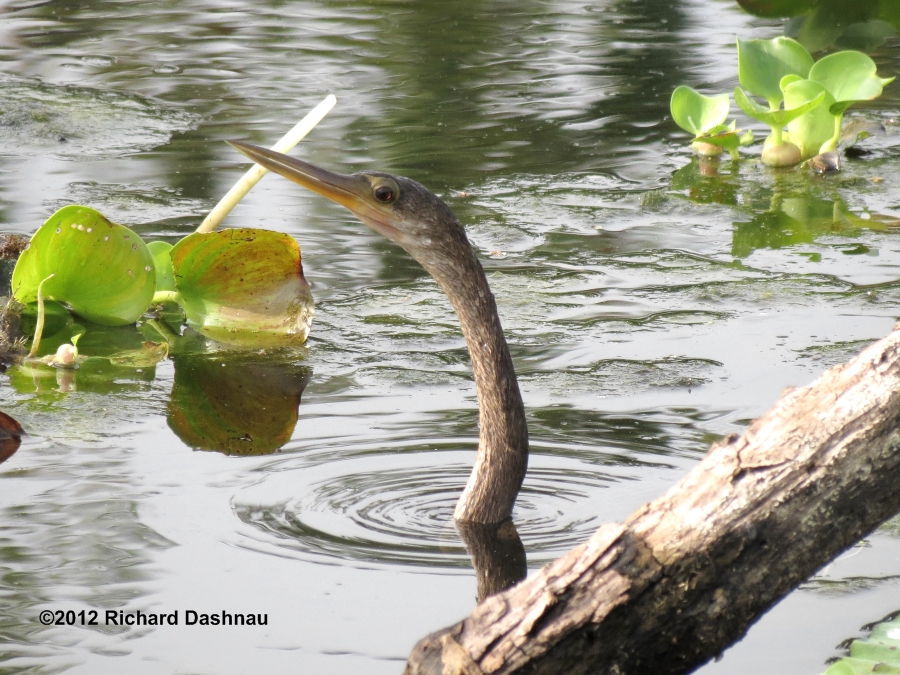 -
-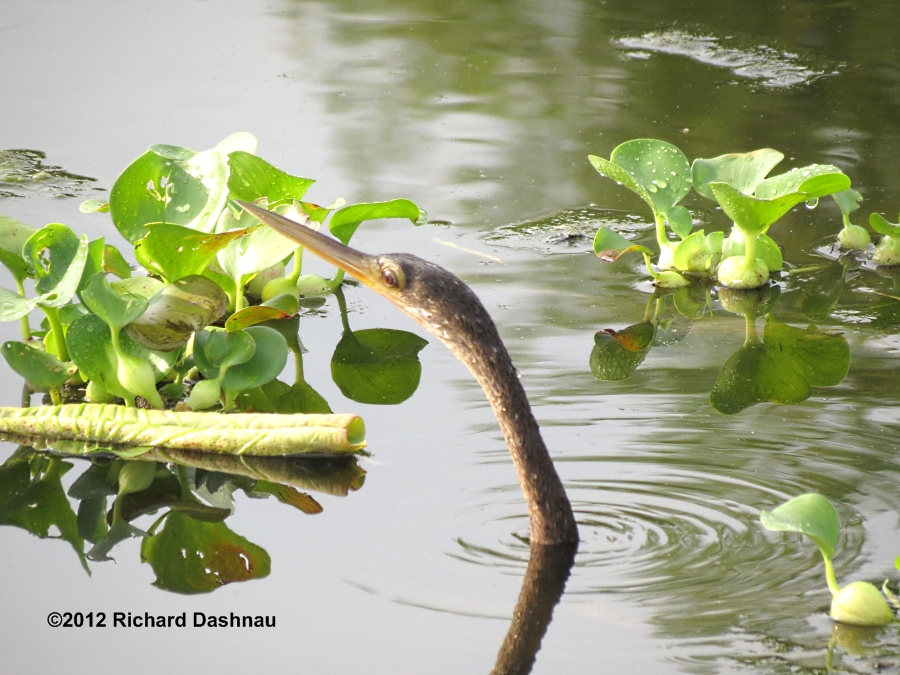 -
-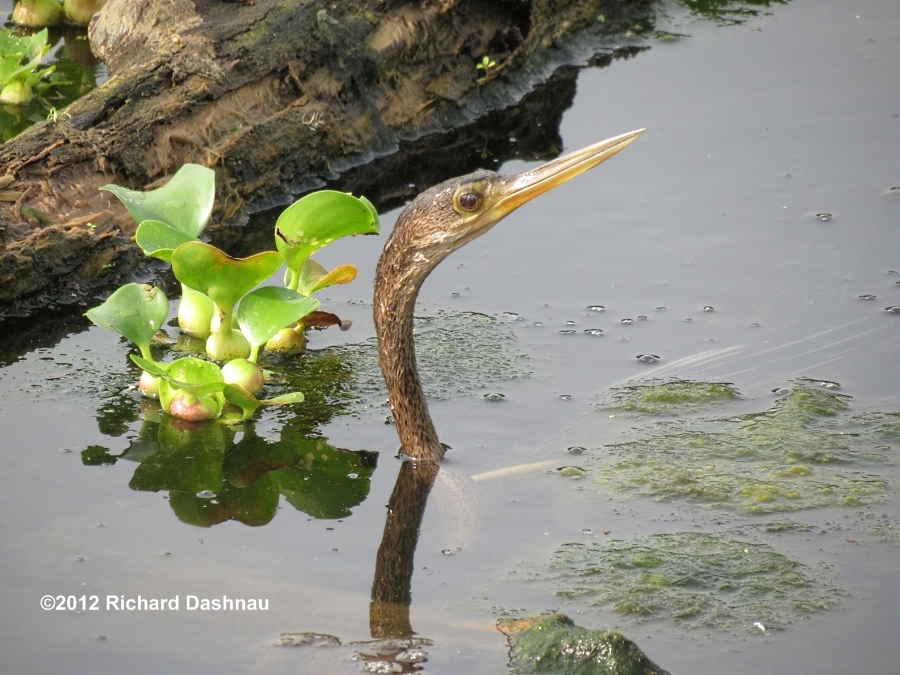 -
-
From
material I've read recently (2021), here's a brief description of the
parts of a birds beak:
Like all vertebrates, birds have a skull, with an upper and lower
mandible. But unlike most vertebrates, birds don't have teeth.
Instead, they have their mandibles covered by hard
material by structures called "rhamphotheca" (also called a "beak" or
a "bill"). The sharp edges of the beak or bill are called the
"tomia". This is where various adaptations turn
a beak into a specialized tool in many cases. It's part of the
reason why bird beaks come in so many shapes and sizes. (from
the paper "From snout to beak: the loss of teeth in birds"
by Antoine Louchart and Laurent Viriot) Anhingas have
these serrations in their tomia to keep fish from sliding off the
points of the beak.
 -
- -
-
September
09,
2012-- As
the
summer ends most of the Anhingas prepare to go South for the winter. I
said "most" of them. A few usually remain at Brazos Bend State park,
but
I don't often see them fishing. Today, there were still a few hunting,
and I watched one as it worked. I was lucky, because it came close to
me. I got really lucky and had the
camera pointing and focused at the right spot when I shot the burst of
images shown below. These are cropped from a larger images. The
Rickubiscam image is of the same Anhinga
but about 30 minutes later.
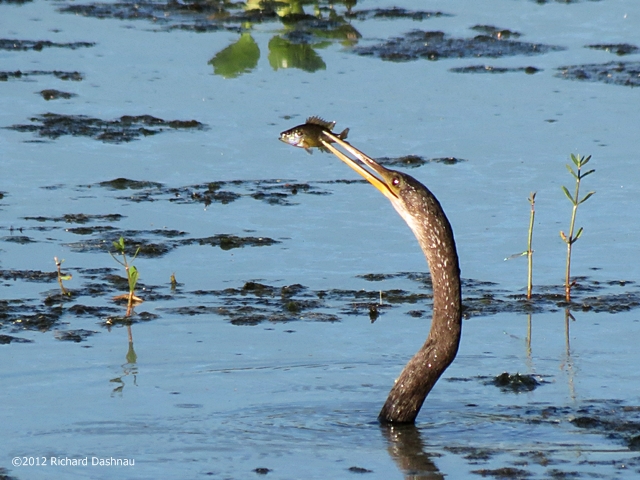 -
-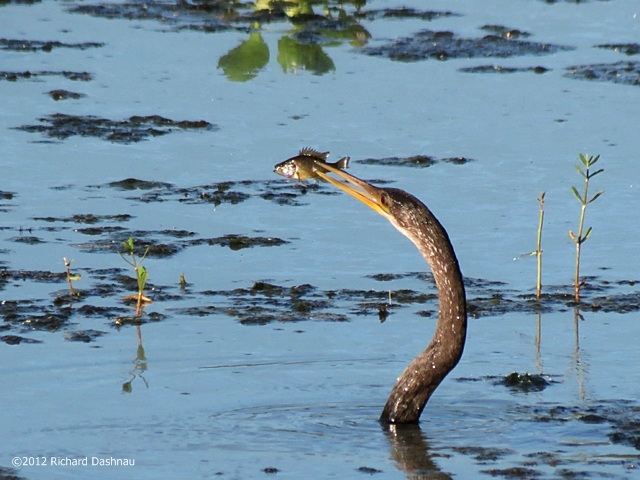 -
- -
-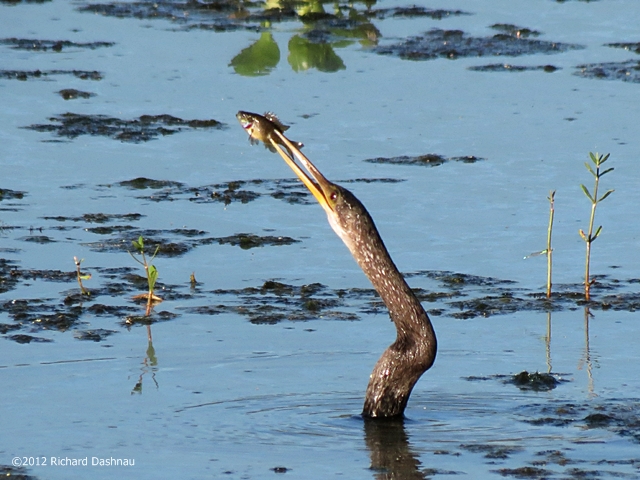
I have read that Anhingas have serrations on the
biting edges of their beaks to help secure fish that they have
captured. Although I've tried, I haven't been able to photograph
them. This roughness may help secure the fish, but it can sure
make it difficult to UN-spear the fish so that it can be eaten. To
do this, the Anhinga will thrust its head forward,
then jerk it back. This will allow the beak to pull out of the
fish. But, the Anhinga has to be careful not to pull the beak out
too quickly or it could lose the fish. So, sometimes there's
an interesting combination of sharp, brute force and delicacy as
the Anhinga works the fish off its beak. In this example, it
worked smoothly, and the fish "paused" in mid-air as the
Anhinga positioned its beak under it (5th image); after a single
try.
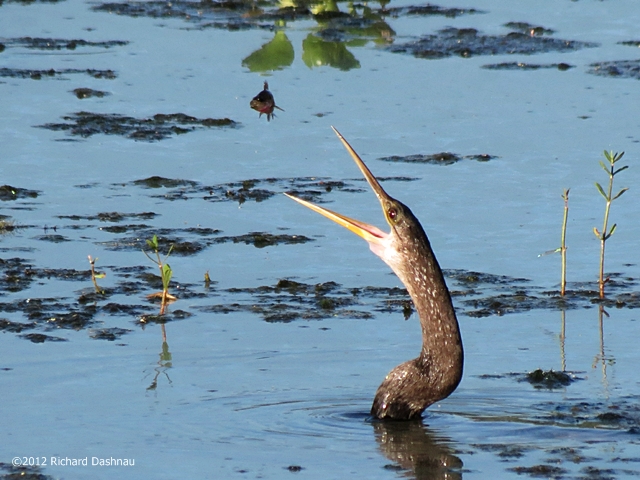 -
-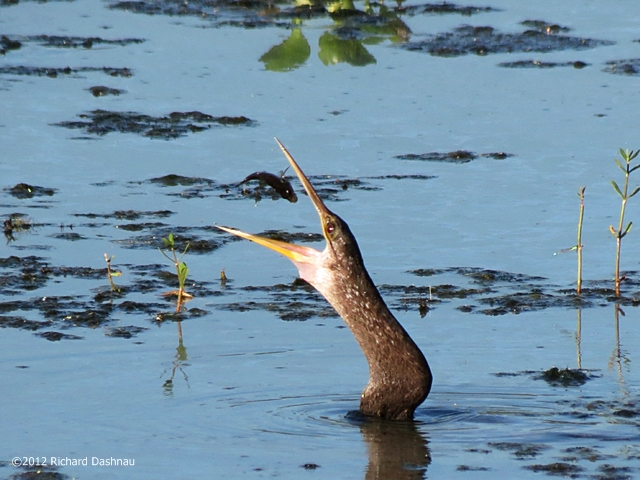 -
-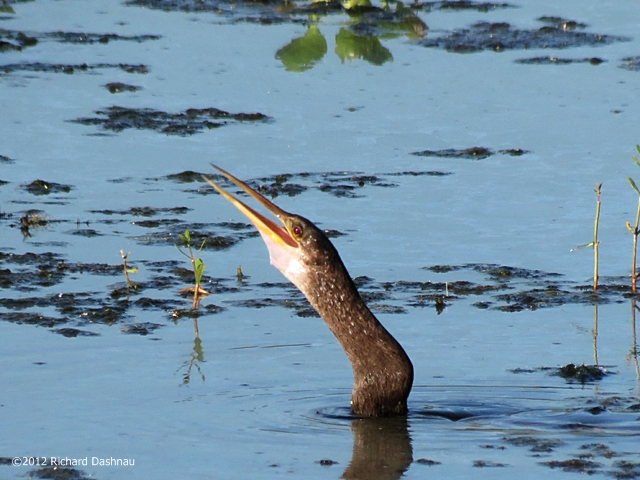 -
-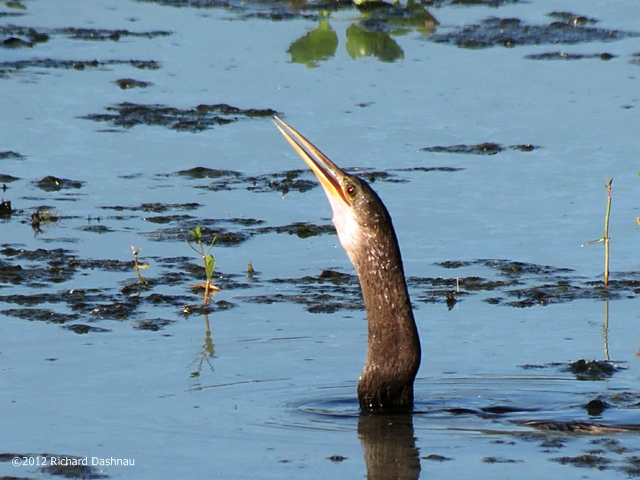
The image below is a frame grab from a video
clip(mp4) that I edited together from two other clips
of catches by the same Anhinga. I shot these at normal frame rate
(instead of the usual
(high speed) to illustrate how fast the Anhinga is moving
during this process. I am a little sorry for missing the
opportunity of catching a long struggle at high-speed; but some of
it was out
of focus anyway. In the first clip, the Ahinga surfaced, and
immediately lost its fish. It quickly dove, but that fish was
gone. In the second clip, the Anhinga struggled a bit to get
the fish off its beak.
When it finally did, it almost dropped it, but was able to save
the fish after some juggling. Watch both clips carefully, because
everything is over quickly.
-------------------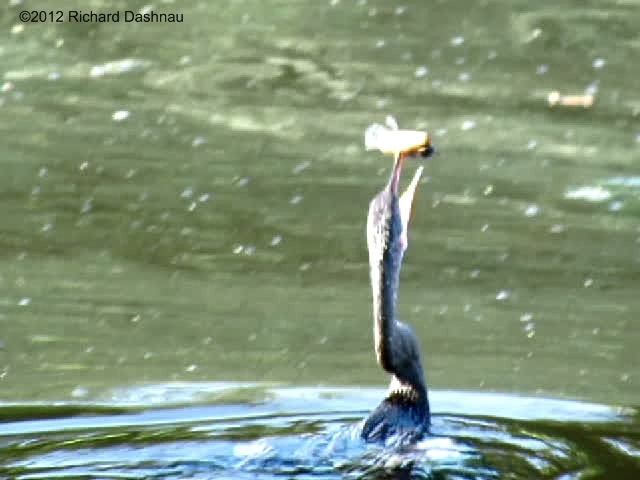 ----------
----------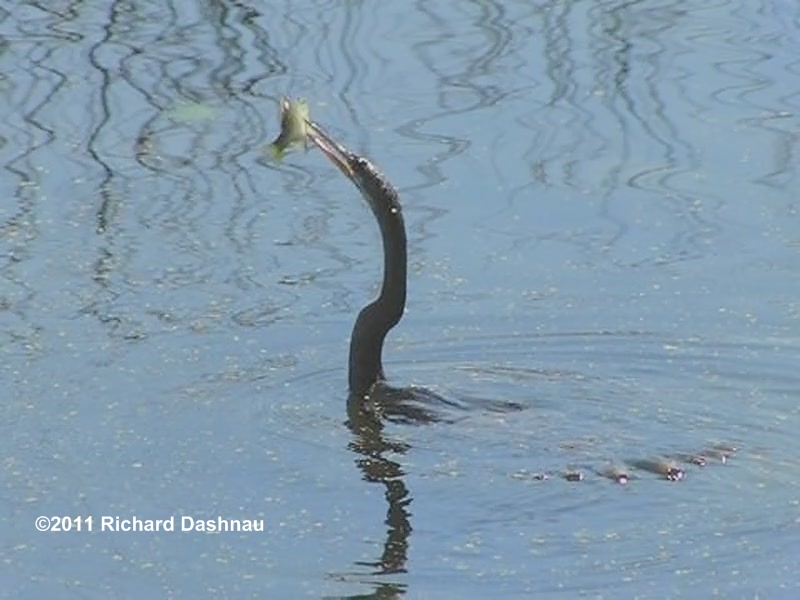
ONE
MISS AND ONE CATCH VIDEO
CLIP
(mp4)
compare with my video
clip
here (mp4)
August
26, 2012-- This
Anhinga surfaced with a very large sunfish. This was another
demonstration showing how an Anhinga deals with large
prey. Large prey or small, it has to be
freed from that sharp upper and lower mandibles. The images below
are frames from this video clip(mp4) that shows shows
how the process doesn't always succeed.
-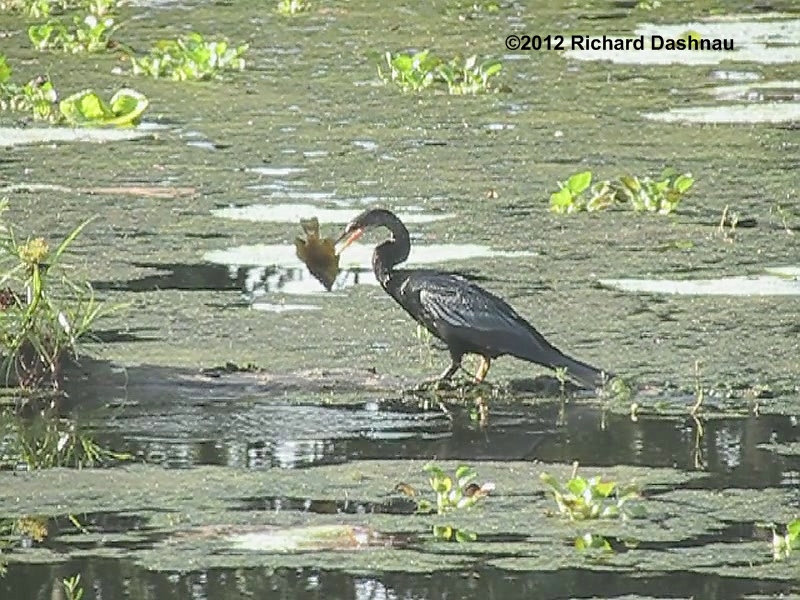 -
-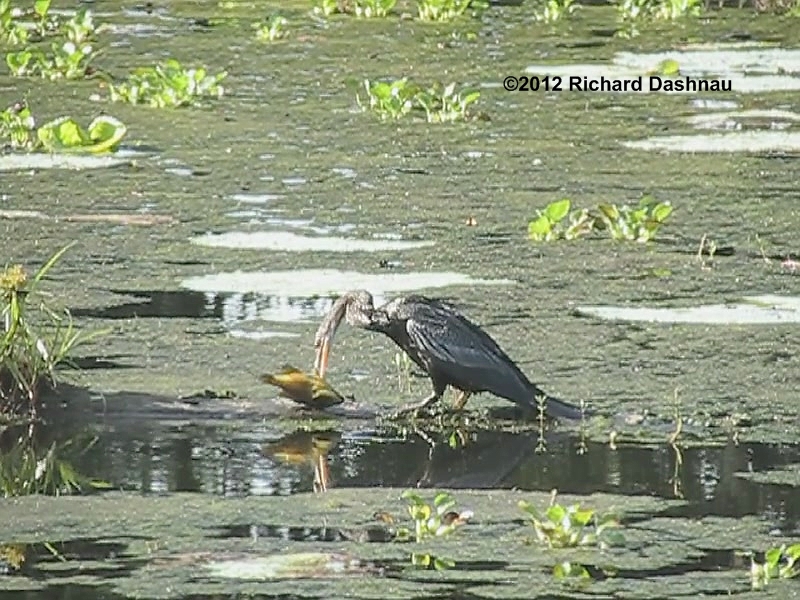 -
-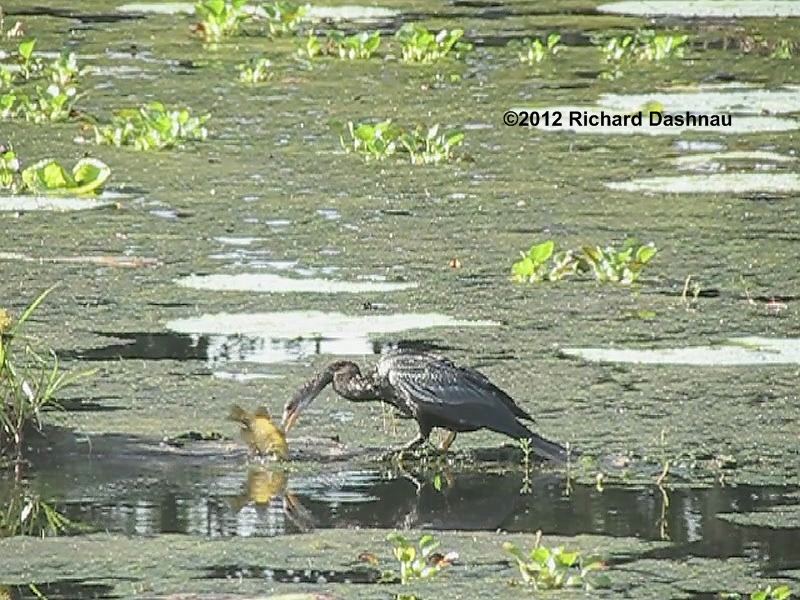 -
-
August 12, 2012-- Two weeks ago I saw an Anhinga that had
molted, and had lost its flight feathers. Last week I saw the Anhinga
as the new feathers were growing back, showing only
pin feathers. Pictures are shown lower on this page. Today, I was
found the Anhinga again at 40 Acre lake. When I first saw it, it was
standing on a log. (see anhinga_081212_01),
I was a bit disappointed that it was out so far because I wanted to
show better detail of the flight feathers growning out (anhinga_081212_02), but
I saw it dive into the water,
and thought it might be swimming towards another log near the wooden
footbridge. I watched an Anhinga jump up onto that log. It
opened its wings...and it had all of its
feathers! It was a different bird! Suddenly it flew up onto the rail
of the footbridge.
Another Anhinga surfaced, and walked up on the bank. That
was the molted Anhinga. It waddled up the bank (anhinga_081212_03),
paused, and looked up. It was watching the
Anhinga on the rail. It made a short "squat", as if it was going
to launch into the air at the higher Anhinga. There's video here(mp4) that shows what's
described below.
-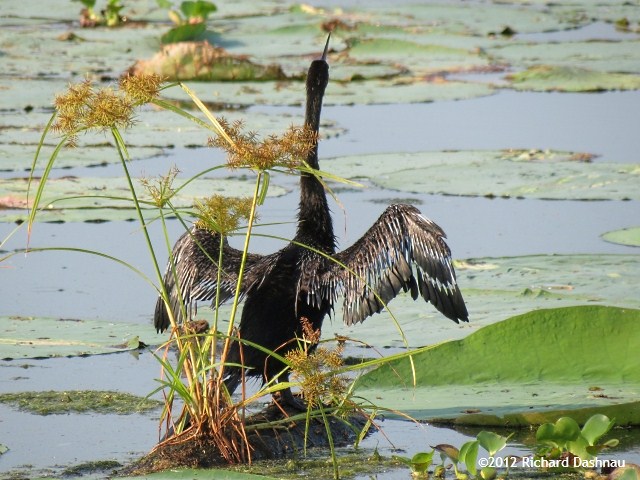 -
-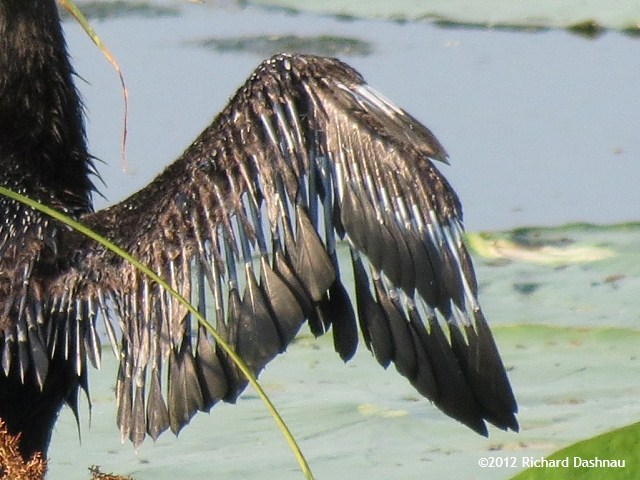 -
-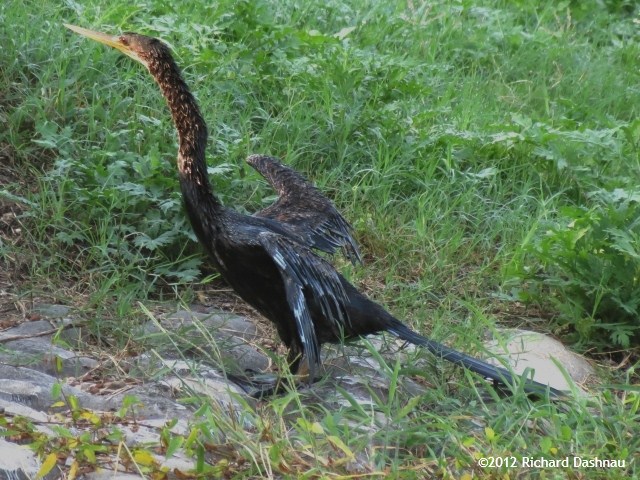 -
-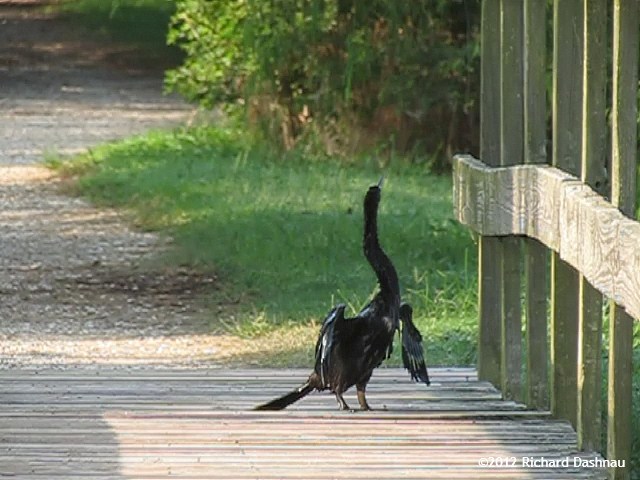
anhinga_081212_01
anhinga_081212_02
anhinga_081212_03
anhinga_081212_04
Then, it seemed to realize
it couldn't fly, and walked/hopped onto the bridge. From there, it
watched the Anhinga on the rail (anhinga_081212_04, anhinga_081212_05, anhinga_081212_06).
It prepared to take off
again (anhinga_081212_07) but it
still couldn't fly. So it jumped onto the bottom rail, and
apparently used its neck
to grab the rail as it climbed on. (anhinga_081212_08)
-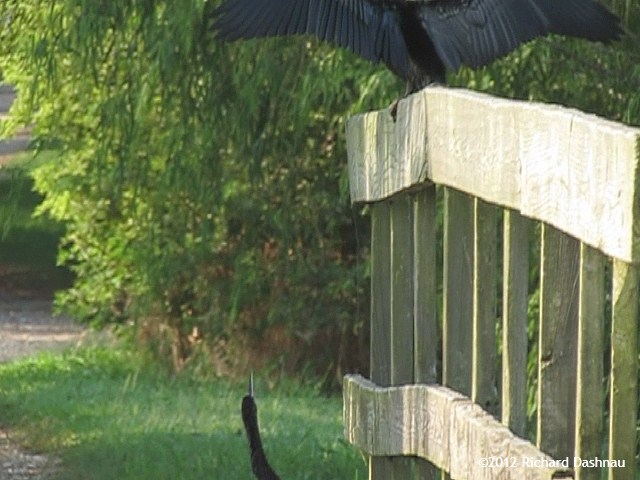 -
-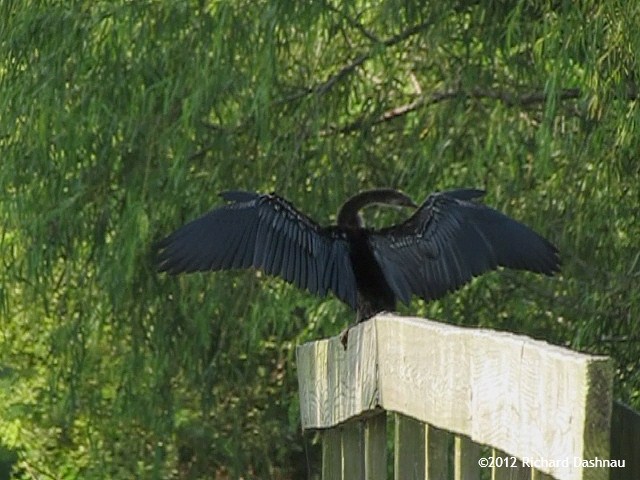 -
-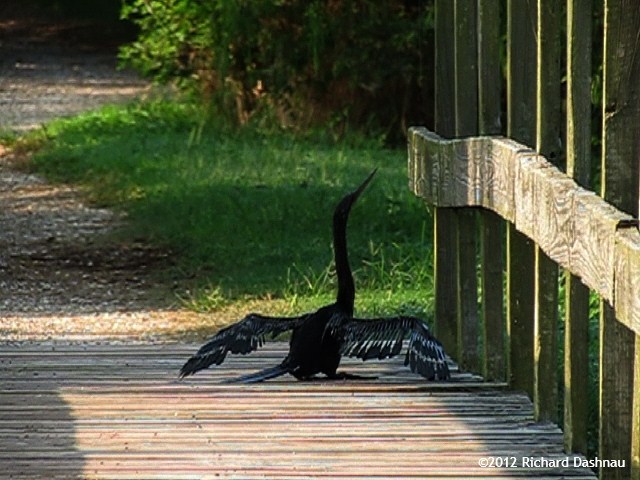 -
-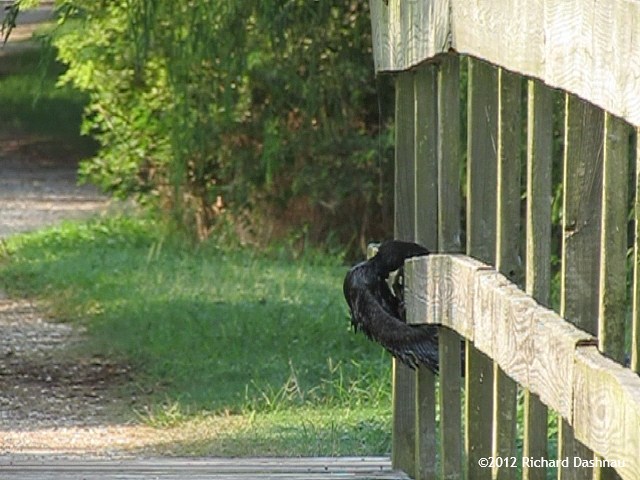
anhinga_081212_05
anhinga_081212_06
anhinga_081212_07
anhinga_081212_08
Once it got up on the rail and caught
its balance (anhinga_081212_09, anhinga_081212_10). It
shook out its tail, and that was the last straw for the other Anhinga.
It flew away. The
molted Anhinga hopped off the bridge, walked down to the lake, and
hopped in. It rested on the log, then dove in again. I went
around the trails for a while.
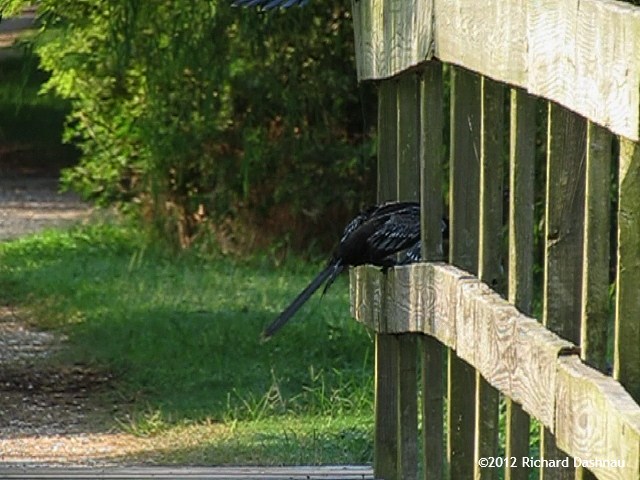 -
- -
-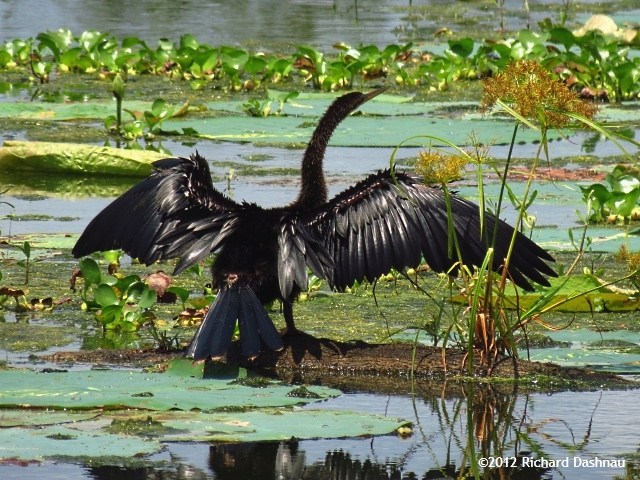 -
-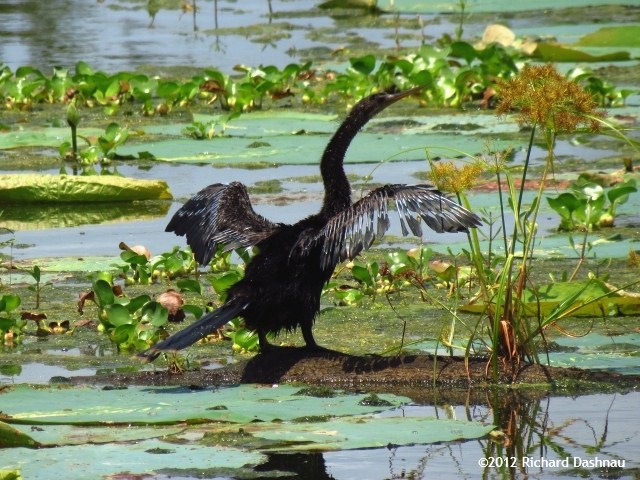
anhinga_081212_09
anhinga_081212_10
anhinga_081212_11
anhinga_081212_12
About 4 hours later, I was in the area again, hoping
to catch that Anhinga a bit closer. But, it didn't surface any closer.
I saw it out on one of the islands. Another Anhinga landed on a log
and
spread its wings (anhinga_081212_11).
It flew off, and another Anhinga surfaced near the same log. That
one must have chased off the other. When it opened its wings, I
saw that it was
the "molted" Ahinga again. It had left the island. He seemed
to be pretty pushy for a bird that couldn't fly yet. I took a few
more pictures, and cropped them to show how the feathers
are pushing out of the feather shafts. (anhinga_081212_013 and anhinga_081212_02 ). If
this is the same Anhinga I saw last week, those feathers are
growing quickly. I edited video clips
referenced in the images above together into a video that can be
seen here.
(mp4). I was impressed by the amount of activity performed
by the temporarily-flightless Anhinga. I thought it
was interesting to observe that the Anhinga seemed about to take
off, then "remembered" that it couldn't fly. It didn't waste any
effort trying to fly.
---------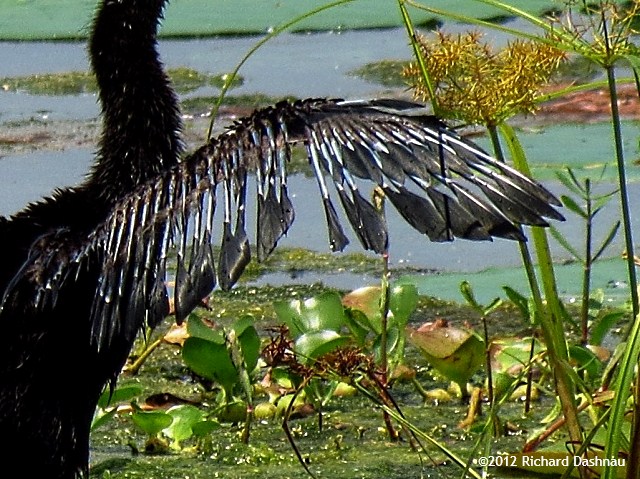
anhinga_081212_13
August 5 (and July 29) 2012-- I
was walking around 40 Acre lake with some park visitors. I'd described
some of the animals that they might see as they walked around the
lake. I had described the Anhinga, one of my favorite park
inhabitants; and of course mentioned the diving/hunting behavior, and
the wing/spreading heating behavior.
I described how beautiful the wings can be, as they are held out in
the sun. The picture below (April Anhinga), taken on April 22, 2012
shows what I described.
--------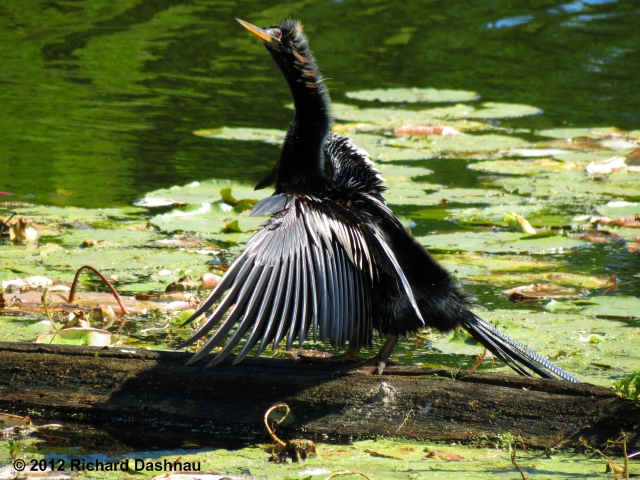
APRIL ANHINGA
A little later, we saw an Anhinga soon after it had
climbed onto a log. (Out of The Water, below) I told them to watch for
the spread wings. The Anhinga spread its wings--
--and we saw these bare arms sticking out, looking very much like
something that one might see in a chicken-wing restaurant--although
these wings did have some feathers on them.
(Boy are My Arms Tired, below)
-------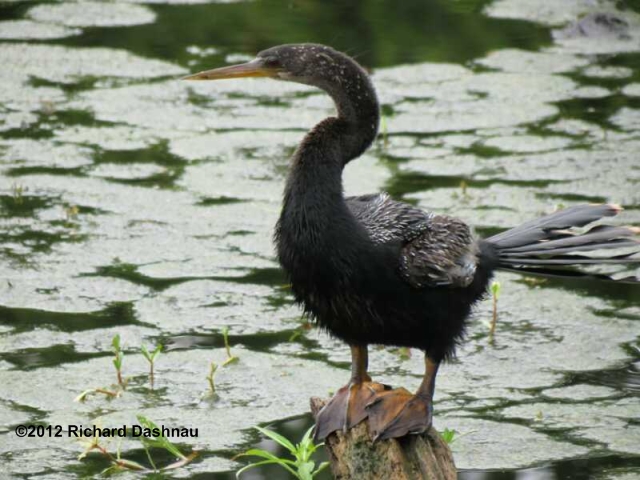 -----
-----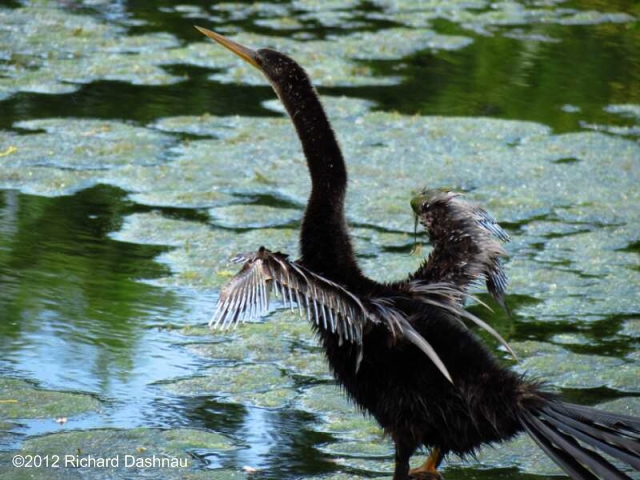 ---
---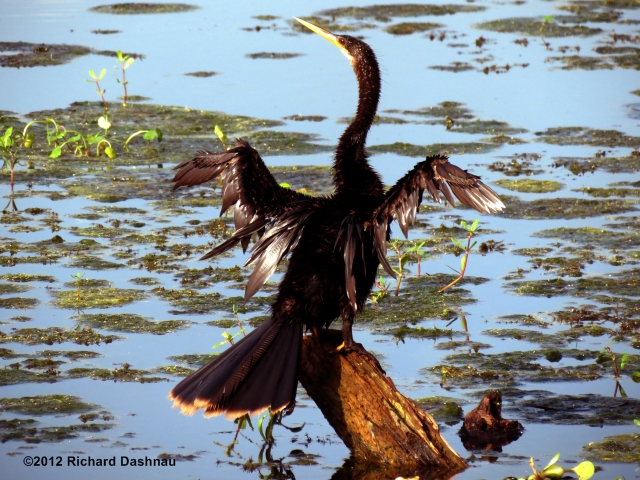
OUT OF THE WATER
...AND BOY, ARE MY ARMS
TIRED
FROM THE
WEEK BEFORE
It
figures that when I actually build up the magnificence of the Anhinga
to an audience, I get a dud. Actually, I'd seen that Anhinga, or one
in a similar state, the week before (see The Week Before,
above). I'd gotten a bit alarmed, because the Anhinga obviously can't
fly. It also looked like the feathers had been clipped off,
leaving just the stumps. However, the Anhinga seemed
unperturbed
by its condition. So, I asked around, and both David and Bill
suggested that the Anhinga had molted. Bill sent me this link ( http://slatermuseum.blogspot.com/2010/09/different-molt-strategies.html
)
which made things clearer for me. I was also able to find
more information about bird molting but relatively little specifically
about Anhingas molting. The "stumps" that I had seen on the
wings are
"pin feathers" and should soon develop into full-flight feathers. One
thing about pin feathers is that they are being supplied by blood, and
if a pin feather is broken, the bird could bleed from it.
The
picture below is a closer view of the Anhinga's bare wing. (Returning
Feathers?, below) If I was looking at the same Anhinga a week
before, then it appears that those quill (?) have grown a lot since
then.
---------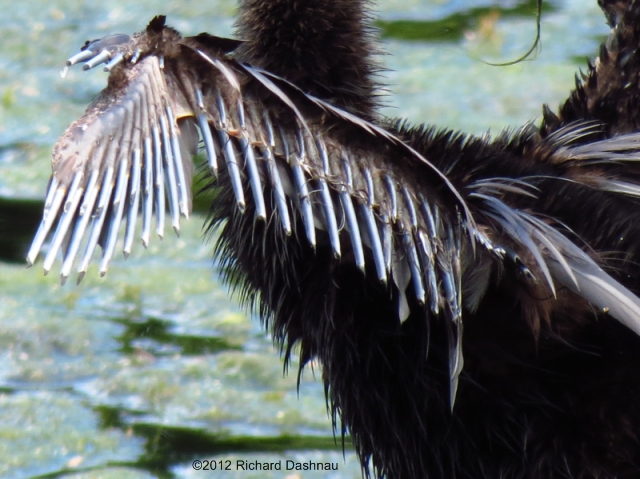
RETURNING
FEATHERS?
Barring the physical trauma, if a bird loses its wings, then of course
it can't fly. Not being able to fly can leave the bird at risk of
being eaten--since flying allows it to escape. Birds have to renew
their
feathers; which is why they molt. Feathers wear over time. To avoid
being handicapped by losing the ability to fly, many birds molt a few
flight feathers at a time; which is called "sequential" molting.
Some birds, however, are not as handicapped by not being able to fly,
because they can use alternate means to escape from predators, and
they can still find food, even if they can't fly. The Anhinga
is one of these latter type, since they care very good swimmers. They
are also very stealthy swimmers--as I have found while trying to track
them as they hunt. Anhingas can surface and submerge
silently and slowly, without leaving a ripple. So, birds like Anhingas
can shed all the feathers at once, in a "simultaneous" wing molt.
If I can, I'll try to take more pictures to see if I can show the
feathers coming back.
April
22,
2012--A
little later today, I was able to watch a Anhinga for a while (since
it was under the water often). I finally (after some years of trying)
caught an
Anhinga surfacing with a fish in a video clip. This is extremely
difficult, since I can't be sure when, or where, the Anhinga will
surface--and
it doesn't always have prey when it surfaces. The images below
are from this brief
clip (mp4).
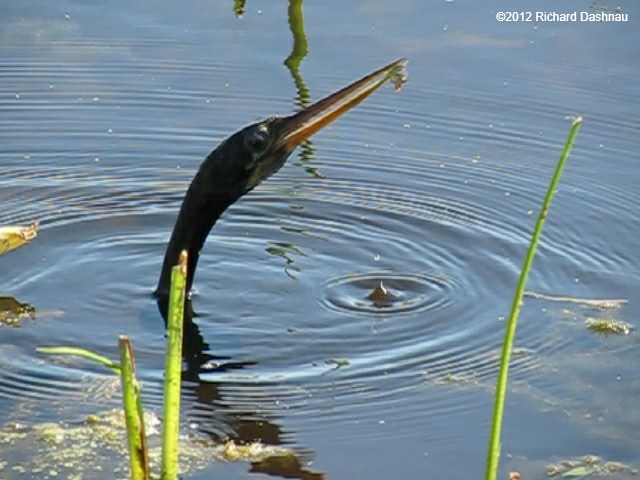 -
-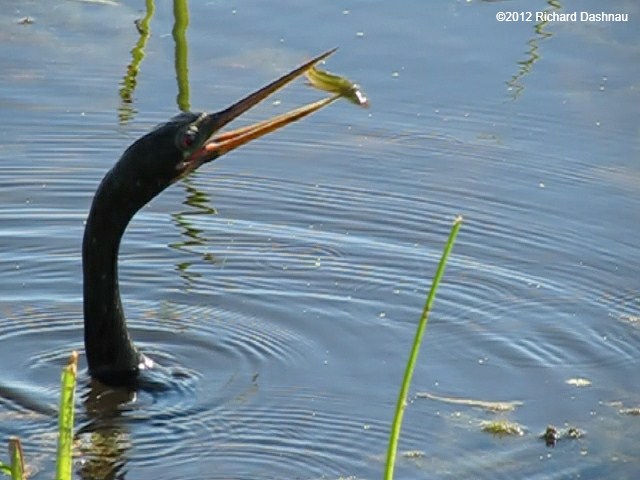 -
-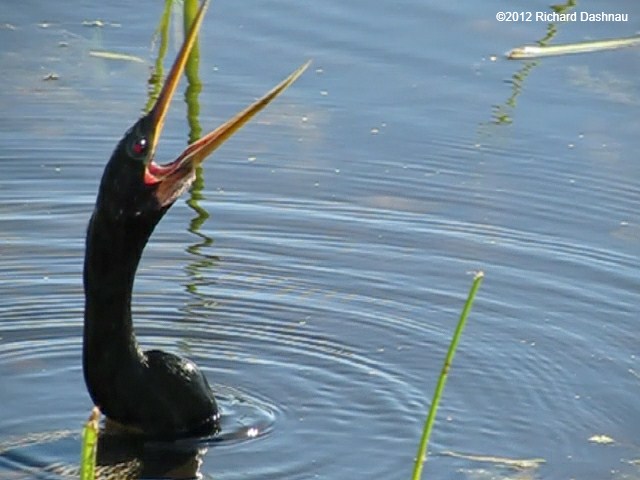 -
-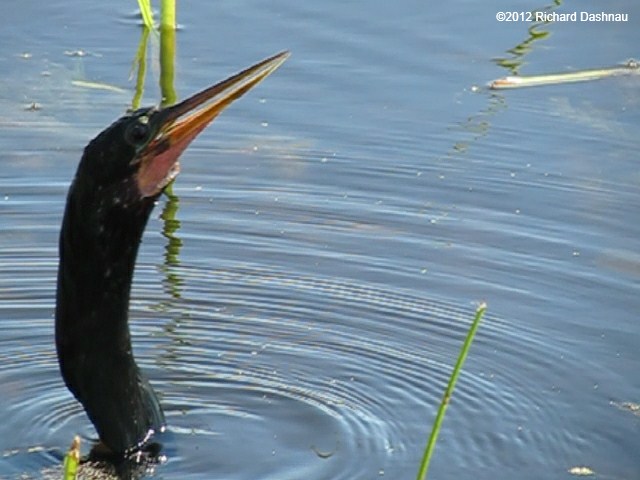
- --
--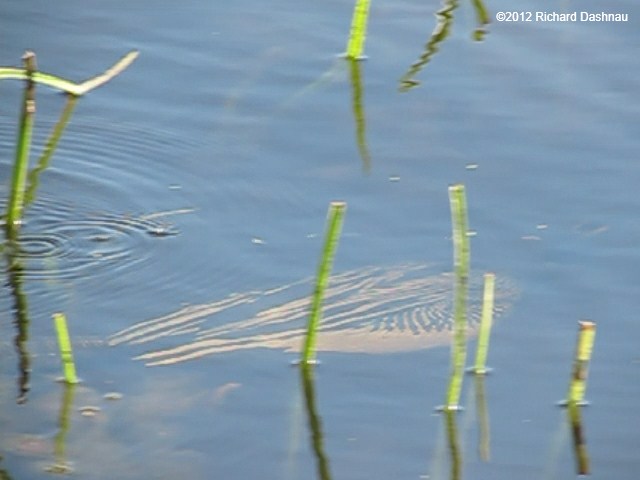
After the quick meal, the Anhinga submerged again, and I was elated to
be able to see it under the water. It swam away from me, and went out
of focus.
May 15, 2011--(new update 8/17/2016,
old story) I
watched an Anhinga foraging close to the shore in 40 Acre lake. When
it tried to perch so it could open its wings and get warm, it
was harrassed by another Anhinga. I put together an 17
minute film from the clips I shot of the Anhinga. I shot at
high speed in case I could catch the Anhinga capturing prey. I didn't.
Click the link to see the edited VIDEO
CLIP
(mp4) 17 min.
May 15, 2011--(new update, old story) Anhingas lose body heat to the water as
they swim under it. This is mostly because their feathers absorb
water, all the way to their skin. Over
time, the Anhinga's metabolism begins to speed up because the body is
cooling. Eventually, the Anhinga has to get out of the water, and
spread its wings (usually with its back towards
the sun) and absorb heat. Sometimes an Anhinga will surface and
fly to a perch. Sometimes an Anhinga will surface, and hop onto a
perch near the surface of the water. And
sometimes...an Anhinga will laboriously climb
a tree to get to a good perch. I've watched Anhingas do this many
times. Today, I shot video at 210 frames per second of one climbing
the same tree at different times. At least, I think
it was the same one on the same tree. The images below are frame grabs
from the edited VIDEO
CLIP
(mp4) that
I filmed.
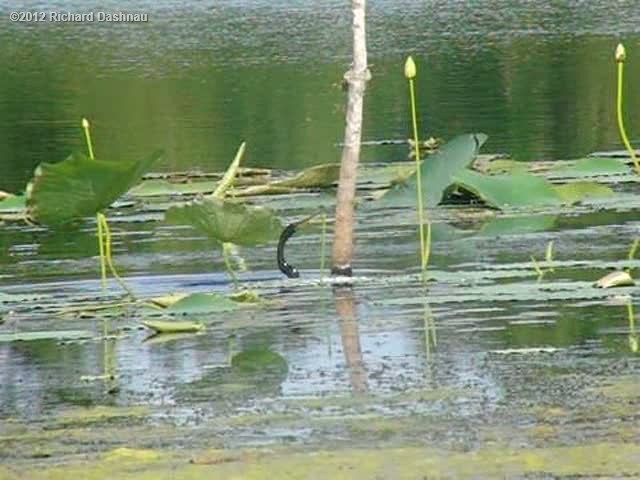 -
-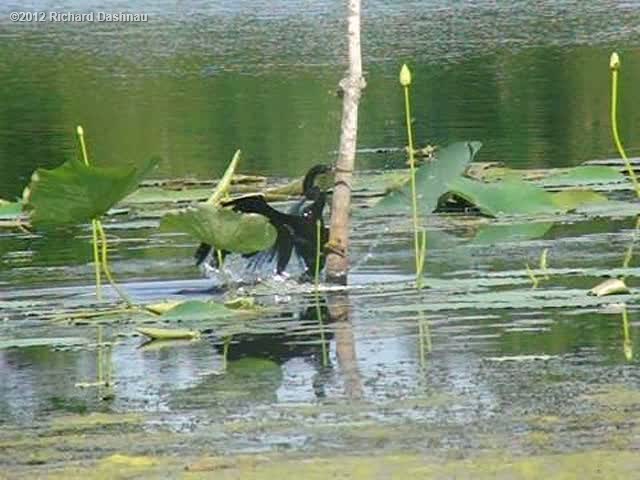 -
-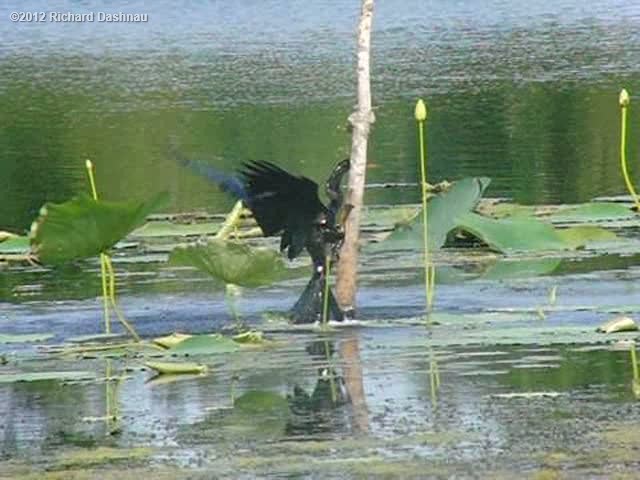 -
-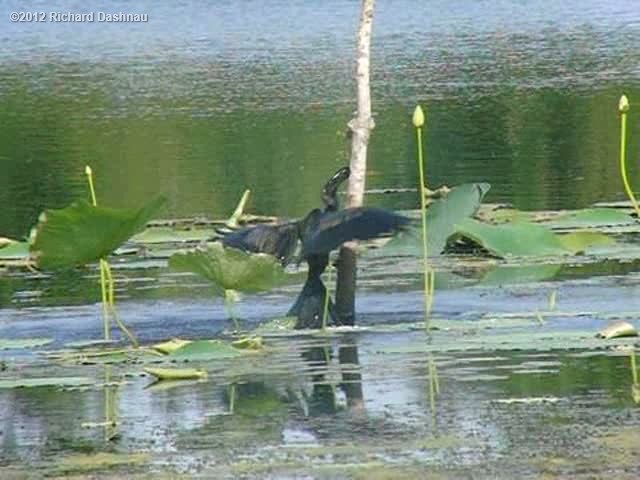
A QUICK BRACE WITH HEAD AND NECK
The
Anhinga
surfaced near the base of the tree, and then jumped out of the
water (That's some trick. You
try jumping out of water where your feet don't reach the bottom)
Then it moved up the tree
using a combination of running, toe-gripping (with webbed feet),
wing-flapping, and using its neck and head in a prehensile
fashion. It's hard to see the "neck grabbing" at normal film
speed, but
when it is slowed down, that's what seems to be happening. It was
a surprise to me to see the Anhinga use its neck that way.
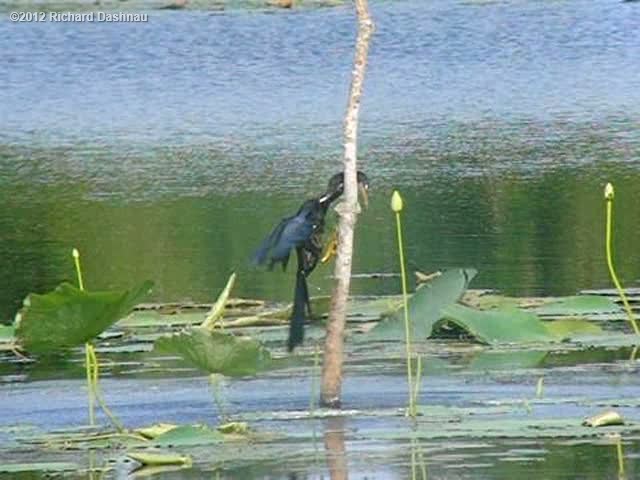 -
-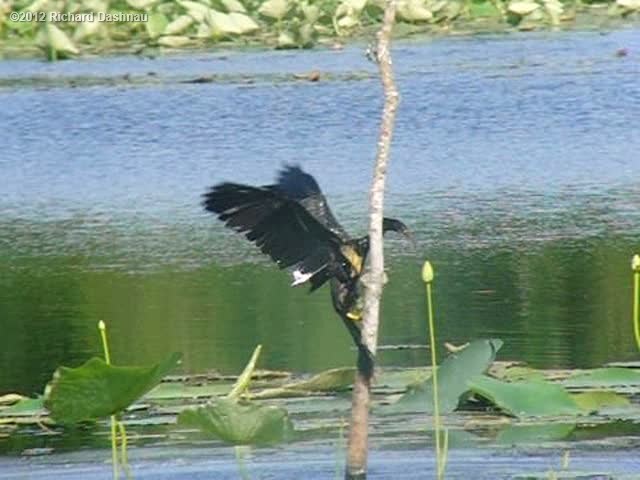 -
-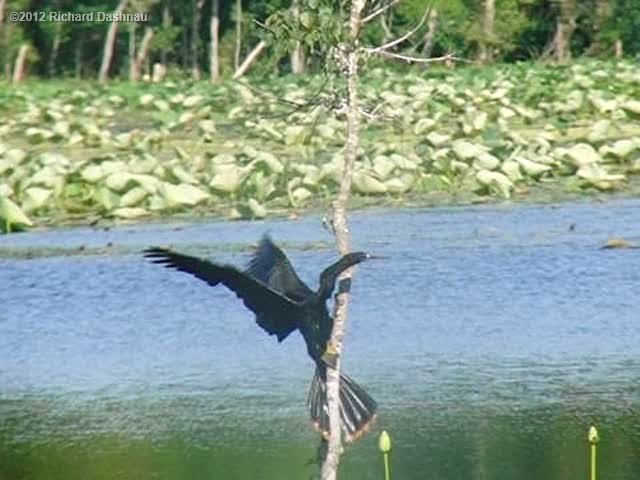 -
-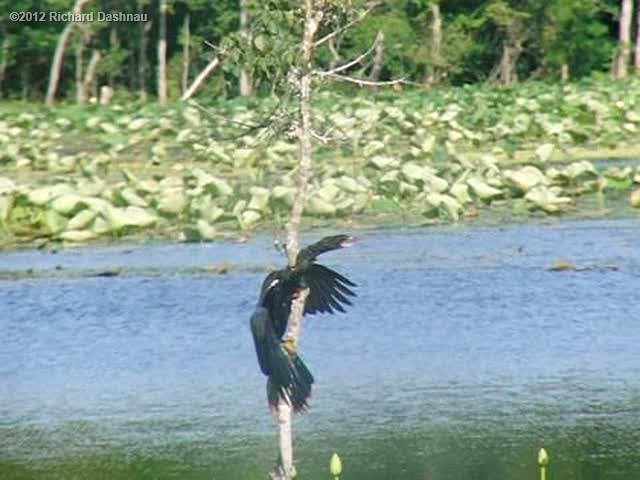
A
FULL GRAB WITH HEAD AND NECK
BRACE
WITH WING AND BACK OF THE NECK
The Anhinga also flapped its
wings as it moved up the tree, but when viewed slowed-down, the
wings seem to be moving backwards compared to when the Anhinga is
flying, or at least differently.
The wing beats seem similar to a bird "braking" as it comes down
for a landing. So it seems that the Ahinga is not flying up the
tree and just pushing with its feet (sort of like the way American
Coots
and Pied-Billed Grebes "run" across the water.) but doing
something else with its wings as it climbs. The Anhinga even
rested a few times on its way up. But, it finally made it, and
once up there, it
flapped its wings to shake the water out, and opened them to the
sun.
-------------------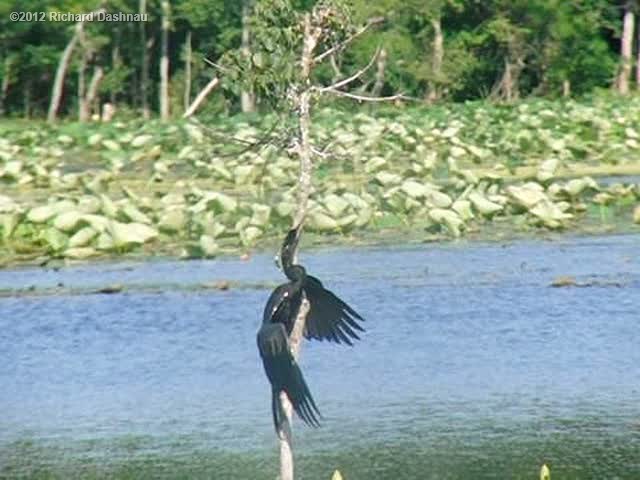 ----------
----------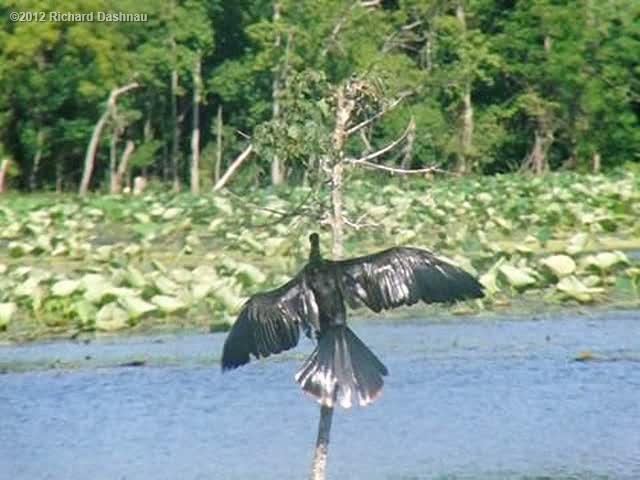 ----------
----------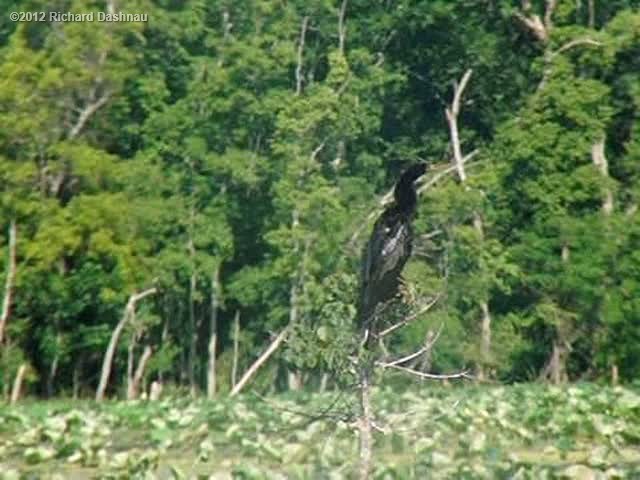
FINALLY
MADE IT TO THE TOP!
ANHINGA
CLIMBING VIDEO
CLIP
(mp4)
March
03, 2011 (some material updated 1/4/2021) I got lucky as an Anhinga was diving and
fishing fairly close to me. The Anhinga has serrations on its beak
(according to what I've
read) that help it to hold on to the fish that it catches. This is
handy while the fish is held between the jaws--but maybe not so
handy when the jaws have pierced a fish. Then, the Anhinga has to
work the fish off of one or both points of its beak. It does this
by a combination of twisting (spinning) the beak back and forth
and thrusting the beak forward and jerking it back. This is
done
with a combination of physical strength and delicacy so that when
the fish does come off the beak, it doesn't go flying off into the
water. Once the fish is held inside the beak, it gets tossed into
the air, and the Anhinga catches it on the way down. It can be a
struggle. When seen in real time it's hard to discern what is
going on. When viewed slowed down, it becomes clearer. I shot the
clips today at 210 frames per second. The images below are frame
grabs from the video clips. There are two clips of the same
Anhinga, but it has surfaced with a different fish in each clip
---------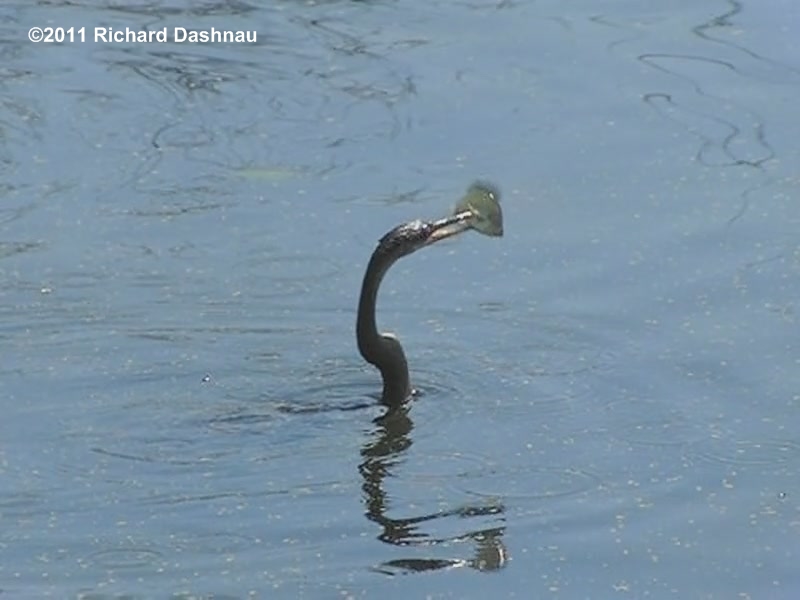 --------------
--------------
Video
clip
1 (mp4)
Video
clip 2 (mp4)
 -
-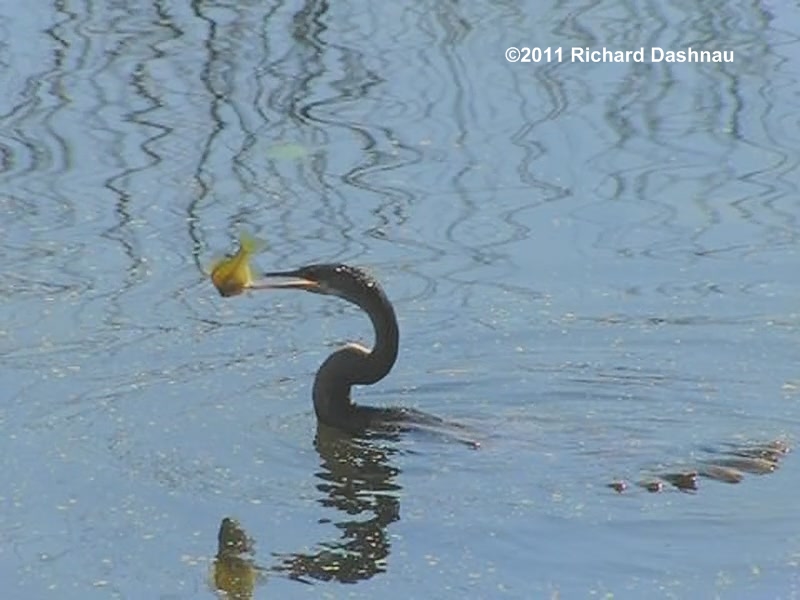 -
-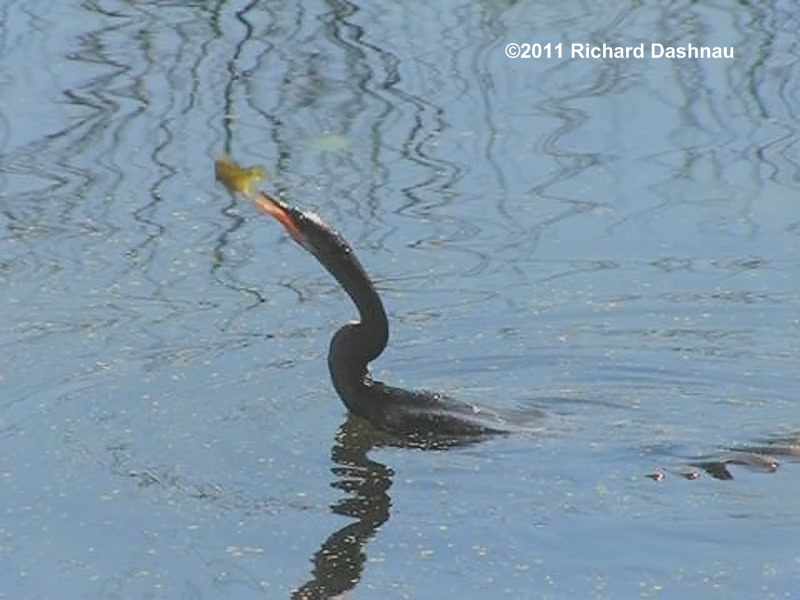 -
-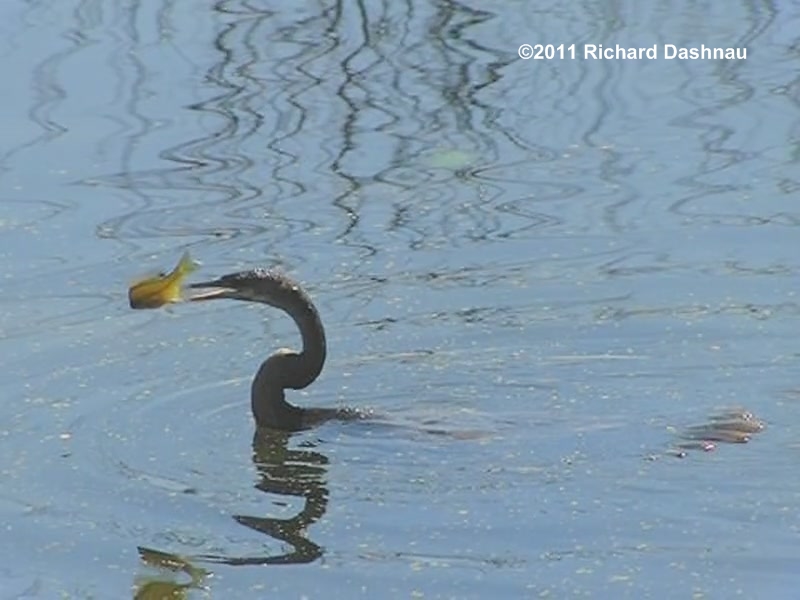
PUSH AND TUG
IT
DIDN'T COME OFF
TWIST SIDE-TO-SIDE TO LOOSEN
I THINK IT'S
LOOSE
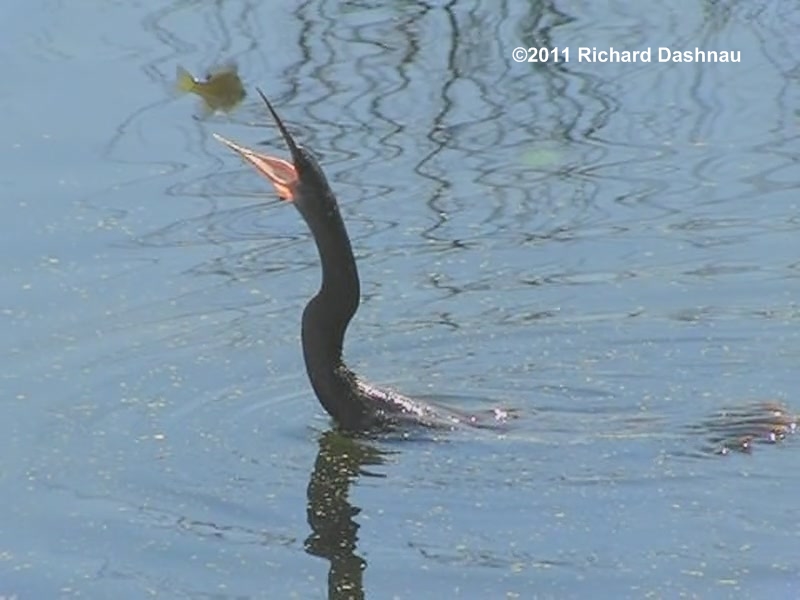 -
-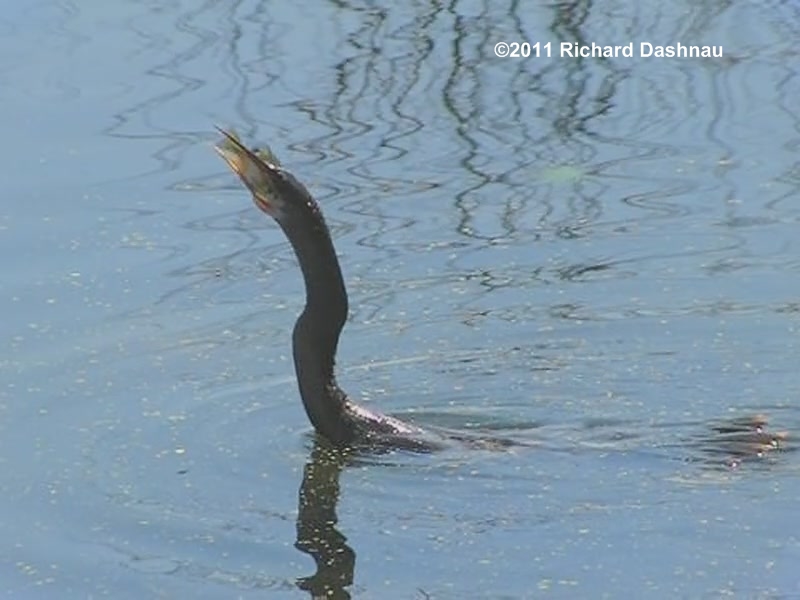 -
-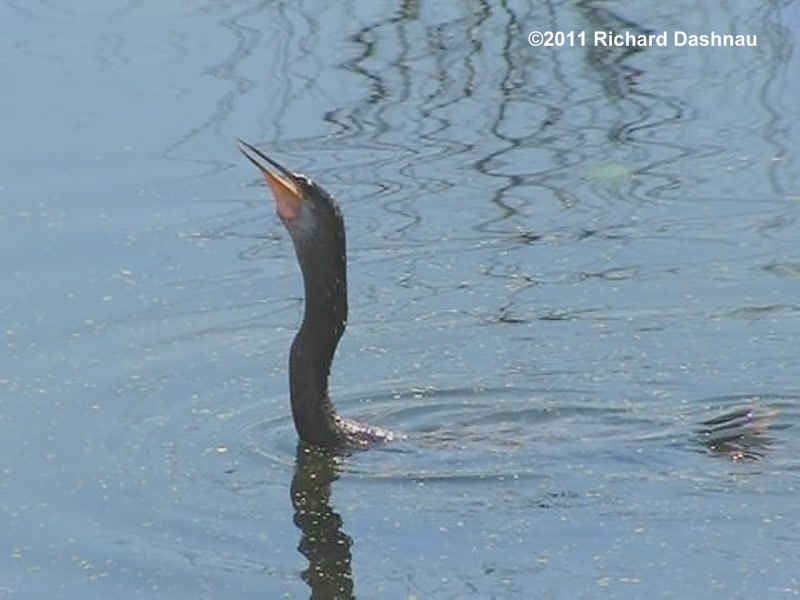 -
-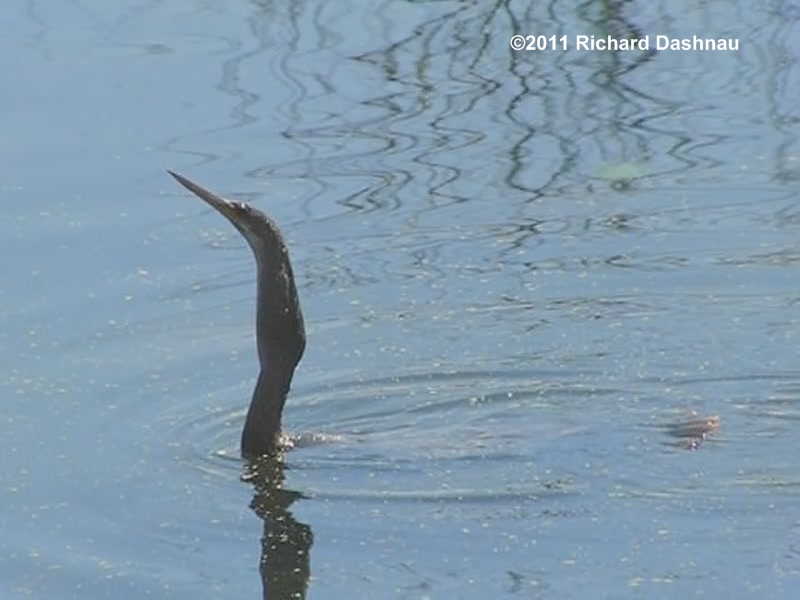
IT'S FREE! TOSS IT UP!
CATCH IT HEADFIRST
IN IT GOES
DOWN IT GOES
January
09, 2011 It was
pretty cold this weekend.
While walking around the trails in my heavy clothes, I was
surprised to see a few Anhingas diving into and leaving the cold
water. In the afternoon,
I was surprised to see the Anhinga in the RICKUBISCAM picture. It
was pretty close, and I was able to shoot some video as it jumped
into the water. I knew what to expect, but to someone who
has
never seen an Anhinga jump into the water, it's pretty surprising.
The pictures below are frame grabs from one of the video clips I
shot. Watch the video by clicking this link Ahinga
Enters
the Water (mp4)
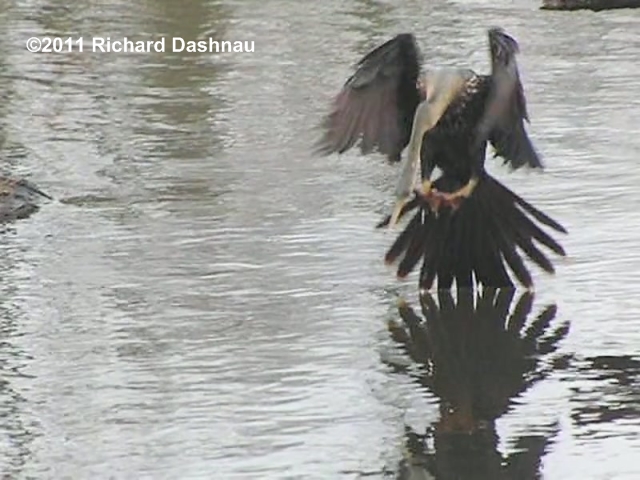

03/08/2009-- The bird called an Anhinga
is one of my favorite animals. Anhingas' feathers have
developed a bit differently than other birds' feathers to allow
water to wick into them. Water will
saturate the feathers right to the bird's skin. This helps the bird
to become neutrally buoyant. A neutrally-buoyant object will
neither sink nor float in water--but will remain at a particular
depth. This
allows the Anhinga to spend most of its energy while submerged
swimming slowly and stalking fish. Then, it spears them with its
beak, comes to the surface, shakes the fish off its beak, then
catches and swallows the fish.
------------------------------------------------------------------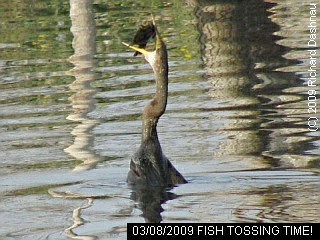
Today I got one brief look at an Ahinga as it
surfaced with a fish on its beak. I was able to shoot some
slow-motion video, and some photos. The 030809 RICKUBISCAM is a
cropped photo
of the Anhinga tossing a freshly-caught fish. I've edited together
a video using the two clips (the Anhinga is not very close and
some photos shot with the same camera. Since the image
resolution on the photos is so high, I can crop them (as in the
RICKUBISCAM shot) to show detail. So, I added some cropped photos
to the clip. You can see it by clicking on this link
(mp4).
Images from further cropping of the orginal photos can be seen
below. The last image below (FROM VIDEO CLIP) is taken from a
frame of one of the video clips.
-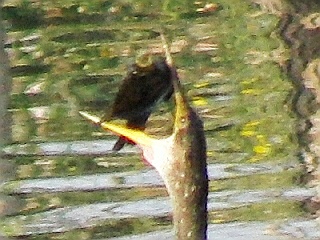 -
-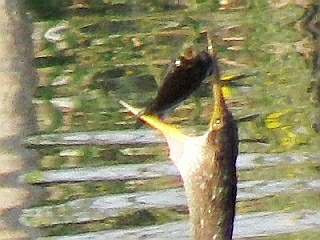 -
-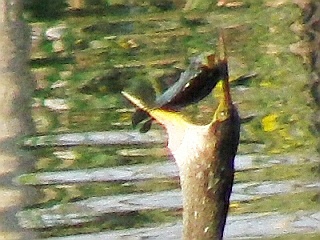 -
-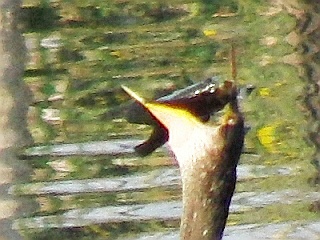
-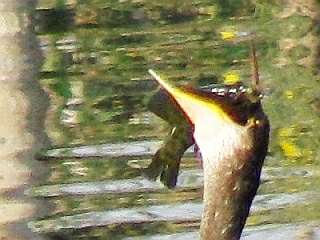 -
-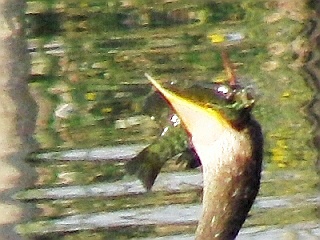 -
-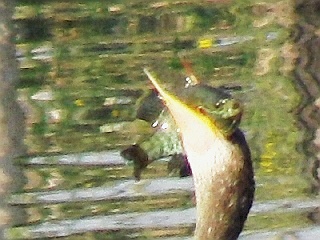 -
-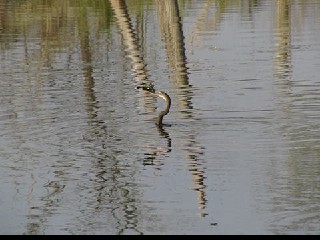
-----------------------------------------------------------------------------------------------------------------------------------------FROM
VIDEO CLIP mp4
8/31/2008-- A bit more Anhinga behavior. This
Anhinga was sunning, and then it poked the oil gland (near the base
of the tail) with its beak, then rubbed its neck and head onto the
oil gland in a motion almost like honing a knife. The
line of images below are from a video clip showing this. Links to
the clip are below the pictures.
-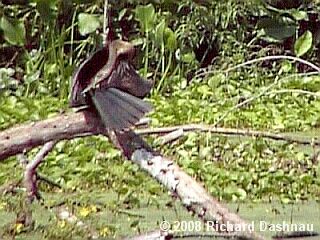 -
-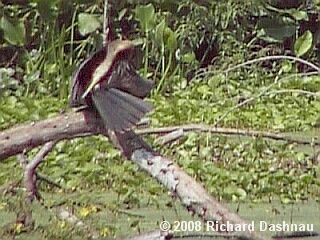 -
-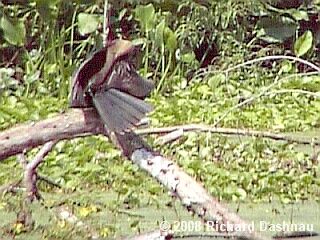
OIL
THE BOTTOM
OIL THE RIGHT
SIDE
OIL THE BOTTOM
-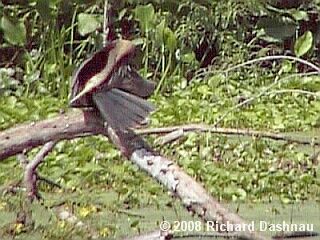 -
-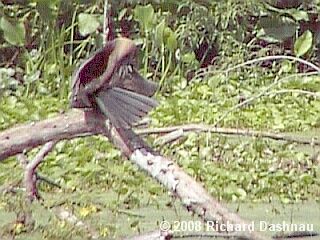 -
-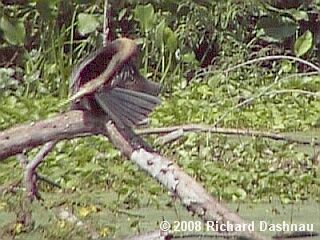
OIL THE RIGHT
SIDE
OIL THE
BOTTOM
OIL THE
RIGHT SIDE
Anhinga
Oils
its Head and Neck and Dives (mp4).
Anhinga Oils its Head and Neck slo mo(mp4).
Soon after, the Anhinga
dove off the branch and into the water. All of this can be seen by
clicking the links above. I watched the Anhinga, and tried to
catch the moment that it left the water.
I missed it by a second. The last video clip shows the Anhinga
shaking its wings free, and then it oils its head and neck, and
the preens feathers on various parts of its body. The
image
below (OUT OF THE WATER) is from this short video clip--which has
a link below the picture.
--------------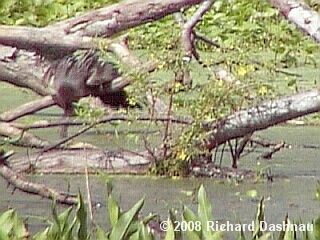 -----------------------------------------
-----------------------------------------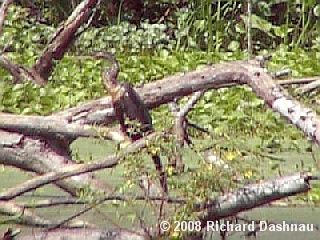
DIVING
OFF THE
BRANCH
JUST
OUT OF THE WATER
Anhinga
Opens
Wings, Oils Head and Neck and Preens (mp4).
8/24/2008--
I've been trying to see more Anhinga behavior since my last
"discovery" about their heating being related to the
wing-spreading posture. Today, I saw an Anhinga and a
Neotropic Cormorant right next to each other. Now I can show
a few comparisons between these two diving birds. Today's
RICKUBISCAM shows a single frame from a video clip showing
a Cormorant swimming. The clip will have a link further down.
I watched the Anhinga and the
Cormorant for a while. During that time, one or the other would
occasionally enter the water to fish.
After a time, the Anhinga would pop out of the water. It would
suddenly leap out of the water appear on one of the tree trunks.
The Cormorant would appear from a distance away, and leap out
of the water and fly right back to the tree shown in the images
below. The photos below (Anhinga and Cormorant, Profile, Anhinga)
are all frames from this short video clip. The clip shows
each in closer shot in the trees, then pulls back to show them at
the same time. The video shows the differences between the two
birds, especially the shape of the beak. From what I've recently
learned, the fact that the Anhinga has spread its wings while the
Cormorant has NOT isn't surprising. During the entire time I saw
both birds (at least an hour), the Cormorant did not make
the
"wing spread" posture at all. The Anhinga must use its wings as
solar collectors to heat its body; while the Cormorant may
occasionally spread its wings to hasten drying.
-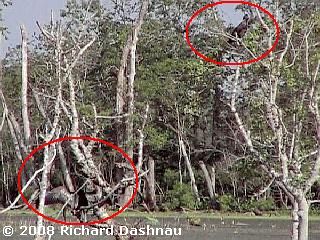 --
--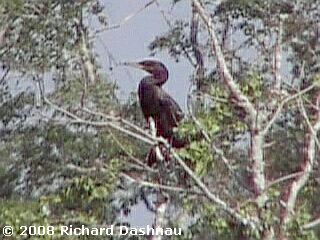 --
--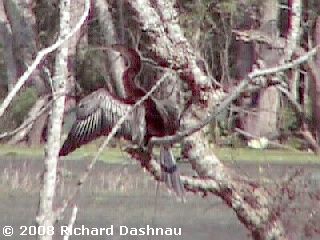
ANHINGA AND CORMORANT
THE CORMORANT PROFILE
THE
ANHINGA
Anhinga
and
Cormorant video (wmv 8.5mb).
-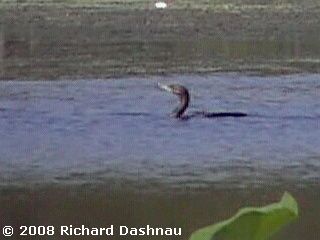 --
--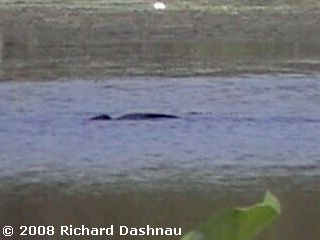
THE CORMORANT SWIMS
THE CORMORANT
LOOKS DOWN
Cormorant
swims
video (wmv 5.0mb).
I was able to capture a some short video footage of
the Cormorant swimming. The RICKUBISCAM shows one frame from this
video. Two other frames are above (Cormorant swims; Cormorant
Looks Down). The images and video clearly show how high the
Cormorant's back is above the water. The Cormorant is more buoyant
because of a layer of air that it keeps near its body. This
layer also acts as insulation against the heat-dissipation effects
of being sumberged in water. Finally, an Anhinga took off
from the tree and flew away from me, then circled back and landed
in
the water. I was able to catch part of this flight on video.
The
image
below is a frame from the video clip. The video clip shows it
entering the water. The Anhinga immediately sinks--but a
very
small part is briefly visible for a few seconds. I suspect this
is because there was still some air trapped in voids among
the feathers. Whatever the reason, once the Anhinga dives, it
remains
totally submerged except for its head and neck. In the
video, one can see why the Anhinga is sometimes called a
"snakebird".
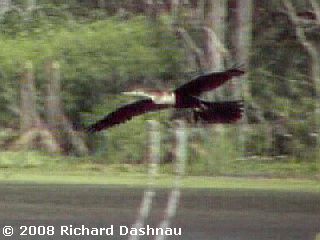
THE ANHINGA LANDING
Anhinga
lands
video (wmv 5.0mb).
7/27/2008--And I've
mentioned Anhingas before. They are quite different than most
birds found in the water. They swim totally submerged, and they
spear fish with their sharp beaks. Then the Anhinga
will surface with the fish speared, extending only the head and
neck. The Anhinga will have to dislodge the fish, usually be
shaking and jerking its head, until it's loosened. Then the
Anhinga tosses it up,
catches it, and swallows it. Anhingas are currently classified in
the same order as Pelicans. The classification goes like this:
Kingdom: Animalia
Phylum: Chordata
Subphylum: Vertebrata
Class: Aves
Order: Pelecaniformes
Family: Anhingidae
The Anhingas have been
hunting the lakes at Brazos Bend State Park much more frequently
than they had been in previous years. I was able to take some time
and watch one this Sunday. Since
the bird swims totally submerged, it's not easy to guess where it
might surface. I set up my video camera, and just waited. Whenever I
saw movement, I'd turn on the camera and swing it towards
what I saw. I got lucky a few times, and thought visitors might like
to see an Anhinga at work. Pictures here are frame captures from my
video. Today's RICKUBISCAM is from a photo I shot of the
same bird. A few things happened before the Anhinga got
to the position in that photo.
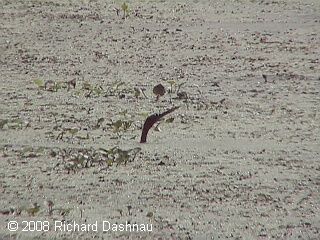 -
-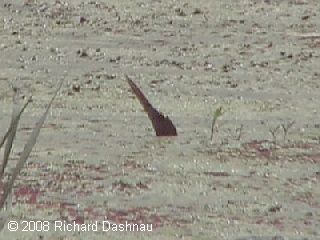 -
-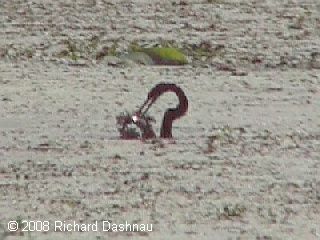 -
-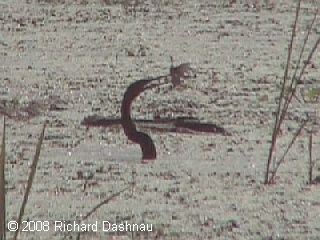
CLIP ONE
SUBMERGE
CLIP
THREE SUBMERGE
WEEDS!
D'OH!
SPEARED, AND TOSSED
submerge
1
vid(wmv 428kb).
submerge 3 vid(wmv 342kb).
weeds
video
(wmv 944kb).
eating
fish
video (wmv 2.7mb).
eating
fish
slowmo video (wmv 4.6mb).
The Anhinga's head popped
up a few times. The funny thing is, the head is often visible just
enough to catch my attention from the corner of my eye. However,
when I turn towards the movement,
the bird has submerged, and then I wonder if I saw anything at all!
See image above (CLIP ONE SUBMERGE) and the clip. Watch closely,
because the Anhinga goes under quickly! Here's
another video clip, submerge
video
2 (wmv 881kb). . Watch over to
the right, and the dark object poking from the water becomes a
bird's head! And then it's gone. See how easy it would be
to miss? The next image above (CLIP THREE SUBMERGE) shows another
really quick view of the Anhinga's head. For these clips, stop
them when they are playing, and restart them again.
The head submerges really quickly and the lag while the
video is loading will hide it. Now, while the Anhinga is swimming underwater like a
submarine, it swims slowly, stalking--and then uses
its beak to spear fish. Then the bird surfaces--at least its head
and neck do. The next image above (WEEDS! D'OH!) and the
video clip shows the Anhinga with a speared fish...but it's
entangled
in the weeds. I believe I saw at least one successful spearing and
toss before I was able to capture one on video.
The last picture above
(SPEARED AND TOSSED) with video shows a successful
surface and toss. The link below also shows the same toss in
slow-motion. The
Anhinga swam back towards me, so I finally had the sun off to my
side. It surfaced and submerged in clearer
water--
submerge 4 vid(wmv 342kb).
I thought that the Anhinga
might be leaving the water, but I picked the wrong perching object
to film, so I missed it when it popped out. However, the first
four images below show the Anhinga
as it changes from a sleek, glistening animal that can move
through water with no disturbance to a beautiful winged flying
creature. The images just don't show this amazing transformation
correctly. Watch the video clip--
anhinga coverts vid(mp4) I believe the brown (in the sun it looks like
copper to me) colors on the back of the wings show that this is an
immature bird.
-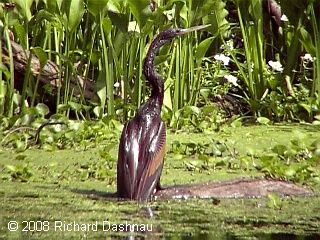 -
-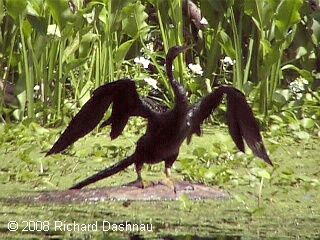 -
-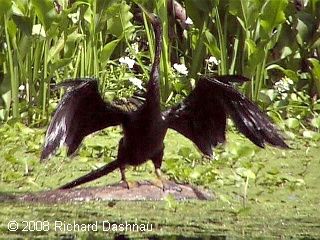
BEAUTIFUL UNDERWATER
BIRD
I CAN'T FLY
LIKE THIS!
BEGIN TRANSFORMATION
-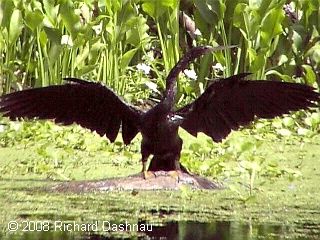 -
-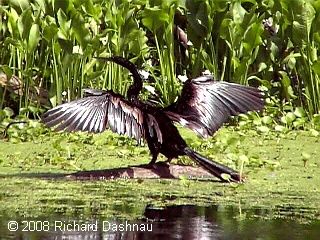 -
-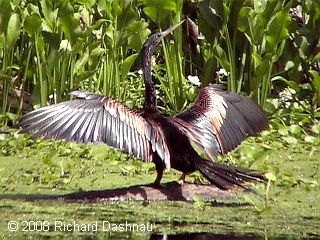
WINGS ARE RESTORED
TURN THE BACK TO THE SUN
ALMOST DRY NOW
Common wisdom seems to be that Anhingas have no oil
in their feathers and that this means that the feathers don't
repel water. Therefore, the feathers absorb water. After
some comments
emailed to me indicating that Anhingas do have an oil
gland (thanks, Chuck), I investigated a bit more. None of my books
mention much, and most spots on the internet repeat the same "no
oil"
story. However, I finally found two links that make some
very interesting statements. ( audubon.org
; science
mcmaster)
Oil, or the lack of oil, has
less to do with the feathers absorbant quality than the physical
structure of the feathers. The feathers have developed so that
they absorb water. This makes it easier
for the Anhinga to remain submerged, but it also means that the
Anhinga can lose heat to the water. The Anhinga's metabolic rate
is slower than that of other birds. That is why the Anhinga
stands
there with its wings open; it can absorb heat from the sun if it
needs to. A secondary function of the spread wings may be to
signal successful feeding. This would allow other Anhingas to
recognise
good hunting grounds. According to one study (sited in the links I
mentioned above), drying the wings isn't necessary for flight
since the bird would only gain 1% to 3% of its body weight when
saturated.
So...there's a lot more going
on here than just a bird spreading its wings to dry them.
The last picture above
(ALMOST DRY NOW) is also from this video clip--
anhinga coverts vid(mp4) show
the
Anhinga after a little time has passed. The wings have become full
and very attractive. While watching the video clips, did you notice how
supple the Anhinga's neck was? A common name for the Anhinga is
"Snake Bird". It's
surprising
how complex some apparently simple activities really are.
UPDATE 08/05/2008--I
have found two more useful links. One is a physiological
comparison between our Anhinga (Anhinga Anhinga) and the
Double-Crested Cormorant (Phalacrococrax auritus)
--Adaptations For Locomotion and Feeding in the Anhinga and the
Double-Crested Cormorant, by Oscar T. Owre. Cormorants are birds
that look very similar to Anhingas, and which share similar
behaviors.
The paper can be found here.
The other is a paper that addresses the risks of generalizing
similar behaviors between two species--AMER. ZOOL., 28:845-851
(1988)--Energetics
and Spread-winged
Behavior in Anhingas and Double-crested Cormorants: The Risks of
Generalization by WlLLARD W. HENNEMANN III. That paper can be found for
purchase here.
I've paraphrased from notes
from the second paper below.
The wettable feathers of
Anhingas and the Double-Crested Cormorant is not due to a lacking
or malfunctioning preen gland, but is an adaptation for an
underwater method of hunting. The
structure of the feathers is such that the feathers don't repel
water, but allow water to wick into them. The Anhinga feathers
allow water to penetrate to the skin; while the only the outer
parts
of the Cormorant feathers get saturated. Cormorants maintain
air insulation near the skin. This also makes Cormorants
more bouyant than Anhingas. This saturation allows Anhingas to become
neutrally bouyant. This allows the Anhinga to remain
underwater without having to expend energy to keep from floating
or sinking. This allows them to stalk prey underwater instead of
actively
chasing prey as Cormorants apparently do (since Cormorants
have to continually swim against the tendency to float).
(Page 846)
Anhingas use spread-wing
behavior to increase the surface area available to absorb solar
energy for regulation of its metabolism. Anhingas have been
observed doing this more often when they
are dry than when wet; and usually stand with their back to
the sun, maintaining a posture that keeps the surface of the back
90 degrees relative to the path of direct sunlight. Anhingas
spread
their wings to enhance the drying of their feathers to
shorten the amount of time that they lose body heat to
evaporation and reduce the time necessary to restore the air
insulation in the feathers;
and to support metabolism when it is dry. (Page 850)
While sunning themselves,
the metabolic rate of the Ahinga eventually slows--and so does the
rate of oxygen consumption. (Page 847) As much as 38%
compared to their metabolic rates without
the sunning. (Page 848)
When Cormorants used
spread-wing behavior, it was only after they had been dunked in
water, and sometimes even without any simulated radiation. Then
they'd spread their wings for very short
periods, and there was no effect on their metabolic rate.
The body temperature did rise, however. It seems that Double
Breasted Cormorants store this heat without effecting their
metabolism. (page 848.)
Cormorants might use spread-wing behavior only for
drying, to quickly restore their full insulation. Overall, the
spread wing behavior has little effect on the energy expended by
Cormorants. Page 849
I haven't read this anywhere yet, but it seems that
this "stockpiled" heat, which is further preserved by the
insulation of air near the Cormorant, would allow the Cormorant to
maintain a constant
metabolic rate throughout all activities, whether submerged or
not. See?
Sunbathing and diving is more complicated than I thought.
Update 8/15/2008-- A short summary of how the
Anhinga's plumage becomes wet (as described above), and the use of
the wing-spreading behavior for thermoregulation can also be found
in
The Sibley Guide to Bird Life and Behavior (National Audubon
Society; 1st Edition, printed 2002; page 166.) (Thanks to Sharon
for mentioning this.)
January 16, 2005 It was a little cool today at the park. As I entered
the Elm Lake trail, I saw an Anhinga in one of the large puddles
(or small ponds). Although I've read that Anhingas might be seen
year 'round at the park, I don't see them very often over the
winter. When I do see them, I rarely get close enough to get a
good view. The image below (WET, WILD, AND COOL) shows that the
one
I found didn't seem shy at all. I think these are fine looking
birds, and enjoy seeing them. The scientific name for this bird is
fairly easy to remember--it's Anhinga Anhinga.
The Anhinga feeds
by
swimming with its body submerged, and using its pointed beak (see
ANHINGA FACE, below), to spear fish. It doesn't swim very fast,
and therefore is said to hunt "slower-moving" prey.
-------------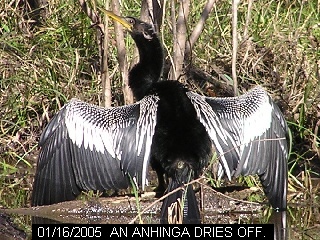 -----------
-----------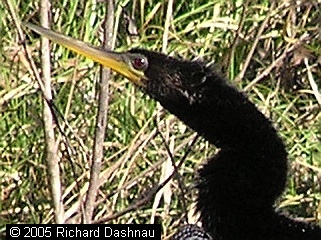
WET,
WILD, AND COOL
ANHINGA FACE
While it is swimming, the
Anhinga will sometimes raise its head above water, like a sinuous
periscope. The head is very flexible, and seems to bend in any
direction. One of the nicknames for the
Anhinga is "snake bird" and if you've ever seen an Anhinga's head
poke out from among some aquatic vegetation, you'd know why. I
took a few pictures of this bird, and went further on. I returned
about 30 minutes later, and saw the Anhinga hunting. This is
something else I usually don't get to see closely, and I was able
to take a few pictures. It swam by a number of times,
circling around
the puddle.(see NESSIE COMES TO VISIT,below)-
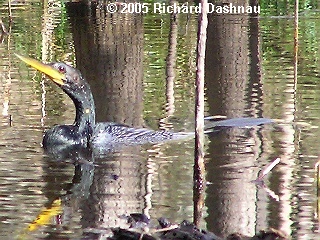 --
--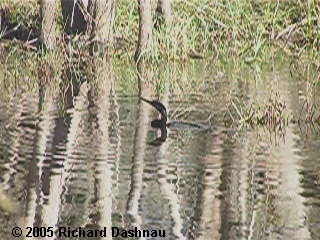 --
--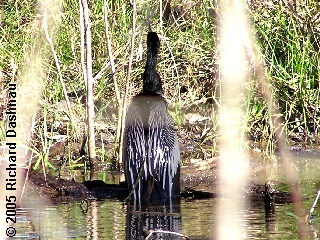 --
--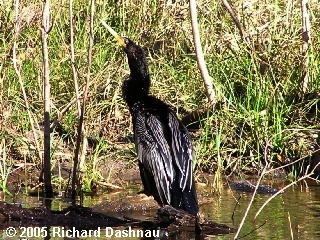 -
-
NESSIE COMES TO VISIT
LEAVING
THE WATER
MAN,
I'M SOAKED!
Anhingas absorb water into their feathers, which
helps them remain submerged. Unfortunately,
this has another effect. The water will cause the bird
to lose heat, since there is no insulation from
the soaked
feathers. So, from time to time, the Anhinga has to come out
of the water and warm up. This Anhinga went right back to the log
I'd originally seen it on (while swimming under the
water!)
and climbed out (see
LEAVING THE WATER, above). It paused briefly (see MAN, I'M SOAKED,
above). The air was a bit cool, and I felt sorry for the Anhinga
as I felt the breeze on me and saw its
soaked body and wings.
Then it slowly and
majestically opened its wings to catch the sun and warm itself.
(see the images below). While I can understand that it can
increase surface area
(solar absorption area)
by opening its wings, I think it's odd that a large part of the
wing surface is white, which is reflective. Wouldn't energy
absorption be more efficient if the wings were entirely black?
I was very happy I got to
see this.
-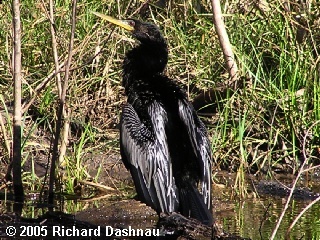 --
--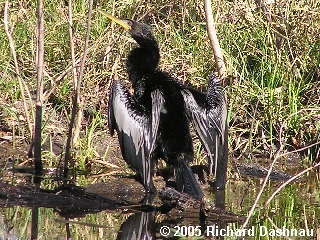 --
--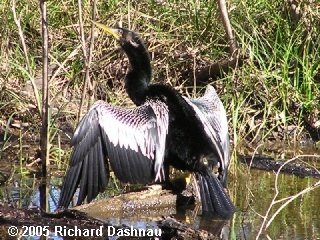 --
--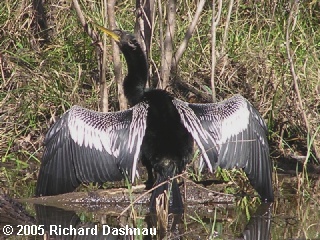
DANG, IT'S
COLD!
HEAVY
WINGS
WHAT
A SIGHT!
FROM
BEHIND
June 02, 2003The second time I
ever went to Brazos Bend State Park, I was walking near Elm Lake
when I glimpsed something dark splash into the water from a log. I
couldn't see what it was, and
continued walking. As I
moved down the trail, from time to time I'd catch a view of
something out of the corner of my eye. This "something" would
surface, and appeared almost reptilian...like a snake
or a longnecked turtle.
However, every time I'd focus both eyes (or a camera) on it, it
would disappear before I could get a clear view. This..."thing"
seemed to be following me.
-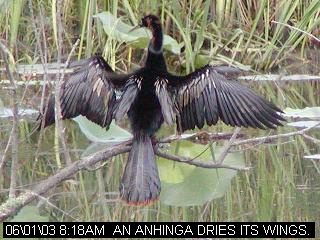
DRYING ITS WINGS
It
took
a
year, during which I began working at the park, to find out that what I'd
seen was an Anhinga; sometimes known as a "snake bird" because of its
habit of sinuously twisting its neck around. This bird
hunts fish underwater, spearing them with it's needle beak (see CLOSEUP,
below). Occasionally, the Anhinga's head will emerge from the water
like a periscope; and conjures a mental image of the Loch
Ness Monster (well, to *me*). Once, some park visitors were watching what
they thought was a snake from one of the fishing piers. When I saw what
they were looking at, and identified it as an Anhinga--a
BIRD--they didn't believe me at first. From time to time, the bird will be
seen perched above the water, with its wings spread as shown (see DRYING
ITS WINGS, above; also FROM THE SIDE, below). This
is to dry its feathers, which have no oils in them. All of these habits
are similar to a similar bird called a Cormorant. The Anhinga has a beak
like a needle, the Cormorant has a broader beak with a slight
hook at the end. Also, the Anhinga has a very distinctive triangular tail
visible while in flight.
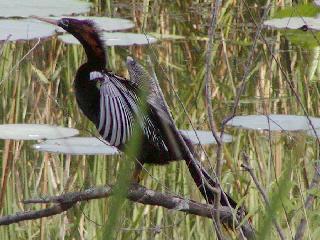 -
-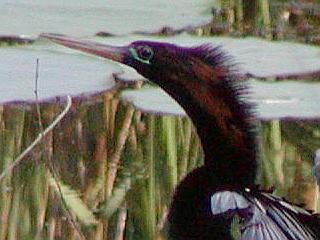
AGAIN FROM
THE SIDE.
CLOSE UP
Go back to my home page, Welcome
to rickubis.com
Go back to the RICKUBISCAM
page.
Go back to the See
the World page.

























































 -
- -
- -
-
 -
- -
- -
-
 -
- -
-
 -
- -
- -
-
 -
- -
-
 -
- -
- -
-
 -
- -
- -
-
 ----------
----------
 -
- -
- -
-
 -
- -
- -
-
 -
- -
- -
-
 -
- -
- -
-


 -----
----- ---
---

 -
- -
- -
-
 --
--
 -
- -
- -
-
 -
- -
- -
-
 ----------
---------- ----------
----------
 --------------
--------------
 -
- -
- -
-
 -
- -
- -
-




 -
- -
-
 -
- -
-
 -----------------------------------------
-----------------------------------------
 --
-- --
--
 --
--

 -
- -
- -
-
 -
- -
-
 -
- -
-
 -----------
-----------
 --
-- --
-- --
-- -
-  --
-- --
-- --
--

 -
-